Kyocera SCP-8600 Dual-Band CDMA Phone User Manual Sprint Basic Guide E73
Kyocera Corporation Dual-Band CDMA Phone Sprint Basic Guide E73
Kyocera >
Contents
- 1. User Manual
- 2. Users Manual
User Manual

©2010 Sprint. SPRINT and the logo are trademarks of Sprint.
Other marks are the property of their respective owners.
“SANYO” is a registered trademark of SANYO Electric Co.,
Ltd. and is used under license. KYOCERA is a registered
trademark of Kyocera Corporation. Kyocera manufactures
and markets the SANYO line of wireless products.
www.sprint.com
Basics Guide
SANYO ZioTM

Consejo: Para encontrar esta guía para usuarios en español,
por favor visita a www.sprint.com y haz clic en
Support > Devices.
To find this basics guide in Spanish, please visit
www.sprint.com and click Support > Devices.
Important Privacy Message – Sprint’s policies often do not
apply to third-party applications. Third-party applications may
access your personal information or require Sprint to disclose
your customer information to the third-party application
provider. To find out how a third-party application will collect,
access, use, or disclose your personal information, check the
application provider’s policies, which can usually be found on
their website. If you aren’t comfortable with the third-party
application’s policies, don’t use the application.

Table of Contents
Introduction . . . . . . . . . . . . . . . . . . . . . . . . . . . . . . . i
Your Device’s Menu . . . . . . . . . . . . . . . . . . . . . . . . i
Section 1: Getting Started . . . . . . . . . . . . . . . . . 1
1A. Setting Up Service . . . . . . . . . . . . . . . . . . . 2
Setting Up Your Device . . . . . . . . . . . . . . . . . . . . . . 2
Activating Your Device . . . . . . . . . . . . . . . . . . . . . . 3
Setting Up Your Voicemail . . . . . . . . . . . . . . . . . . . 4
Sprint Account Passwords . . . . . . . . . . . . . . . . . . . 5
Getting Help . . . . . . . . . . . . . . . . . . . . . . . . . . . . . . . 5
Section 2: Your Device . . . . . . . . . . . . . . . . . . . . 7
2A. Device Basics . . . . . . . . . . . . . . . . . . . . . . . 8
Your Device . . . . . . . . . . . . . . . . . . . . . . . . . . . . . . . . 8
Viewing the Display Screen . . . . . . . . . . . . . . . . . 10
Turning Your Device On and Off . . . . . . . . . . . . . 13
Battery and Charger . . . . . . . . . . . . . . . . . . . . . . . 14
Navigating Through the Menus . . . . . . . . . . . . . . 16
Screen Overview . . . . . . . . . . . . . . . . . . . . . . . . . . 18
Displaying Your Phone Number . . . . . . . . . . . . . 24
Making and Answering Calls . . . . . . . . . . . . . . . 24
Entering Text . . . . . . . . . . . . . . . . . . . . . . . . . . . . . . 31
2B. Settings . . . . . . . . . . . . . . . . . . . . . . . . . . . . 35
Sound Settings . . . . . . . . . . . . . . . . . . . . . . . . . . . 35
Display Settings . . . . . . . . . . . . . . . . . . . . . . . . . . . 37
Location Settings . . . . . . . . . . . . . . . . . . . . . . . . . . 39
Synchronizing Accounts . . . . . . . . . . . . . . . . . . . 40
Search Settings . . . . . . . . . . . . . . . . . . . . . . . . . . . 42
Messaging Settings . . . . . . . . . . . . . . . . . . . . . . . 43
Airplane Mode . . . . . . . . . . . . . . . . . . . . . . . . . . . . 44
TTY Use With Sprint Service . . . . . . . . . . . . . . . . 44
Using the Hearing Aid Device Compatibility
Function . . . . . . . . . . . . . . . . . . . . . . . . . . . . . . . . . 46
Security Settings . . . . . . . . . . . . . . . . . . . . . . . . . . 46
Application Settings . . . . . . . . . . . . . . . . . . . . . . . 48
Privacy Settings . . . . . . . . . . . . . . . . . . . . . . . . . . . 50
Accessibility Settings . . . . . . . . . . . . . . . . . . . . . . 50
2C. Call Log . . . . . . . . . . . . . . . . . . . . . . . . . . . . 51
Viewing the Call Log . . . . . . . . . . . . . . . . . . . . . . 51
Call Log Options . . . . . . . . . . . . . . . . . . . . . . . . . . 52
Tip: Looking for something? If you don’t see it in the headings
listed here, try the Index on page 139.
Making a Call From the Call Log . . . . . . . . . . . . 52
Saving a Number From the Call Log . . . . . . . . . 52
Erasing the Call Log . . . . . . . . . . . . . . . . . . . . . . . 53
2D. Contacts . . . . . . . . . . . . . . . . . . . . . . . . . . . 54
Displaying the Contacts List . . . . . . . . . . . . . . . . 54
Adding a New Contacts Entry . . . . . . . . . . . . . . 54
Contacts Entry Options . . . . . . . . . . . . . . . . . . . . 55
Editing a Contacts Entry . . . . . . . . . . . . . . . . . . . 56
Assigning a Ringer Type for an Entry . . . . . . . . 56
Assigning a Picture to an Entry . . . . . . . . . . . . . 56
Finding Contacts Entries . . . . . . . . . . . . . . . . . . . . 57
Deleting Entries . . . . . . . . . . . . . . . . . . . . . . . . . . . . 57
Adding Entries to Your Favorites . . . . . . . . . . . . . 57
2E. Calendar & Tools . . . . . . . . . . . . . . . . . . . . 58
Calendar . . . . . . . . . . . . . . . . . . . . . . . . . . . . . . . . 58
Alarm Clock . . . . . . . . . . . . . . . . . . . . . . . . . . . . . . . 61
Calculator . . . . . . . . . . . . . . . . . . . . . . . . . . . . . . . . 63
Updating Your Device . . . . . . . . . . . . . . . . . . . . . 63
2F. Voice Services . . . . . . . . . . . . . . . . . . . . . . 64
Automatic Speech Recognition (ASR) . . . . . . . 64
Text-to-Speech . . . . . . . . . . . . . . . . . . . . . . . . . . . 65
2G. microSD Card . . . . . . . . . . . . . . . . . . . . . . 66
Your Device’s microSD Card and Adapter . . . . 66
microSD Card Settings . . . . . . . . . . . . . . . . . . . . . 68
Connecting Your Device to Your Computer . . . 68
Important Connection Information . . . . . . . . . . . 69
2H. Camera . . . . . . . . . . . . . . . . . . . . . . . . . . . . . 71
Taking Pictures . . . . . . . . . . . . . . . . . . . . . . . . . . . . 71
Recording Videos . . . . . . . . . . . . . . . . . . . . . . . . . 74
Opening Gallery . . . . . . . . . . . . . . . . . . . . . . . . . . 76
2I. Bluetooth . . . . . . . . . . . . . . . . . . . . . . . . . . 77
Turning Bluetooth On and Off . . . . . . . . . . . . . . . 77
Using the Bluetooth Settings Menu . . . . . . . . . . 78
Pairing Bluetooth Devices . . . . . . . . . . . . . . . . . . 78
Section 3: Sprint Service . . . . . . . . . . . . . . . . . 81
3A. Sprint Service: The Basics . . . . . . . . . . 82
Voicemail . . . . . . . . . . . . . . . . . . . . . . . . . . . . . . . . . 82
Messaging . . . . . . . . . . . . . . . . . . . . . . . . . . . . . . . 85
Caller ID . . . . . . . . . . . . . . . . . . . . . . . . . . . . . . . . . . 87
Call Waiting . . . . . . . . . . . . . . . . . . . . . . . . . . . . . . . 88
Making a 3-Way Call . . . . . . . . . . . . . . . . . . . . . . . 88
Call Forwarding . . . . . . . . . . . . . . . . . . . . . . . . . . . 88
Roaming . . . . . . . . . . . . . . . . . . . . . . . . . . . . . . . . . 89
3B. Web and Data Services . . . . . . . . . . . . . . 92
Getting Started With Data Services . . . . . . . . . . 92
Wi-Fi . . . . . . . . . . . . . . . . . . . . . . . . . . . . . . . . . . . . . 98
Email . . . . . . . . . . . . . . . . . . . . . . . . . . . . . . . . . . . 100
Gmail . . . . . . . . . . . . . . . . . . . . . . . . . . . . . . . . . . . 101
Using Google Talk . . . . . . . . . . . . . . . . . . . . . . . . 104
Using the Android Market . . . . . . . . . . . . . . . . . 107
Creating a Google Account . . . . . . . . . . . . . . . . 110
Sprint Zone . . . . . . . . . . . . . . . . . . . . . . . . . . . . . . 111
3C. Entertainment: TV and Music . . . . . . . 112
TV . . . . . . . . . . . . . . . . . . . . . . . . . . . . . . . . . . . . . . 112
Music . . . . . . . . . . . . . . . . . . . . . . . . . . . . . . . . . . . 114
Streaming Music . . . . . . . . . . . . . . . . . . . . . . . . . 117
YouTube . . . . . . . . . . . . . . . . . . . . . . . . . . . . . . . . . 117
3D. GPS Navigation . . . . . . . . . . . . . . . . . . . . 119
GPS Services . . . . . . . . . . . . . . . . . . . . . . . . . . . . 119
Sprint Navigation . . . . . . . . . . . . . . . . . . . . . . . . . 119
Google Maps . . . . . . . . . . . . . . . . . . . . . . . . . . . . 120
Section 4: Safety and Warranty
Information . . . . . . . . . . . . . . . . . . . . . . . . . . . . . 123
4A. Important Safety Information . . . . . . . . 124
General Precautions . . . . . . . . . . . . . . . . . . . . . . 124
Maintaining Safe Use of and Access to Your
Device . . . . . . . . . . . . . . . . . . . . . . . . . . . . . . . . . . 125
Using Your Device With a Hearing Aid
Device . . . . . . . . . . . . . . . . . . . . . . . . . . . . . . . . . . 126
Caring for the Battery . . . . . . . . . . . . . . . . . . . . . 128
Radio Frequency (RF) Energy . . . . . . . . . . . . . 128
Owner’s Record . . . . . . . . . . . . . . . . . . . . . . . . . . 131
User Guide Proprietary Notice . . . . . . . . . . . . . 131
4B. Manufacturer’s Warranty . . . . . . . . . . . . 132
Manufacturer’s Warranty . . . . . . . . . . . . . . . . . . 132
4C. End User License Agreement . . . . . . . 135
End User License Agreement . . . . . . . . . . . . . . 135
Index. . . . . . . . . . . . . . . . . . . . . . . . . . . . . . . . . . . 139
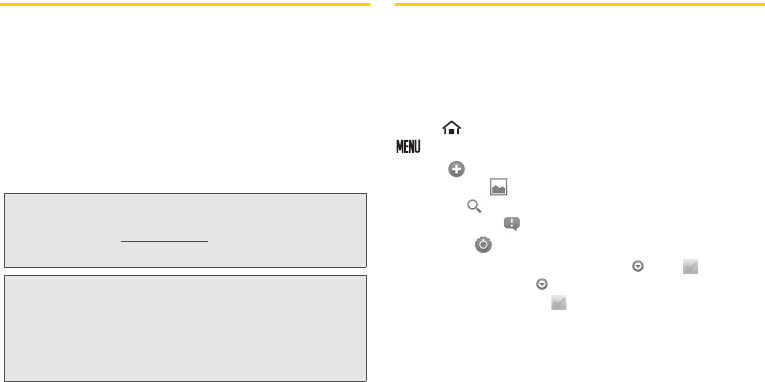
i
Introduction
This Basics Guide introduces you to Sprint® service and
all the features of your new device. It’s divided into four
sections:
ࡗSection 1: Getting Started
ࡗSection 2: Your Device
ࡗSection 3: Sprint Service
ࡗSection 4: Safety and Warranty Information
Your Device’s Menu
The following table outlines your device’s main menu
structure. For more information about using your
device’s menus, see “Navigating Through the Menus”
on page 16.
Touch to display the Home screen and then touch
to open the following menus:
ⅷAdd ()
ⅷWallpaper ()
ⅷSearch ()
ⅷNotifications ()
ⅷSettings ()
In the Settings menu, you may see and adjacent
to a list entry. Touch to reveal additional options
(“sub-options”). Touch to enable or disable the
feature. A green check mark indicates the feature is
enabled.
Note: Because of updates in device software, this printed
guide may not be the most current version for your
device. Visit www.sprint.com and sign on to My Sprint
to access the most recent version of the user guide.
WARNING: Please refer to the Important Safety Information
section on page 124 to learn about information
that will help you safely use your device. Failure
to read and follow the Important Safety
Information in this guide may result in serious
bodily injury, death, or property damage.
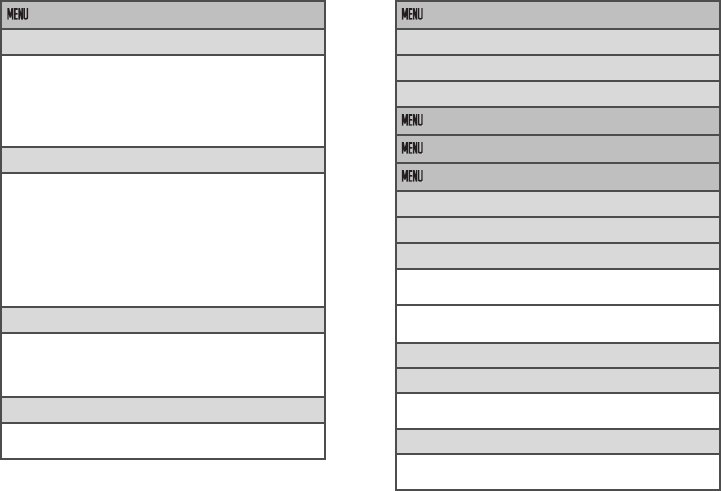
ii
> Add
1: Shortcuts
1: Applications 2: Bookmark
3: Contact 4: Direct dial
5: Direct message 6: Directions & Navigation
7: Exchange Email 8: Gmail label
9: Latitude 10: Music playlist
11: Settings
2: Widgets
1: Analog clock 2: Calendar
3: Exchange Email - Calendar
4: Exchange Email - Email
5: Exchange Email - Tasks
6: Exchange Email - Universal
7: Latitude 8: Music
9: Picture frame 10: Power Control
11: Search 12: Voicemail
13: YouTube
3: Folders
1: New folder 2: All contacts
3: All Emails 4:
Bluetooth received
5:
Contacts with phone numbers
6: Starred contacts
4: Wallpapers
1: Gallery 2: Pack Wallpapers
3: Wallpaper gallery
> Wallpaper
1: Gallery
2: Pack Wallpapers
3: Wallpaper gallery
> Search
> Notifications
> Settings > Wireless & networks
1: Airplane mode (On/Off)
2: Wi-Fi (On/Off)
3: Wi-Fi settings
1: Wi-Fi (On/Off) 2: Network notification (On/Off)
3: Add WPS network
Wi-Fi networks:
1: Add Wi-Fi network
4: Bluetooth (On/Off)
5: Bluetooth settings
1: Bluetooth (On/Off) 2: Device name
3: Discoverable (On/Off) 4: Scan for devices
6: Mobile networks
1: Data roaming (On/Off) 2: Data roaming guard
3: System select

iii
> Settings > Call settings
1: Voicemail
2: Call guard (On/Off)
3: System select
1: Sprint only 2: Automatic
4: DDTM mode (On/Off)
5: TTY mode
1: TTY Off 2: TTY Full
3: TTY HCO 4: TTY VCO
6: Voice Privacy (On/Off)
> Settings > Sound & display
Sound settings:
1: Silent mode (On/Off)
2: Ringer volume
1: Use incoming call volume for notifications
3: Media volume
4: Phone ringtone
1: Preloaded ringtones 2: User added ringtones
5: Phone vibrate (On/Off)
6: Notification ringtone
7: Audible touch tones (On/Off)
8: Audible selection (On/Off)
9: Haptic feedback (On/Off)
10: SD card notifications (On/Off)
11: Hearing Aid (On/Off)
Display settings:
1: Orientation (On/Off)
2: Animation
3: Brightness
4: Key Backlight (On/Off)
5: Auto backlight (On/Off)
6: Screen timeout

iv
> Settings > Location & security
My Location:
1: Use wireless networks (On/Off)
2: Use GPS satellites (On/Off)
Screen unlock pattern:
1: Set unlock pattern/Change unlock pattern
2: Require pattern (On/Off)
3: Use visible pattern (On/Off)
4: Use tactile feedback (On/Off)
Passwords:
1: Visible passwords (On/Off)
Credential storage:
1: Use secure credentials (On/Off)
2: Install from SD card
3: Set password
4: Clear storage
> Settings > Applications
1: Unknown sources (On/Off)
2: Manage applications
3: Running services
4: Development
1: USB debugging (On/Off) 2: Stay awake (On/Off)
3: Allow mock locations (On/Off)
> Settings > Accounts & sync
General sync settings:
1: Background data (On/Off)
2: Auto-sync (On/Off)
> Settings > Privacy
Location:
1: Use My Location (On/Off)
Settings:
1: Back up my settings (On/Off)
Personal data:
1: Factory data reset
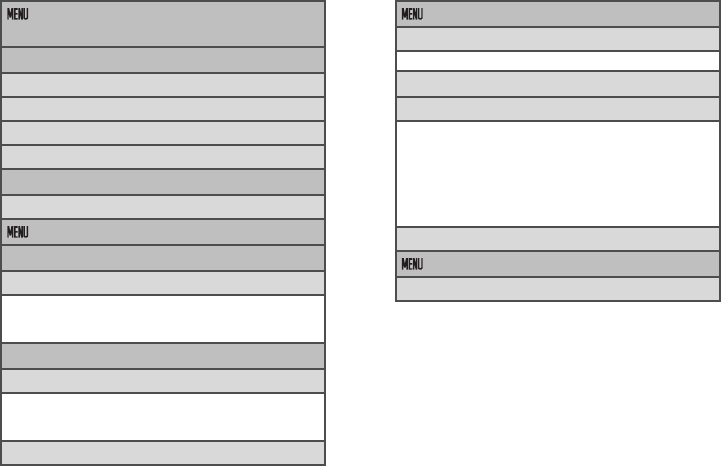
v
> Settings > SD card, USB Mass
Storage & phone storage
SD card:
1: Total space
2: Available space
3: Unmount SD card
4: Format SD card
Internal phone storage:
1: Available space
> Settings > Search
Web search:
1: Google search settings
1: Show web suggestions (On/Off)
2: Search history (On/Off)
3: Manage search history
Quick Search Box:
1: Searchable items
1: Browser (On/Off) 2: Contacts (On/Off)
3: Apps (On/Off) 4: Music (On/Off)
5: Voicemail (On/Off)
2: Clear search shortcuts
> Settings > Language & keyboard
1: Select locale
1: English 2: Español
Text settings:
1: Android keyboard
1: Vibrate on keypress (On/Off)
2: Sound on keypress (On/Off)
3: Auto-capitalization (On/Off)
Word suggestion settings:
1: Quick fixes (On/Off)
2: Show suggestions (On/Off)
3: Auto-complete (On/Off)
2: User dictionary
> Settings > Accessibility
1: Accessibility (On/Off)
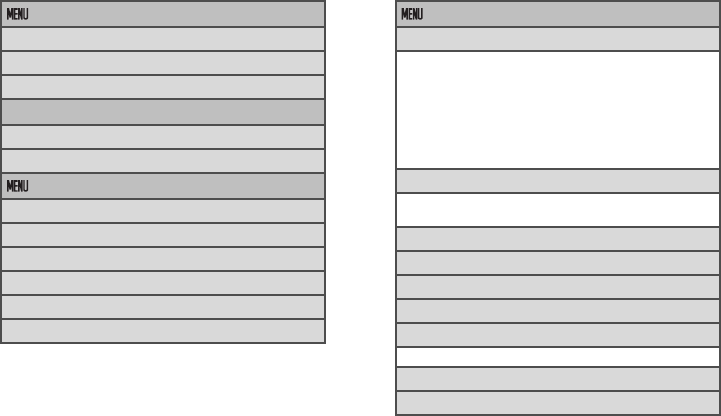
vi
> Settings > Text-to-speech
1: Listen to an example
2: Install voice data
3: Always use my settings (On/Off)
Default settings:
1: Speech rate
2: Language
> Settings > Date & time
1: Automatic (On/Off)
2: Set date
3: Select time zone
4: Set time
5: Use 24-hour format (On/Off)
6: Select date format
> Settings > About phone
1: Status
1: Battery status 2: My phone number
3: Battery level 4: MIN
5: PRL Version 6: ESN
7: MEID 8: Network
9: Signal strength 10: Mobile network type
11: Service state 12: Roaming
13: Mobile network state 14: Wi-Fi MAC address
15: Bluetooth address 16: Up time
2: Update Android
1: Check for Android Updates Now
2: Schedule Check (On/Off)
3: Update Firmware
4: Update Profile
5: Update PRL
6: Battery use
7: Legal information
1: Open source licenses 2: Google legal
8: System tutorial
9: Model number
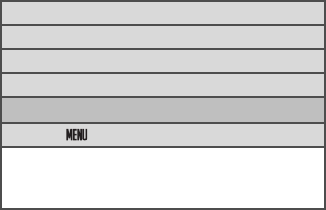
vii
10: Firmware version
11: Baseband version
12: Kernel version
13: Build number
In Use Menu
Press to display the following options:
1: Show tonepad
2: Swap calls/Merge calls/Add call
3: End call 4: Mute
5: Speaker 6: Bluetooth
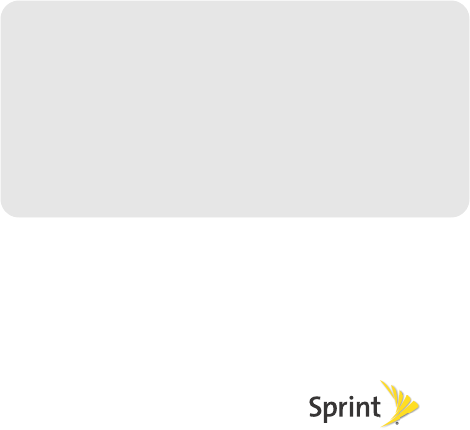
Section 1
Getting Started
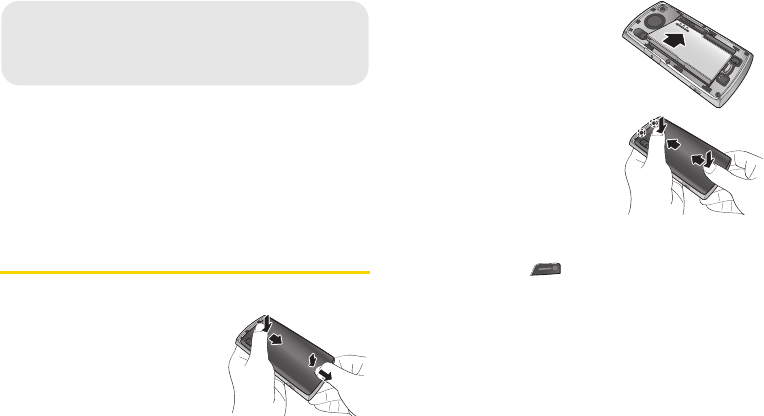
2 1A. Setting Up Service
ࡗSetting Up Your Device (page 2)
ࡗActivating Your Device (page 3)
ࡗSetting Up Your Voicemail (page 4)
ࡗSprint Account Passwords (page 5)
ࡗGetting Help (page 5)
Setting Up Your Device
1. Install the battery.
ⅢRemove the battery from
its packaging.
ⅢPress and hold the back
cover latch with your
thumbnail and slide the
cover down with the other
thumb to remove the
cover.
ⅢInsert the battery into the
opening on the back of
the device, making sure
the connectors align.
Gently press down to
secure the battery.
ⅢPosition the back cover
over the battery
compartment, making
sure the locking tabs
align. Gently slide the
cover upward with your
thumbs until you hear a
slight click.
2. Press and hold to turn the device on.
ⅢIf your device is activated, it will turn on, search for
Sprint service, and enter standby mode.
ⅢIf your device is not yet activated, see “Activating
Your Device” on page 3 for more information.
1A. Setting Up Service
QUALCOMM 3G CDMA
QUALCOMM 3G CDMA
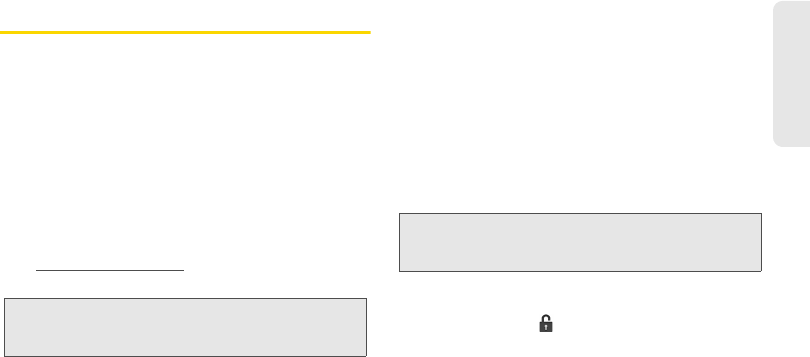
1A. Setting Up Service 3
Setting Up Service
Activating Your Device
ⅷIf you purchased your device at a Sprint Store, it is
probably activated and ready to use.
ⅷIf you received your device in the mail and it is for a new
Sprint account or a new line of service, it is designed to
activate automatically. To confirm your activation,
make a phone call.
ⅷIf you received your device in the mail and you are
activating a new device for an existing number on your
account, you will need to go online to activate your
new device.
ⅢFrom your computer’s Web browser, go to
www.sprint.com/activate and complete the
onscreen instructions to activate your device.
Sprint ID
Once your device is activated, the next thing you will
need to do is to install an initial ID Pack. ID Packs are
bundles of applications, ringtones, wallpapers, settings,
and more. ID Packs are installed using an application
called Sprint ID. You can install as many ID Packs as
you wish, and you can easily switch from one ID Pack
to another without losing any applications already
installed.
Installing Your First ID Pack
1. Touch Install service pack on the Welcome screen.
(If the lock screen appears, unlock it by dragging
the Unlock icon [ ] to the right side of the screen.)
2. Touch an ID Pack on the Browse Packs screen.
3. Read the information screen for a description of
the ID Pack and touch Download and Install.
4. Touch Continue on any following screens until you
see the Downloading... progress bar.
Note: If you are having difficulty with activation, contact Sprint
Customer Service by dialing 1-888-211-4727 from any
other phone.
Note: Your device must be activated, your battery should be
fully charged, and you should be in a network coverage
area before you install an ID Pack.
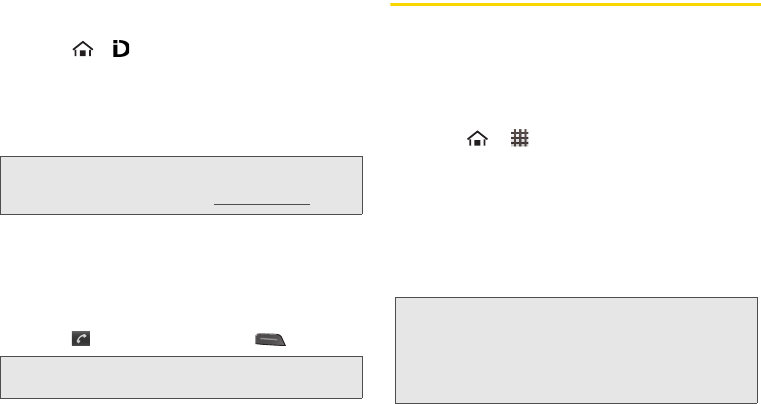
4 1A. Setting Up Service
5. Touch OK to close the Congratulations! dialog box.
Switching ID Packs
1. Touch > .
2. Touch an ID Pack to replace your current pack.
– or –
Touch Get New to install a new ID Pack and follow
steps 2–5 of “Installing Your First ID Pack.”
Making Your First Call
1. From the Home screen, touch Phone to access the
onscreen phone keypad.
2. Use your phone keypad to enter a phone number.
3. Touch on the screen, or press .
Setting Up Your Voicemail
Your device automatically transfers all unanswered
calls to your voicemail, even if your device is in use or
turned off. You should set up your Sprint Voicemail and
personal greeting as soon as your device is activated.
Always use a password to protect against unauthorized
access.
1. Touch > > Voicemail.
2. In the Personalize your voicemail dialog box, touch
Personalize now.
3. Follow the voice prompts to:
ⅢCreate your password.
ⅢRecord your name announcement.
ⅢRecord your greeting.
Note: Certain features of Sprint ID are subject to change. For
the most up-to-date information about using Sprint ID,
please see the User Guide at www.sprint.com.
Note: You should fully charge your battery before proceeding.
See “Charging the Battery” on page 15 for details.
Note: Voicemail Password
Sprint strongly recommends that you create a
password when setting up your voicemail to protect
against unauthorized access. Without a password,
anyone who has access to your device is able to
access your voicemail messages.

1A. Setting Up Service 5
Setting Up Service
For more information about using your voicemail, see
“Voicemail” on page 82.
Sprint Account Passwords
As a Sprint customer, you enjoy unlimited access to
your personal account information, your voicemail
account, and your data services account. To ensure
that no one else has access to your information, you
will need to create passwords to protect your privacy.
Account User Name and Password
If you are the account owner, you will create an account
user name and password when you sign on to
www.sprint.com. (Click Sign in and then click Sign up
now! to get started.) If you are not the account owner (if
someone else receives the bill for your Sprint service),
you can get a sub-account password at www.sprint.com.
Voicemail Password
You’ll create your voicemail password when you set up
your voicemail. See “Setting Up Your Voicemail” on
page 4 for more information on your voicemail
password.
Data Services Password
With your Sprint device, you may elect to set up an
optional data services password to control access and
authorize Premium Service purchases.
For more information, or to change your passwords,
sign on to www.sprint.com or call Sprint Customer
Service at 1-888-211-4727.
Getting Help
Managing Your Account
Online: www.sprint.com
ⅷAccess your account information.
ⅷCheck your minutes used (depending on your Sprint
service plan).
ⅷView and pay your bill.
ⅷEnroll in Sprint online billing and automatic payment.
ⅷPurchase accessories.
ⅷShop for the latest Sprint phones.
ⅷView available Sprint service plans and options.

6 1A. Setting Up Service
ⅷLearn more about data services and other products
like games, ringers, screen savers, and more.
From Your Sprint Phone
ⅷTouch to check minute usage and
account balance.
ⅷTouch to make a payment.
ⅷTouch to access a summary of your
Sprint service plan or get answers to other questions.
From Any Other Phone
ⅷSprint Customer Service: 1-888-211-4727.
ⅷBusiness Customer Service: 1-800-927-2199.
Sprint 411
Sprint 411 gives you access to a variety of services and
information, including residential, business, and
government listings; movie listings or showtimes;
driving directions, restaurant reservations, and major
local event information. You can get up to three pieces
of information per call, and the operator can
automatically connect your call at no additional charge.
There is a per-call charge to use Sprint 411, and you
will be billed for airtime.
ᮣTouch .
Sprint Operator Services
Sprint Operator Services provides assistance when you
place collect calls or when you place calls billed to a
local telephone calling card or third party.
ᮣTouch .
For more information or to see the latest in products
and services, visit us online at www.sprint.com.
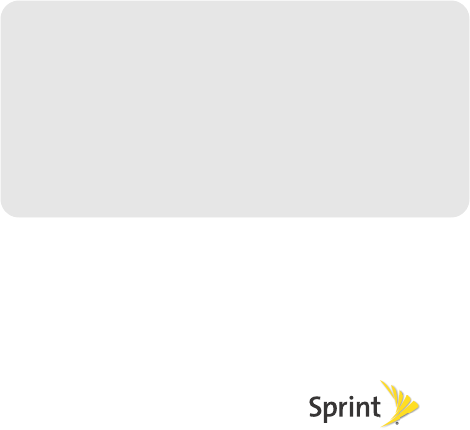
Section 2
Your Device
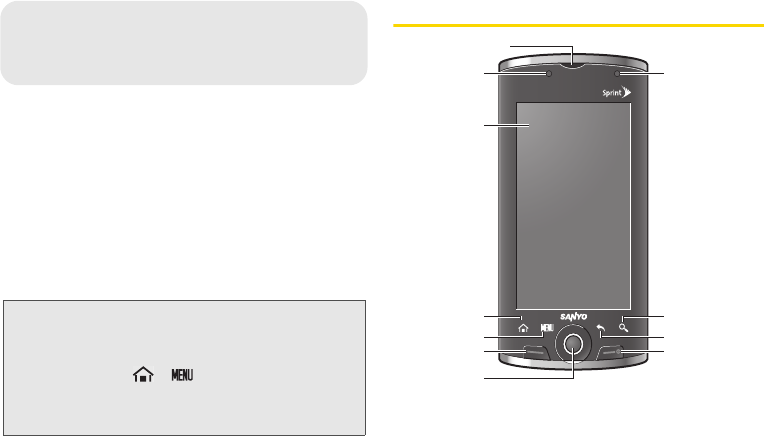
8 2A. Device Basics
ࡗYour Device (page 8)
ࡗViewing the Display Screen (page 10)
ࡗTurning Your Device On and Off (page 13)
ࡗBattery and Charger (page 14)
ࡗNavigating Through the Menus (page 16)
ࡗScreen Overview (page 18)
ࡗDisplaying Your Phone Number (page 24)
ࡗMaking and Answering Calls (page 24)
ࡗEntering Text (page 31)
Your Device
Tip: Device Software Upgrades – Updates to your device’s
software may become available from time to time. Sprint
will automatically upload critical updates to your device.
You can also use the menu to check for and download
updates. Touch >
> Settings > About phone >
Update Android, Update Firmware, Update Profile, or
Update PRL to search for and download available
updates.
2A. Device Basics
11. LED Indicator
8. END/POWER Key
2. Light Sensor
1. Earpiece
3. Display Screen
6. TALK Key
4. HOME Key
7. Trackball
5. MENU Key
10. SEARCH Key
9. BACK Key
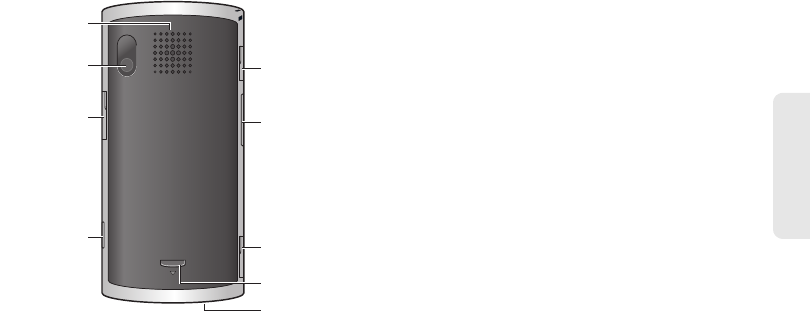
2A. Device Basics 9
Device Basics
Key Functions
1. Earpiece lets you hear the caller and automated
prompts.
2. Light Sensor automatically brightens the display
when you are in sunlight or a bright room and
dims it in darker places.
3. Display Screen displays all the information needed
to operate your device, such as the call status, the
Contacts list, the date and time, and the signal and
battery strength.
4. HOME Key returns you to the Home screen. Touch
and hold to show the recently used applications.
5. MENU Key lets you open the menus of the current
screen or application.
6. TALK Key allows you to place or receive calls,
answer Call Waiting, use 3-Way Calling, activate
Voice Dialer, view the Call log tab, or turn on the
screen backlight while turned off.
7. Trackball allows you to highlight or select an item
on the screen.
8. END/POWER Key lets you turn the device on or off,
end a call, or turn the screen backlight on or off.
9. BACK Key returns you to the previous screen or
closes the dialog box.
10. SEARCH Key allows you to activate the Search
function to search information on your device and
the Internet.
QUALCOMM 3G CDMAQU AL CO MM 3G C DM A
13. Camera Lens
14. microSD
Card Slot
15. Camera Button
18. Charger/Accessory
Jack
19. Volume Button
20. Headset Jack
12. Speaker
16. Microphone
17. Back Cover
Latch
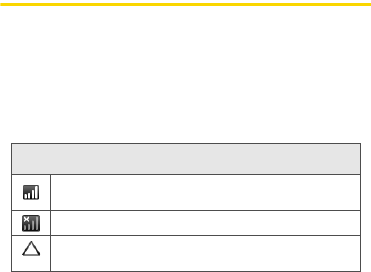
10 2A. Device Basics
11. LED Indicator shows your device’s battery status. It
also flashes for incoming calls or pending
notifications.
12. Speaker lets you hear the different ringers and
sounds. It also lets you hear the caller’s voice in
speakerphone mode.
13. Camera Lens, as part of the built-in camera, lets
you take pictures and videos.
14. microSD Card Slot allows you to insert a microSD
card to support external memory.
15. Camera Button lets you activate the camera and
camcorder and take pictures and videos.
16. Microphone allows other callers to hear you clearly
when you are speaking to them.
17. Back Cover Latch allows you to release the latch
and remove the back cover.
18. Charger/Accessory Jack allows you to connect the
device charger to charge the battery or a USB
cable (included) to transfer files to and from a
computer. CAUTION! Inserting an accessory into
the incorrect jack may damage the device.
19. Volume Button allows you to adjust the ringer
volume when you are not on a call, or the voice
volume during a call.
20. Headset Jack allows you to plug in an optional
headset for convenient, hands-free conversations.
CAUTION! Inserting an accessory into the incorrect
jack may damage the device.
Viewing the Display Screen
Your device’s display screen provides information
about your device’s status and options.
Status Bar Icons
The following list identifies the symbols you will see on
the status bar at the top of your device’s display screen:
Status Bar Icons
Your device’s current signal strength. (More bars =
stronger signal.)
Your device cannot find a usable signal.
Your device is “roaming” off the Nationwide Sprint
Network.
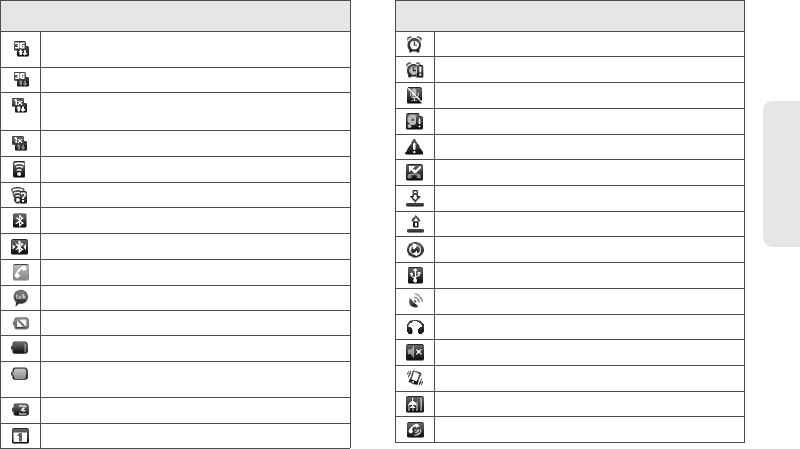
2A. Device Basics 11
Device Basics
Sprint 3G data service (EVDO) is available. When
active, the icon is animated.
Sprint 3G data service (EVDO) is currently dormant.
Sprint 1xRTT data service is available. When active,
the icon is animated.
Data service is currently dormant.
A Wi-Fi connection is available.
An open Wi-Fi network is available.
Bluetooth is enabled.
The Bluetooth data connection is active.
A voice call is in progress.
A chat is in progress.
The battery is completely discharged.
The battery charge is low.
The battery is fully charged. (The less green showing,
the less charge there is remaining.)
The battery is charging.
You have calendar notifications.
Status Bar Icons
An alarm is set.
Alarm is in snooze mode.
The microphone is muted.
The memory is full.
An error has occurred.
You have missed voice calls.
A download is in progress.
An upload is in progress.
Synchronization is in progress.
The USB port is connected.
GPS is active.
A headset is connected.
Silent mode is active.
Silent mode and Vibrate mode are active.
Airplane mode is active.
Speakerphone is on.
Status Bar Icons
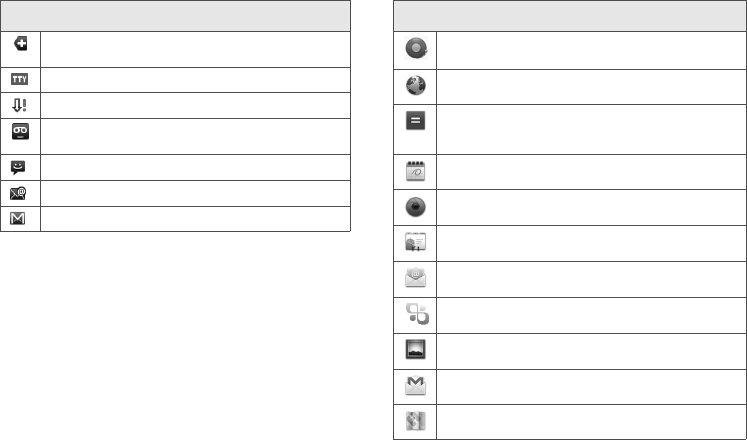
12 2A. Device Basics
Application Descriptions
The following is a listing of the default applications
found on the Applications Launcher screen.
(Depending on which ID pack is active, some of these
may also appear on the Home screen).
More icons are hidden. The number shows the
number of hidden icons.
TTY mode is enabled.
A software upgrade is available.
You have new voicemail messages. The number
shows the number of new voicemail messages.
You have new messages.
You have new email messages.
You have new Gmail messages.
Status Bar Icons Application Icons
Alarm Clock
– Launches the alarm clock application
which allows you to set multiple alarms.
Browser
– Launches the Internet browser.
Calculator
– Launches the onscreen calculator
application which allows you to perform basic
mathematical functions.
Calendar
– Launches the calendar application.
Camera
– Launches the built-in camera.
Contacts
– Displays the Contacts tab listing your
contacts.
Email
– Provides an access to your Internet email
accounts.
Exchange Email
– Launchs the Exchange Email
(corporate email) application.
Gallery
– Displays images and videos stored in the
microSD card.
Gmail
– Provides an access to your Gmail account.
Maps
– Launches Google Maps.
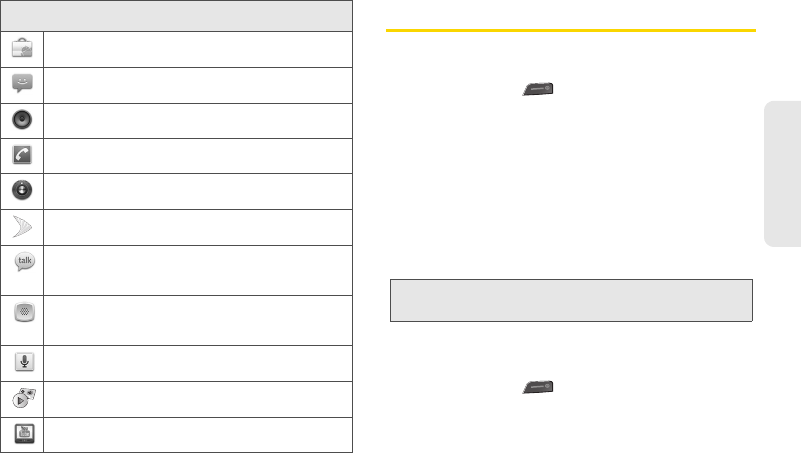
2A. Device Basics 13
Device Basics
Turning Your Device On and Off
Turning Your Device On
ᮣPress and hold .
Once your device is on and finds a signal, it
automatically enters standby mode – the device’s idle
state. At this point, you are ready to begin making and
receiving calls.
If your device is unable to find a signal after five
minutes of searching, a Power Save feature is activated
and your device searches for a signal periodically
without your intervention. When a signal is found, your
device automatically returns to standby mode.
Turning Your Device Off
1. Press and hold for two seconds. The
Phone options window appears.
2. Touch Power off > OK to turn the device off.
Market
– Allows you to browse and download games
and applications on Android Market.
Messaging
– Provides access to your text and
multimedia messages.
Music
– Launches the built-in music player.
Phone
– Launches the phone dialer.
Settings
– Provides access to the Settings menu.
Sprint Zone
– Launches the application to manage
your account, download new apps, etc.
Talk
– Launches a Web-based application that lets
you chat with family and friends over the Internet for
free.
Voice Dialer
– Launches the built-in voice dialer,
which allows you to make calls, open an application,
etc. using voice commands.
Voice Search
– Allows you to launch a Google search
using voice commands.
Voicemail
– Launches the visual voicemail
application.
YouTube
– Provides access to the YouTube website.
Application Icons
Tip: The Power Save feature conserves your battery power
when you are in an area where there is no signal.

14 2A. Device Basics
Battery and Charger
Sprint-approved or Kyocera-approved batteries and
accessories can be found at Sprint Stores or through
Kyocera; or call 1-866-866-7509 to order. They are also
available at www.sprint.com.
Battery Capacity
Your device is equipped with a Lithium Ion (Li-Ion)
battery. It allows you to recharge your battery before it is
fully drained. The battery provides up to 4.6 hours of
continuous digital talk time.
When the battery level drops to 10%, the LED indicator
begins flashing red. When the battery level drops
below 5%, the battery icon changes to and a pop-
up window warns you that the battery is low. When the
battery level drops to approximately 1%, the device
shuts down.
Installing the Battery
ᮣSee “Setting Up Your Device” on page 2.
Removing the Battery
1. Make sure the device is off so that you do not lose
any stored numbers or messages.
2. Press and hold the back cover
latch with your thumbnail and
slide the cover down with the
other thumb to remove the cover.
3. Lift the battery up and remove it
from the device.
WARNING: Use only Sprint-approved or Kyocera-approved
batteries and chargers with your device. The
failure to use a Sprint-approved or Kyocera-
approved battery and charger may increase the
risk that your device will overheat, catch fire, or
explode, resulting in serious bodily injury, death,
or property damage.
Note: Long backlight settings, searching for service, vibrate
mode, browser use, and other variables may reduce
the battery’s talk and standby times.
Tip: Watch your device’s battery level indicator and charge the
battery before it runs out of power.
QUALCOMM 3G CD MA

2A. Device Basics 15
Device Basics
Charging the Battery
Keeping track of your battery’s charge is important. If
your battery level becomes too low, your device
automatically turns off, and you will lose any
information you were just working on.
Always use a Sprint-approved or Kyocera-approved
desktop charger, travel charger, or vehicle power
adapter to charge your battery.
ᮣPlug the flat end of the charger
into the device’s charger/
accessory jack and the other
end into an electrical outlet.
ⅢA solid red indicator light
means the battery is
charging.
ⅢA flashing red indicator light means the battery is
low.
ⅢA solid green indicator light means the battery is
fully charged.
With the Sprint-approved Li-Ion battery, you can
recharge the battery before it becomes completely run
down.
Tip: Hook your fingernail under the tab at the top left side of
the battery to facilitate removal.
WARNING: Do not handle a damaged or leaking Li-Ion
battery as you can be burned.
WARNING: Do not remove the battery while it is charging.
Always remove the charger from the wall outlet
first before removing the USB cable from the
device.
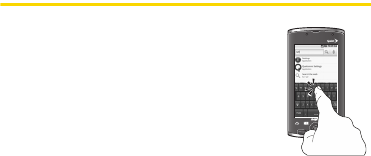
16 2A. Device Basics
Extending Your Battery Life
Active applications, backlight levels, and Bluetooth and
GPS use all contribute to draining your battery. The
following is a list of helpful tips that can help conserve
your battery’s charge:
ⅷReduce your backlight on time. See “Changing the
Backlight Time Length” and “Changing the Key
Backlight Time Length” on page 38.
ⅷTurn Bluetooth off when not in use. See “Turning
Bluetooth On and Off” on page 77.
ⅷTurn Wi-Fi off when not in use. See “Turning Wi-Fi On
and Off” on page 98.
ⅷTurn GPS off when not needed. Most applications
using this function will periodically query the GPS
satellites for your current location; each query drains
your battery. See “Location Settings” on page 39.
ⅷDo not wait until your battery is completely depleted
before charging your device. Repeated complete
discharging and recharging can reduce the storage
capacity of any battery over time.
ⅷTurn off Automatic application sync. See
“Synchronizing Accounts” on page 40.
ⅷAdd a Power Control Widget to your Home screen to
deactivate features such as Wi-Fi, Bluetooth, GPS,
and synchronization and to reduce the screen’s
brightness setting. See “Adding an Item” on page 21.
ⅷCheck running services and close any unnecessary
applications. See “To view and control currently
running services:” on page 49.
Navigating Through the Menus
Menu Navigation
Touch: To type using the onscreen
QWERTY keyboard, select items such
as application and settings icons, or
press onscreen buttons, simply touch
them with your finger. A light touch
works best.
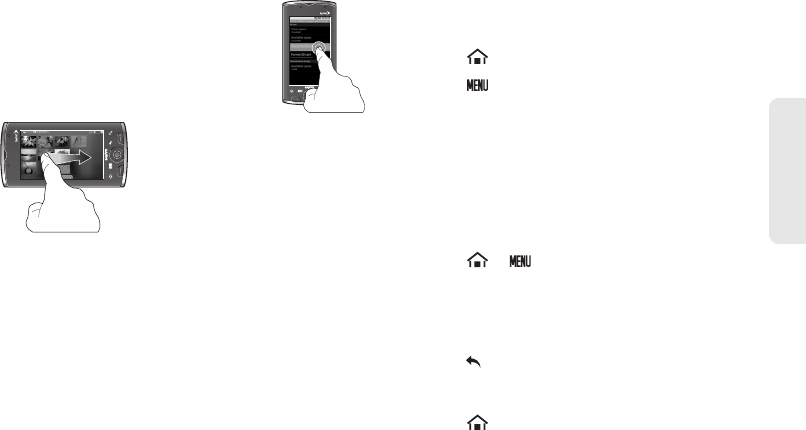
2A. Device Basics 17
Device Basics
Touch and hold: To open the available
options for an item (for example, a link
in a Web page), simply touch and hold
the item.
Slide: Quickly
drag your finger vertically or
horizontally across the screen.
Drag: Press and hold your finger
before you start to move it. Do
not release your finger until you
have reached the target position.
There are two ways to navigate through the menus on
the display screen:
ⅷUsing your finger: Touch, Touch and Hold, Drag, or
Slide an item or screen to open applications or
option windows or to select an item, etc.
ⅷUsing the trackball: Simply roll the trackball to move
through the items up and down or right and left, and
press it to select an item.
Selecting Menu Items
For example, to view the current battery usage:
1. Touch to go to the Home screen.
2. Touch .
3. Touch Settings.
4. Scroll your finger bottom up across the screen and
touch About phone.
5. Touch Battery use.
For the purposes of this guide, the above steps
condense into:
ᮣTouch > > Settings > About phone >
Battery use.
Backing Up Within a Menu
To go back to the previous screen:
ᮣTouch .
To return to the Home screen:
ᮣTouch .
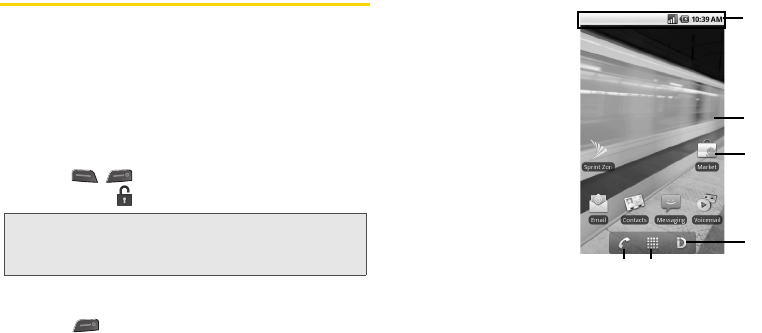
18 2A. Device Basics
Screen Overview
Screen Lock
The display screen will automatically lock to prevent
accidental activation after the time specified for the
screen timeout. (See “Changing the Backlight Time
Length” on page 38.)
Unlocking the Display Screen
ᮣPress , , or the trackball, and drag the
Unlock icon( ) to the right side of the screen.
Locking the Display Screen Manually
ᮣPress . The backlight turns off.
Home Screen Overview
The Home screen is
the starting point for all
applications. You can
access applications,
view call notifications
and battery or
connection status.
1. Status Bar:
ⅢDisplays
notification and
device status
icons.
ⅢTouch and hold to
display the date.
ⅢDrag down to display the Notifications panel.
2. Home Screen: Displays shortcut icons, widgets,
wallpapers, and folders.
3. Shortcuts: Icons that launch applications such as
Voicemail, Contacts, Phone, Email, Alarm Clock,
etc. These function the same as shortcuts on your
computer.
Note: When an unlock pattern is set for the device, you will be
required to draw the set pattern instead. See “Your
Device’s Unlock Pattern Feature” on page 46.
1.
4.
3.
2.
5.
6.
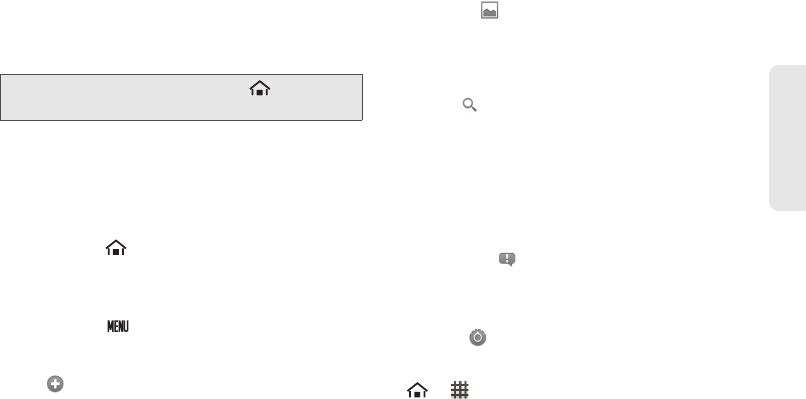
2A. Device Basics 19
Device Basics
4. ID Pack: Allows users to switch the ID pack or get a
new pack.
5. Applications Launcher: Touch to display a list of
applications installed on the device.
6. Phone: Launches the phone dialer.
Device Keys
Your device has four main keys that can be used on
any screen for added convenience and usability:
Home Key
The Home key ( ) takes you back to your Home
screen.
Menu Key
The MENU key ( ) opens a contextual menu for the
current screen or application. When on the Home
screen, the following menu options are available:
ⅷAdd ( ) lets you add one of the following functions
to a selected screen: Shortcuts, Widgets, Folders, or
Wallpapers. See “Customizing Your Home Screen”
on page 21.
ⅷWallpaper ( ) lets you change the current screen’s
wallpaper image. This image can be obtained from
either your Pictures folder or from any of the available
images within the device’s Wallpaper gallery. See
“Changing the Wallpaper” on page 21.
ⅷSearch ( ) displays the Quick Search box that can
be used to search for a key term both on the device
or online. See “Search Key” on page 20.
ⅢFor example, entering the word “Pa” will display
any matching entries from your device’s Contacts
list, current device applications, online Android or
Google apps, or from any online Web page via
Google search.
ⅷNotifications ( ) opens the Notifications panel. It
does the same thing as dragging the status bar
down on the Home screen. See “Using the
Notifications Panel” on page 24.
ⅷSettings ( ) provides quick access to the device’s
Settings menu. See “2B. Settings” on page 35. The
Settings menu can also be accessed by touching
> > Settings.
Note: From any application screen, touch to go back to
the Home screen.
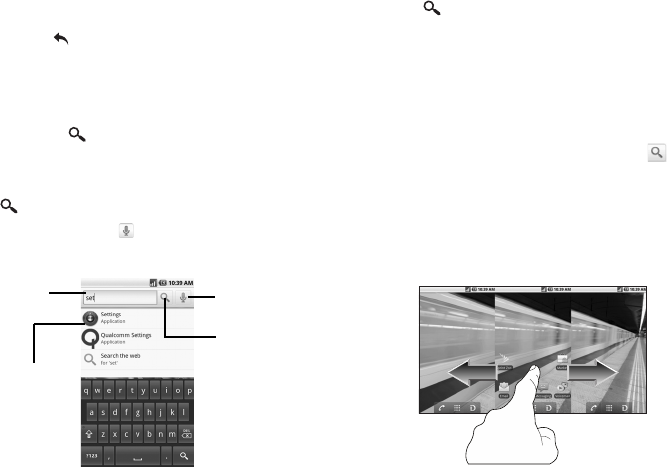
20 2A. Device Basics
Back Key
The Back key ( ) returns you to the previously active
screen. If the QWERTY keyboard is currently open, this
key closes the keyboard.
Search Key
The Search key ( ) displays the Quick Search box
that can be used to search for a key term both on the
device or online. In some instances, this key opens a
search box specific to only the current application.
Touch again to open the Quick Search box.
Touching Voice Search ( ) initiates the search
function but without the need to use the QWERTY
keyboard.
1. Touch . The Quick Search Box, the Google
Search key, the Voice Search key, and a keyboard
appear.
2. Enter the information you want to search. As you
type, matching information is displayed on the
screen.
3. To select a matched item, touch the item. To
search the Internet using Google, touch .
Extended Home Screen
Slide your finger left or right across the Home screen to
display the Home screen extensions. The extra screens
provide ample space for icons, widgets, shortcuts, and
other items.
Search Matches
(Device & Web)
Quick Search
Box
Google Search
Voice Search

2A. Device Basics 21
Device Basics
Customizing Your Home Screen
Adding an Item
1. Touch and hold an empty spot on the Home
screen or touch > > Add. The
Add to Home screen window appears.
2. Select the type of item you want to add:
ⅢShortcuts: Select to add a shortcut option:
Applications, Bookmark, Contact, Direct dial,
Direct message, Directions & Navigation,
Exchange Email, Gmail label, Latitude,
Music playlist, or Settings. (Most of these options
will expand to allow you to choose specific items.)
ⅢWidgets: Select to add a widget (a mini-version of
an application) such as an analog clock,
calendar, music player, power control, etc.
ⅢFolders: Select to add a folder to organize your
Home screen items. See “Creating a Folder” on
page 22.
ⅢWallpapers: Select to change the Home screen’s
wallpaper. See “Changing the Wallpaper” on this
page.
Repositioning an Item
1. Touch and hold the item that you want to
reposition. The item becomes movable.
2. Drag the item to the desired location.
3. Release your finger to finalize the repositioning.
Removing an Item
1. Touch and hold the item that you want to remove.
The item becomes movable and the applications
tab icon changes into .
2. Drag the item to .
3. When the item and the icon turn red, release your
finger.
Changing the Wallpaper
1. From the Home screen, touch > Wallpaper.
2. Select one of the following options:
Note: To reposition an item to the extended Home screen,
drag the item to the edge of the screen until the Home
screen extends. Then release your finger to reposition
the item to your desired location.

22 2A. Device Basics
ⅢGallery: Select to use saved or captured pictures
on your device. You can crop the picture before
setting it as wallpaper.
ⅢWallpaper gallery: Select to use preset wallpapers.
3. Touch Save or Set wallpaper.
Creating a Folder
1. From the Home screen, touch > Add >
Folders.
2. On the Select folder screen, select one of the
following options:
ⅢNew folder: Select to create a new folder with no
items inside.
ⅢAll contacts: Select to create a Contacts folder.
ⅢAll Emails: Select to create an Email folder.
ⅢBluetooth received: Select to create a folder of files
received using Bluetooth.
ⅢContacts with phone numbers: Select to create a
folder of Contacts that have phone numbers.
ⅢStarred contacts: Select to create a folder of your
favorite contacts.
Renaming a folder
1. Touch a folder to open it.
2. Touch and hold the title bar of the folder. The
Rename folder window opens.
3. Enter the new folder name.
4. Touch OK when done.
Putting Home screen shortcuts into a folder
1. Touch and hold an item. The item becomes
movable.
2. Drag the item to a folder.
Accessing items inside a folder
1. Touch a folder to open it.
2. Touch the icon of the application you want to
access.
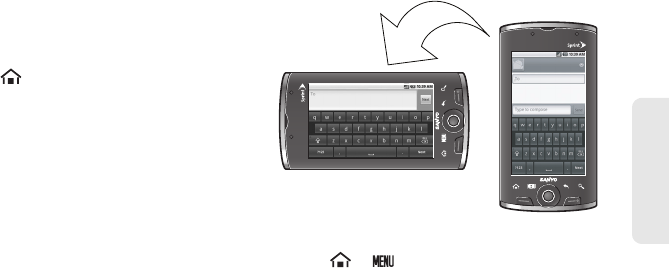
2A. Device Basics 23
Device Basics
Accessing Recently Used Applications
Your device keeps a running list of your six most
recently used applications.
1. Touch and hold to open the recently used
applications window.
2. Touch an icon to open the related application.
Changing the Screen Orientation
Your device is capable of automatically changing the
orientation of some onscreen content.
The device’s built-in accelerometer senses movement
and changes to the device’s angle and orientation. This
allows the device to change the onscreen content
(images, Web pages, etc.) to properly display based on
the current angle. (Some screens may not
automatically change.)
To activate the auto-rotate feature:
1. Touch > > Settings > Sound & display.
2. Touch Orientation to select that option. (A check
mark indicates this feature is enabled.)
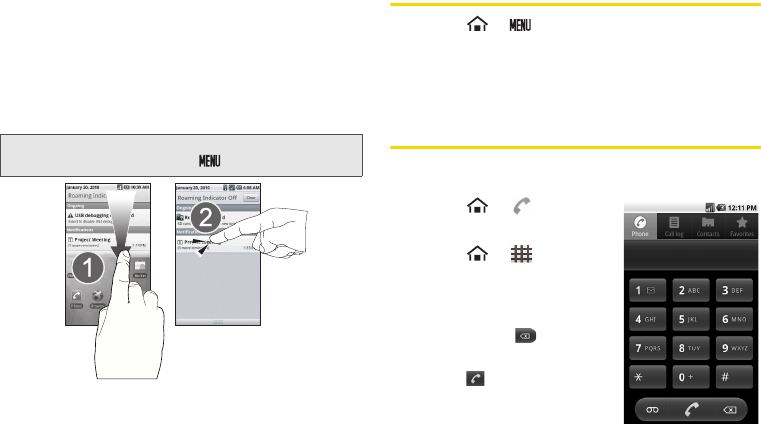
24 2A. Device Basics
Using the Notifications Panel
The Notifications panel indicates new message events
(data sync status, new messages, calendar events, call
status, etc).
1. Drag the status bar down the screen.
2. Tap a notification entry to open the associated
application.
Displaying Your Phone Number
ᮣTouch > > Settings > About phone >
Status.
Your phone number and other information about your
device and account will be displayed.
Making and Answering Calls
Making Calls
1. Touch > .
– or –
Touch > >
Phone.
2. Enter a phone number
using the phone keypad. (If
you make a mistake while
dialing, touch to erase
the numbers.)
3. Touch .
(To make a call when you
are roaming and Call Guard
Note: The Notifications panel can also be opened on the
Home screen by touching > Notifications.

2A. Device Basics 25
Device Basics
is enabled, touch Agree. See “Call Guard” on page
90.)
4. Press when you are finished.
You can also place calls from your device by using
your Contacts (page 30), Call log listings (page 52),
and Automatic Speech Recognition (ASR) (page 64).
Dialing Options
When you enter numbers on the phone keypad, some
of the dialing options may available by touching .
ⅷAdd to contacts: Add the number to the Contacts list.
ⅷAdd 2-sec pause: to insert a two-second pause. (See
“Dialing and Saving Phone Numbers with Pauses”
on page 29.)
ⅷAdd wait: to insert a wait pause. (See “Dialing and
Saving Phone Numbers with Pauses” on page 29.)
Answering Calls
1. Make sure your device is on. (If your device is off,
incoming calls go to voicemail.)
2. Press .
– or –
Drag the picture ID (or Android icon) to the top of
the screen if the screen is locked.
– or –
Touch if the screen is unlocked.
Your device notifies you of incoming calls in the
following ways:
ⅷThe device rings or vibrates.
ⅷThe indicator light flashes.
ⅷThe screen displays an incoming call message.
If the caller is listed in your Contacts, the contact’s
name appears. You may also see the caller’s phone
number, if available.
You may also select one of the following options:
ⅷPress the volume button to mute the ringer.
ⅷPress to send the call to your voicemail box.
ⅷDrag the picture ID (or Android icon) to the bottom
left corner if the screen is locked, or drag the slider
Tip: To redial your outgoing call, press and touch
next to the entry on the Call log tab.
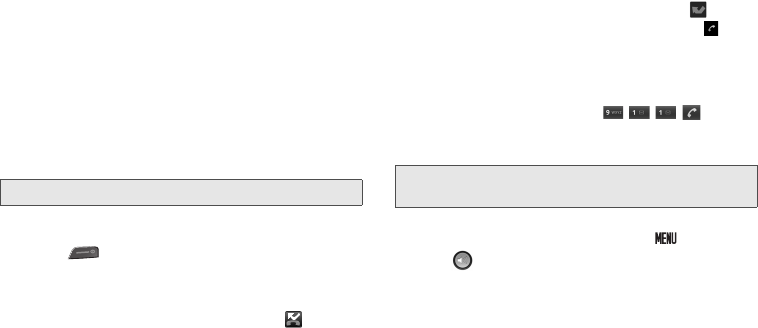
26 2A. Device Basics
bar to the left if the screen is unlocked to ignore the
call.
ⅷDrag the picture ID (or Android icon) to the bottom
right corner if the screen is locked, or drag the slider
bar to the right if the screen is unlocked to send a
text message to the caller.
Answering a Roam Call With Call Guard Enabled
Call Guard is an option that helps you manage your
roaming charges when making or receiving calls while
outside the Nationwide Sprint Network. See “Roaming”
on page 89 for more information about roaming.
ᮣTouch Agree to answer the call. (See “Call Guard”
on page 90 for additional information.)
Ending a Call
ᮣPress .
Missed Call Notification
When you do not answer an incoming call, appears
on the status bar.
To display a Missed Call entry from the Notifications panel:
1. Drag the status bar down to open the Notifications
panel.
2. Touch Missed call(s) to open the Call log tab.
3. Touch an entry with a missed call icon ( ) to
open it. (To dial the phone number, touch next
to the entry.)
Calling Emergency Numbers
You can place calls to 911 (dial ), even if
your device is locked with a screen unlock pattern or
your account is restricted.
During an emergency call, the following options are
available on the screen or by touching :
ⅷTouch to activate speakerphone mode.
ⅷTouch Contacts to display your Contacts list.
ⅷTouch Bluetooth to transfer the call to a connected
Bluetooth device.
Note: When your device is off, calls go directly to voicemail.
Note: After you have placed an emergency call, your device
automatically enters Emergency mode.
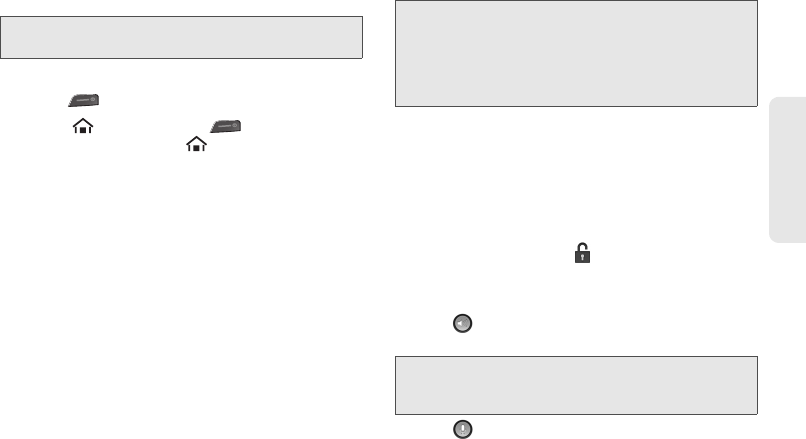
2A. Device Basics 27
Device Basics
ⅷTouch End call to finish the emergency call.
To exit Emergency mode:
1. Press to end a 911 call.
2. Touch and then press within five
seconds after touching .
Enhanced 911 (E911) Information
This device features an embedded Global Positioning
System (GPS) chip necessary for utilizing E911
emergency location services where available.
When you place an emergency 911 call, the GPS
feature of your device seeks information to calculate
your approximate location. Depending on several
variables, including availability and access to satellite
signals, it may take up to 30 seconds or more to
determine and report your approximate location.
In-Call Options
Unlocking the Screen
The device screen is locked automatically during a call
to avoid accidentally touching the screen.
To unlock the screen:
ᮣDrag the Unlock icon ( ) to the status bar.
The screen and the device offer the following options
during a call:
ⅷTouch to route the device's audio through the
speaker.
ⅷTouch to disable the microphone.
Tip: Your phone number will be displayed on the screen
during an emergency call.
Important: Always report your location to the 911 operator
when placing an emergency call. Some
designated emergency call takers, known as
Public Safety Answering Points (PSAPs) may not
be equipped to receive GPS location information
from your device.
WARNING: Because of higher volume levels, do not place
the device near your ear during speakerphone
use.
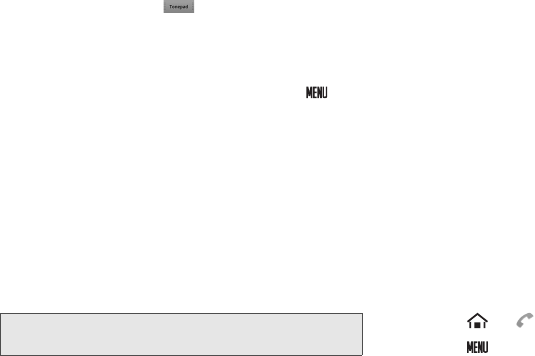
28 2A. Device Basics
ⅷDrag the Tonepad tab ( ) upward to enter the dial
tones. Drag downward to hide it.
ⅷPress the volume button up or down to adjust the
speaker volume.
Further options may be available by touching
during a call:
ⅷAdd call to place a second call while putting the
current caller on hold.
ⅷEnd call to end a call.
ⅷBluetooth to route the device's audio through a
connected Bluetooth device.
ⅷSwap calls to switch from the current call to the one
on hold.
ⅷMerge calls to merge two open calls to start a 3-way
call.
End-of-Call Screen
After you finish a call, the device briefly displays the
caller’s or recipient’s name (if it is in your Contacts),
phone number, and the duration of the call on the End
call screen. Then the screen displays the Call log tab for
outgoing calls where further options may be available.
See “Viewing the Call Log” on page 51.
Saving a Phone Number
The number of Contacts entries you can store in your
device is limited only by available memory space. Your
device automatically sorts the Contacts entries
alphabetically. (For more information, see “2D.
Contacts” on page 54.)
To save a number:
1. Touch > and enter a phone number.
2. Touch > Add to contacts.
3. Touch Create new contact or an existing contact.
4. Touch any field to enter the details.
5. Enter all the necessary details and touch Done to
save the entry.
Note: Enable Voice Privacy in Call settings to enhance the
privacy mode.
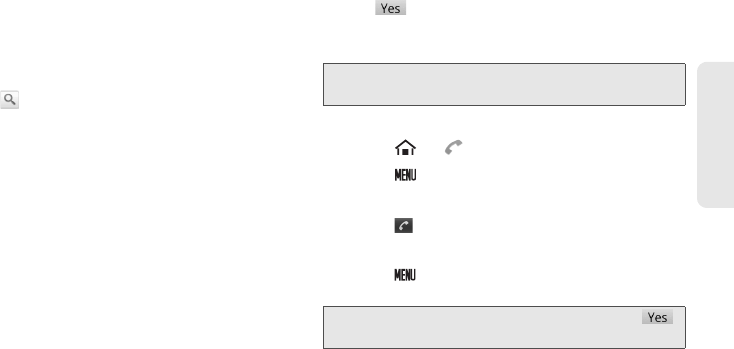
2A. Device Basics 29
Device Basics
Finding a Phone Number
You can search Contacts for entries by name.
1. On the Home screen, touch Contacts.
-or-
On the Phone screen, touch the Contacts tab.
2. Touch .
3. Enter the first letter or letters of an entry. (The more
letters you enter, the more specific the search.) All
Contacts entries matching the entered letters will
be displayed.
4. To display the contact details, touch an entry from
the list.
Dialing and Saving Phone Numbers with
Pauses
You can dial or save phone numbers with pauses for
use with automated systems, such as voicemail or
credit card billing numbers.
There are two types of pauses available on your device:
ⅷAdd wait: Sends the next set of numbers when you
touch on the pop-up window.
ⅷAdd 2-sec pause: Automatically sends the next set of
numbers after two seconds.
To dial or save phone numbers with pauses:
1. Touch > and all or part of a number.
2. Touch > Add wait or Add 2-sec pause.
3. Enter additional numbers.
4. Touch to dial the number.
– or –
Touch >
Add to contacts to save the number in
your Contacts.
Note: You can have multiple pauses in a phone number and
combine wait and two-second pauses.
Note: When dialing a number with a wait pause, touch
on the pop-up window.

30 2A. Device Basics
Dialing From the Contacts List
1. On the Home screen, touch Contacts.
-or-
On the Phone screen, touch the Contacts tab.
2. Scroll through the list, touch the entry you want to
call and touch Call [label].
Dialing From the Favorites List
1. On the Home screen, touch Contacts and then
touch the Favorites tab.
– or –
On the Phone screen, touch the Favorites tab.
2. Scroll through the list and touch . A call is made
when the Favorite has only one phone number
registered. The Call using window opens if the
Favorite has multiple phone numbers registered.
Touch the number you want to dial to make a call.
Plus (+) Code Dialing
When placing international calls, Plus Code Dialing
automatically enters the international access code for
your location (for example, 011 for international calls
made from the U.S.).
1. On the Phone screen, touch and hold until you
see a “+” on the display screen.
2. Enter the country code and phone number, and
then touch . (The device automatically
prepends the access code for international dialing,
followed by the country code and phone number.)
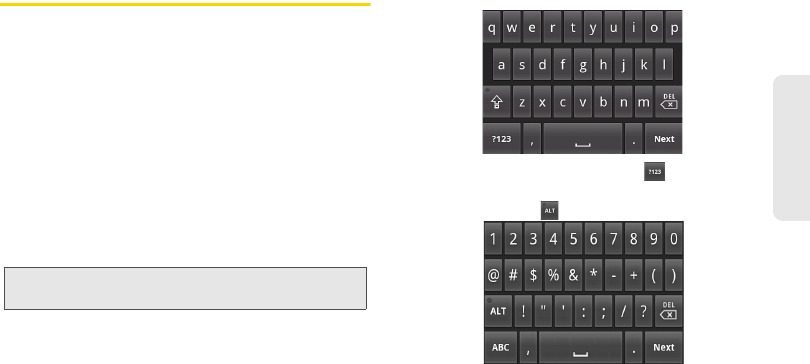
2A. Device Basics 31
Device Basics
Entering Text
Your device provides convenient ways to enter letters,
numbers, and symbols whenever you are prompted to
enter text (for example, when adding a Contacts entry
or when using email and text messaging).
Your device has the following onscreen keyboards:
Alphabet Keyboard, Number & Symbol Keyboard, and
Phone Keypad. The keyboard that is displayed depends
on the type of information required.
QWERTY Keyboard
The QWERTY keyboard is activated whenever an
alphanumeric entry is required. The Alphabet keyboard
layout looks similar to a computer keyboard.
Alphabet Keyboard: Touch a text field which requires
alphanumeric entry to activate.
Number & Symbol Keyboard: Touch on the
Alphabet keyboard to activate. You can display more
symbols by touching .
Note: Key appearance may vary depending on the selected
application.
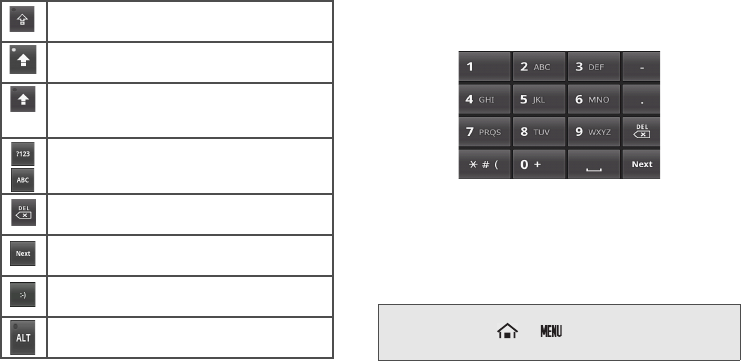
32 2A. Device Basics
Phone Keypad
Touch a text field that requires numeric input to activate.
Using Landscape Mode
For added convenience, you can switch to landscape
mode by rotating the device 90º to the left
(counterclockwise). This widens the keyboard and
allows you to type using two thumbs.
Touch to toggle between lower case, upper
case, and Caps lock
.
Indicates Caps lock is turned on. Touch once to
turn off Caps lock
.
Indicates the first letter will be entered in upper
case, but succeeding characters will be
entered in lower case.
Touch to toggle between the Alphabet
keyboard and Number & Symbol keyboard.
Touch and hold to access the settings menus.
Touch to delete a character. Touch and hold to
delete multiple characters.
Touch to go to the next text entry field.
Touch to insert a smiley. Touch and hold to
view and select other smileys.
Touch to display more symbols. Note: To use this feature, ensure that the Orientation box is
checked in > > Settings >
Sound & display.

2A. Device Basics 33
Device Basics
Copying and Pasting Text
In applications that require text entry, such as
Messaging, use the copy and paste functions to copy
and paste text from one application to another.
1. Open the application or received message that
you want to copy text from.
2. Touch and hold the text body to display the options
menu.
3. Touch Copy message text or Copy all to copy the
text.
4. Open the application that you want to paste the
text to.
5. Touch and hold the text box where you want to
paste the text.
6. Touch Paste.
Copying Text From a Web Page
1. When viewing a Web page, touch > More >
Select text.
2. Touch and drag your finger to highlight the text that
you want to copy.
3. Release your finger to copy the highlighted text to
the clipboard.
4. Open the application that you want to paste the
selected text to.
5. Touch and hold the text box where you want to
paste the text.
6. Touch Paste.
Copying a URL
1. To copy a URL, touch and hold the URL to display
the options menu.
2. Touch Copy link URL or Copy page url.
3. Open the application that you want to paste the
URL to.
4. Touch and hold the text box where you want to
paste the URL.
5. Touch Paste.

34 2A. Device Basics
Language & Keyboard Settings
Language
1. Touch
>
>
Settings
>
Language & keyboard
>
Select locale.
2. Touch English or Español.
Android Keyboard
ᮣTouch
>
>
Settings
>
Language & keyboard
>
Android keyboard
.
ⅷVibrate on keypress: Touch to activate vibration when
a key is touched.
ⅷSound on keypress: Touch to activate a clicking
sound when a key is touched.
ⅷAuto-capitalization: Touch to automatically set the first
letter of a sentence to upper case.
Word Suggestion Settings
ⅷQuick fixes: Touch to add a period when you press
the space key twice to indicate sentence completion.
ⅷShow suggestions: Touch to display suggested words
as you type.
ⅷAuto-complete: Touch to enter a highlighted word
automatically if a space or punctuation symbol is
typed.
User Dictionary
Select to add user preset words to the dictionary.
Adding Words in the Dictionary
1. From the Language & Keyboard settings screen,
touch User dictionary > > Add.
2. Type the word you want to add, and touch OK.
Customizing Words in the Dictionary
1. From the Language & keyboard settings screen,
touch User dictionary.
2. Touch a word you want to customize, and do one
of the following:
ⅢTo edit the word, touch Edit.
ⅢTo delete the word from the dictionary, touch
Delete.
Tip: You can also display the Android keyboard settings
menu by touching and holding or and then
touching Android keyboard settings on the keyboard.

2B. Settings 35
Settings
ࡗSound Settings (page 35)
ࡗDisplay Settings (page 37)
ࡗLocation Settings (page 39)
ࡗSynchronizing Accounts (page 40)
ࡗSearch Settings (page 42)
ࡗMessaging Settings (page 43)
ࡗAirplane Mode (page 44)
ࡗTTY Use With Sprint Service (page 44)
ࡗUsing the Hearing Aid Device Compatibility Function
(page 46)
ࡗSecurity Settings (page 46)
ࡗApplication Settings (page 48)
ࡗPrivacy Settings (page 50)
ࡗAccessibility Settings (page 50)
Sound Settings
Ringer Types
Ringer types help you identify incoming calls and
messages. You can assign ringer types to voice calls
and notifications.
Selecting Ringer Types for Voice Calls
1. Touch > > Settings > Sound & display >
Phone ringtone.
2. Touch Preloaded ringtones or User added ringtones,
and touch a ringtone from the available list. The
ringtone briefly plays when selected.
3. Touch OK to assign a ringer.
2B. Settings
Note: The Settings menu can also be accessed from the
Applications Launcher screen.
Tip: You can assign individual ringtones to your Contacts. See
“Assigning a Ringer Type for an Entry” on page 56.
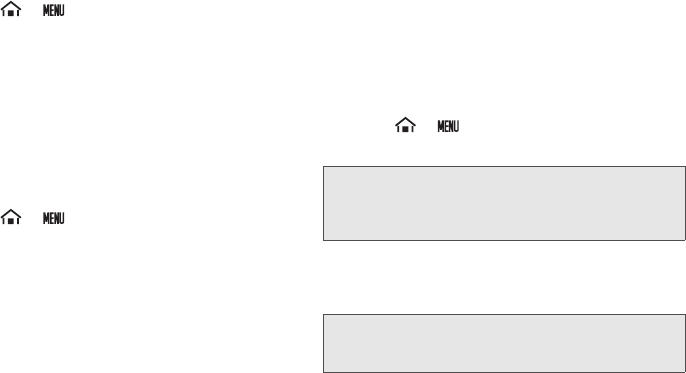
36 2B. Settings
Selecting Ringer Types for Notifications
1. Touch > > Settings > Sound & display >
Notification ringtone.
2. Touch a ringtone from the available list. The
ringtone briefly plays when selected.
3. Touch OK to assign a ringer.
Enabling Other Sound Features
You can set the device to play an audible tone or to
vibrate when you use the phone keypad, touch the
screen, or receive SD card notifications.
1. Touch > > Settings > Sound & display.
2. Touch Audible touch tones, Audible selection,
Haptic feedback, or SD card notifications to activate
the feature.
ⅢAudible touch tones plays a tone while using the
phone keypad.
ⅢAudible selection plays a sound when making
any onscreen selection.
ⅢHaptic feedback vibrates when pressing keys
and on certain UI interactions.
ⅢSD card notifications plays a sound for SD card
notifications.
Adjusting the Volume Settings
Adjust the volume settings of both the device and
Media playback to suit your needs and your
environment.
1. Touch > > Settings > Sound & display.
2. Touch either Ringer volume or Media volume.
3. Touch and drag the onscreen slider to adjust the
volume level.
4. Touch OK.
Note: If you clear the “Use incoming call volume for
notifications” check box on the ringer volume settings
screen, you can select the notification volume
separately.
Tip: You can adjust the ringer volume in standby mode (or
the earpiece volume during a call) by using the volume
button on the left side of your device.

2B. Settings 37
Settings
Setting Vibration
To set your device to vibrate instead of making any
sounds (except for media and alarm sounds):
ᮣPress the volume button down in standby mode
until you see on the screen.
To set your device to always vibrate in addition to any
ringer settings:
1. Touch > > Settings > Sound & display.
2. Touch Phone vibrate to enable vibration. (A check
mark indicates this feature is enabled.)
Silence All
The Silence All option allows you to mute all sounds
(except for media and alarm sounds).
To activate Silence All:
ᮣPress the volume button down in standby mode
until you see on the screen.
– or –
Touch > > Settings > Sound & display >
Silent mode.
To deactivate Silence All:
ᮣPress the volume button up repeatedly to select a
volume level.
Display Settings
Window Animation
This feature lets you set the degree of animation for
onscreen transitions.
1. Touch > > Settings > Sound & display >
Animation.
2. Touch No animations, Some animations, or All
animations.
Adjusting the Brightness
Adjust your screen’s brightness to suit your
surroundings.
1. Touch > > Settings > Sound & display >
Brightness.
2. Touch and drag the Brightness slider left or right to
adjust the screen contrast.

38 2B. Settings
3. Touch OK.
Setting Auto Backlight
1. Touch > > Settings > Sound & display.
2. Touch Auto backlight to automatically adjust the
backlight of the screen with the light sensor.
Changing the Backlight Time Length
Select the delay time before the screen automatically
turns off.
1. Touch > > Settings > Sound & display >
Screen timeout.
2. Select a time setting.
Changing the Key Backlight Time Length
The Home, Menu, Back, and Search keys remain backlit
for eight seconds by default after you press them. You
can synchronize the length with the time set for the
screen timeout.
1. Touch > > Settings > Sound & display.
2. Touch Key Backlight. (A check mark indicates this
feature is enabled.)
Display Language
You can choose to display your device’s onscreen
menus in English or in Spanish.
1. Touch > > Settings >
Language & keyboard > Select locale.
2. Select English or Español.
Adjusting the Date and Time Manually
Your device obtains its time and date information by
using the network-provided date, time, and time zone.
These values can be changed manually.
1. Touch > > Settings > Date & time.
2. Clear the Automatic check box if necessary.
3. Touch Set date. Adjust the date, month, and year
by tapping + or -. Touch Set when finished.
Note: This feature is not available when Auto backlight is
enabled. See “Setting Auto Backlight” below.
Note: Long backlight settings reduce the battery’s talk and
standby times.

2B. Settings 39
Settings
4. Touch Select time zone, and then select a time
zone from the onscreen list. Scroll down the list to
view additional time zones.
5. Touch Set time. Adjust the hour and minute by
tapping + or -. Touch the AM or PM icon to change
the value. Touch Set when finished.
6. Touch Use 24-hour format to toggle between 12-
hour or 24-hour format.
7. Touch Select date format to select how the date
information is displayed on your device.
Location Settings
Your device is equipped with a Location feature for use
in connection with location-based services.
The Location feature allows the network to detect your
position. Turning Location off will hide your location
from everyone except 911.
To enable your device’s Location feature via wireless
networks:
1. Touch > > Settings > Location & security.
2. Touch Use wireless networks. (A check mark
indicates this feature is enabled.)
3. Read the disclaimer and touch Agree.
Note: Turning Location on will allow the network to detect
your position using GPS technology, making some
Sprint applications and services easier to use. Turning
Location off will disable the GPS location function for all
purposes except 911, but will not hide your general
location based on the cell site serving your call. No
application or service may use your location without
your request or permission. GPS-enhanced 911 is not
available in all areas.

40 2B. Settings
To enable your device’s Location feature via GPS:
1. Touch > > Settings > Location & security.
2. Touch Use GPS satellites. (A check mark indicates
this feature is enabled.)
ⅢThis service uses available GPS to pinpoint your
location within certain applications such as
Google Maps.
Synchronizing Accounts
Google accounts provide the ability to synchronize
calendar events and Contacts, and corporate accounts
provide the ability to synchronize Contacts. Your device
provides the ability to synchronize data from a variety of
different sources or sites. These accounts include
Google accounts, corporate Exchange email server
accounts, and social sites such as Facebook, Twitter,
and MySpace. You need to add those accounts to the
Manage accounts list.
To enable the auto-sync feature:
1. Touch > > Settings > Accounts & sync.
2. Touch Auto-sync. (A check mark indicates the
feature is enabled.)
Synchronizing Your Google Account
By default, your device doesn’t manage any accounts.
These must be manually added. To have your device
manage an existing Google account:
1. Touch > > Settings > Accounts & sync.
2. Touch Add account > Google.
3. Click Next > Sign in.
4. Touch the Username (@gmail.com) and Password
fields and enter your information.
5. Tap Sign in. Your device then communicates with
the Google servers to confirm your information.
Your existing Gmail account then appears within
the Manage accounts area of the screen.
Note: You need to enable Background data to enable the
auto-sync feature.
Note: If you do not already have a Google account, touch
Create and follow the onscreen prompts to create your
new account. (See “Creating a Google Account” on
page 110.)
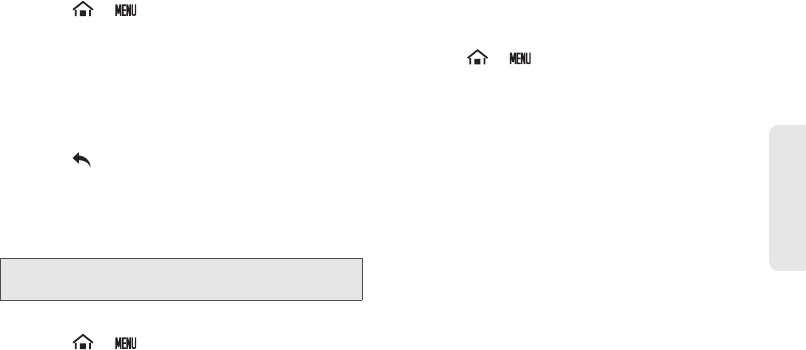
2B. Settings 41
Settings
Ⅲ Any changes or updates to your Gmail account
are then automatically updated to your device.
To configure Google management settings:
1. Touch > > Settings > Accounts & sync.
2. Touch the Google account name to open the
account’s synchronization settings screen.
3. Touch the types of data you wish to synchronize
(Sync Picasa Web Albums, Sync Calendar,
Sync Contacts, or Sync Gmail). (A check mark
indicates the feature is enabled.)
4. Touch to return to the previous screen.
Synchronizing Your Corporate Account
By default, your device doesn’t manage any corporate
accounts. These must be manually added.
To add a new corporate account:
1. Touch > > Settings > Accounts & sync.
2. Touch Add account > Corporate.
3. Follow the onscreen prompts to create your new
corporate email account.
Ⅲ Any changes or updates to your corporate
account are then automatically updated to your
device.
To configure the corporate management settings:
1. Touch > > Settings > Accounts & sync.
2. Touch the account name to open the account’s
synchronization settings screen.
3. Touch the settings you wish to change.
ⅢAccount settings:
●Account name displays the name used by the
device to track the account.
●Your name displays the name used in the
From field within your outgoing email.
●Email check frequency configures the
frequency which the device queries the
remote server for new email changes. Choose
from: Automatic (Push), Never,
Every 5 minutes, Every 10 minutes,
Every 15 minutes, Every 30 minutes, or
Every hour.
Note: Once a corporate email account is created, it is
automatically added as a managed account.

42 2B. Settings
●Amount to synchronize assigns the sync
range for incoming and outgoing email
between your device and your external
exchange server. To specify the period that the
device and server should synchronize email,
choose from: One week, Two weeks, or
One month.
●Default account assigns this account as the
default used when sending out new email.
●Email notifications displays a status bar icon
() when new email has been received.
●Select ringtone assigns an audible ringtone
when a new or upcoming event is pending.
●Vibrate assigns a vibration when a new or
upcoming event is pending.
●Incoming settings provides access to the
domain, password, and exchange server
parameter fields.
●Sync contacts synchronizes the contacts
between your device and the remote
exchange server.
●Forward with files includes any attached files
with forwarded email messages.
●Signature allows you to create an outgoing
email signature attached to new email sent
from your device.
4. Touch to return to the previous screen.
Search Settings
You can use your device’s search settings to configure
some aspects of Google Web search (for example,
whether it makes suggestions below the Quick Search
Box as you type), and what device features you want to
include in searches.
Configuring the Search Settings
1. Touch > > Settings > Search.
2. Touch any of the following search options to
change the settings:
Ⅲ Google search settings opens a screen where
you can set your Google search preferences.
●Show web suggestions also includes search
matches from Google’s online search engine.

2B. Settings 43
Settings
●Search history determines whether you also
wish to include personalized search history
results in the list of matches.
●Manage search history helps to manage the
personalized search history associated with
your current registered Google account.
ⅢSearchable items opens a screen where you can
choose the search categories included in device
searches.
●Categories include: Browser, Contacts, Apps,
Music, and Voicemail.
Ⅲ Clear search shortcuts erases the history of
recently selected search results.
Messaging Settings
Your device’s advanced messaging capabilities let you
send and receive many different kinds of messages
without placing a voice call.
Adjusting Message Settings
1. Touch > > Messaging > > Settings.
2. Adjust the following fields according to your needs:
ⅢDelete old messages: Enable this option to
automatically delete old messages when a
predetermined limit is reached.
ⅢText message limit: Set the number of text
messages to save.
ⅢMultimedia message limit: Set the number of
multimedia messages to save.
ⅢAuto-retrieve: Enable this option to automatically
retrieve the entire contents of your MMS message.
When selected, the MMS message header,
message body, and any attachments will
automatically download to your device. If you
disable this option, only the MMS message
header will be retrieved and shown in the
message list.
ⅢRoaming auto-retrieve: Disable this option if you
want only the MMS message headers to
download while roaming. Enable this option to
automatically download your complete
multimedia messages even while roaming.
ⅢNotifications: Enable this option if you wish to
receive a notification on the status bar when a
new text or multimedia message arrives.

44 2B. Settings
ⅢSelect ringtone: Set a ringer to sound when a
new message is received. After selecting this
option, select a unique ringtone for new text and
multimedia messages. A sample will play briefly
upon selection.
ⅢVibrate: Enable this option if you want the device
to vibrate when a new text or multimedia
message is received.
Airplane Mode
Airplane Mode allows you to use many of your device’s
applications when you are in an airplane or in any
other area where making or receiving calls or data is
prohibited. When you set your device to Airplane Mode,
you cannot make or receive any calls or access online
information.
1. Press and hold . The Phone options window
appears.
2. Touch Airplane mode (Airplane mode is OFF) to
enable. Touch Airplane mode (Airplane mode is ON)
to disable.
– or –
1. Touch > > Settings > Wireless & networks.
2. Touch Airplane mode. (A check mark indicates this
feature is enabled. Touch Airplane mode again to
disable the feature.)
While in Airplane Mode, the airplane mode icon ( )
will appear on the status bar.
TTY Use With Sprint Service
A TTY (also known as a TDD or Text Telephone) is a
telecommunications device that allows people who are
deaf, hard of hearing, or who have speech or language
disabilities to communicate by telephone.
Your device is compatible with select TTY devices.
Please check with the manufacturer of your TTY device
to ensure that it is compatible with digital cell phones.
Your device and TTY device will connect via a special
cable that plugs into your device’s headset jack. If this
cable was not provided with your TTY device, contact
your TTY device manufacturer to purchase the
connector cable.

2B. Settings 45
Settings
To turn TTY Mode on or off:
1. Touch > > Settings > Call settings >
TTY mode.
2. Touch an option:
ⅢTTY Off: Disables TTY mode.
ⅢTTY Full: Enables TTY mode.
ⅢTTY HCO: Enables TTY in Hearing Carry Over
mode and you can hear.
ⅢTTY VCO: Enables TTY in Voice Carry Over mode
and you can talk.
The TTY icon ( ) will appear on the status bar when
your device is in TTY mode.
To access the state Telecommunications Relay
Service (TRS) for assistance with TTY calls:
ᮣDial and touch to reach an
operator.
For additional information about Sprint Relay Services
and TTY compatibility, call Sprint Relay Customer
Service at 800-676-3777 or visit www.sprintrelay.com.
Note: When enabled, TTY mode may impair the audio quality
of non-TTY devices connected to the headset jack.
WARNING: 911 Emergency Calling
Sprint recommends that TTY users make
emergency calls by other means, including
Telecommunications Relay Services (TRS),
analog cellular, and landline communications.
Wireless TTY calls to 911 may be corrupted
when received by public safety answering points
(PSAPs), rendering some communications
unintelligible. The problem encountered appears
related to software used by PSAPs. This matter
has been brought to the attention of the FCC,
and the wireless industry and the PSAP
community are currently working to resolve this.

46 2B. Settings
Using the Hearing Aid Device
Compatibility Function
Your device has been tested and rated for hearing aid
device compatibility. To use this function effectively, set
the hearing aid option to On.
1. Touch > > Settings > Sound & display.
2. Touch Hearing Aid. (A check mark indicates this
feature is enabled.)
For more information about hearing aid device
compatibility, see “Using Your Device With a Hearing
Aid Device” on page 126.
Security Settings
Your Device’s Unlock Pattern Feature
You can increase your device’s security by creating a
screen unlock pattern (disabled by default). When
enabled, you must draw the correct unlock pattern on
the screen to unlock and regain access to the device.
Creating an Unlock Pattern
1. Touch > > Settings > Location & security >
Set unlock pattern.
2. Read the information on the screen, and then
touch Next.
3. Review the onscreen tutorial on pattern creation,
and then touch Next.
4. Draw your pattern by touching your first onscreen
point, and then, without removing your finger from
the screen, drag your finger over adjacent points
until all the points are connected by a gray line and
each is highlighted with a green circle.
5. When you have connected at least four dots in a
vertical, horizontal, or diagonal direction, lift your
finger from the screen.
6. Touch Continue to record the pattern.
7. Confirm the new pattern by redrawing it and then
touch Confirm.
Important: You must slide your finger on the screen to create
the pattern and not touch individual dots. If you
make a mistake or a point is not properly
selected, a red circle will appear.
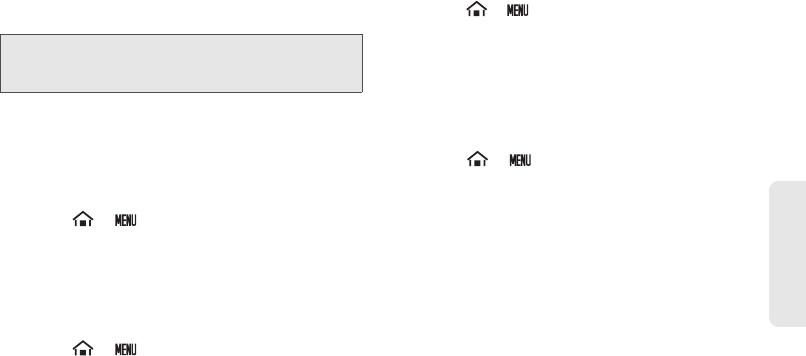
2B. Settings 47
Settings
The next time you turn on the device or the screen, you
will need to draw the unlock pattern that you created in
the preceding steps.
Configuring the Unlock Pattern Settings
After an unlock pattern is created, additional options
are available in the Location & security menu.
To hide the unlock drawing pattern:
1. Touch > > Settings > Location & security.
2. Touch Use visible pattern to deselect this option.
ⅢClearing this option prevents the unlock pattern
from displaying on the unlock screen.
To vibrate the screen when you draw the pattern:
1. Touch > > Settings > Location & security.
2. Touch Use tactile feedback to select the option.
To change the unlock pattern:
1. Touch > > Settings > Location & security >
Change unlock pattern.
2. Draw the current unlock pattern on the screen.
3. Follow steps 4-8 in “Creating an Unlock Pattern” to
register a new unlock pattern.
To reset the unlock pattern:
1. Touch > > Settings > Location & security.
2. Clear the Require pattern check box.
3. Draw the current unlock pattern.
What to do if you have forgotten your pattern:
If you fail to draw the correct unlock pattern on the
screen after five attempts, you are prompted to wait for
30 seconds before you can try again.
ᮣIf you have forgotten your screen unlock pattern,
touch Forgot pattern? and sign in using your
Google Account name and password to create a
new screen unlock pattern before regaining
access to the Home screen.
Note: You can make calls to 911 even if the screen is
locked. Touch Emergency call to open the
Emergency Dialer screen.

48 2B. Settings
Setting Visible Password
This feature shows your passwords as you type them.
1. Touch > > Settings > Location & security.
2. Touch the Visible passwords check box to select
this feature.
Setting Security Storage
This feature allows applications to access secure
certificates.
1. Touch > > Settings > Location & security >
Set password.
2. Enter and confirm your password and touch OK.
Credential storage is enabled.
3. Confirm the Use secure credentials check box is
selected.
4. To cancel this feature, touch Clear storage > OK.
Installing Encrypted Certificates From the
SD Card
1. Touch > > Settings > Location & security >
Install from SD card.
2. Touch an available certificate.
3. Follow the onscreen instructions.
Application Settings
Application Settings allows you to manage applications
installed in the device.
To install non-Market applications:
1. Touch > > Settings > Applications.
2. Touch Unknown sources. (A check mark indicates
this feature is enabled.)
Note: You can change the password by touching
Set password and then entering the current and new
passwords.
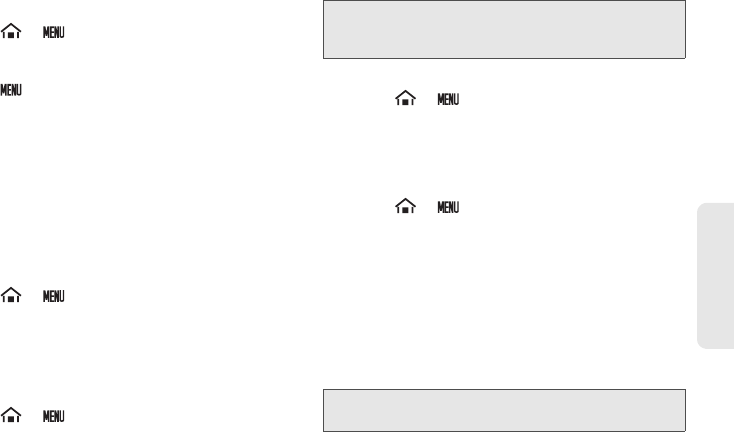
2B. Settings 49
Settings
To configure the Manage applications screen:
1. Touch > > Settings > Applications >
Manage applications. The Manage applications
screen appears.
2. Touch for the following options:
ⅢSort by size: to sort the applications on the
Manage applications screen from largest to
smallest.
ⅢSort: to sort the applications on the Manage
applications screen alphabetically.
ⅢFilter: to select the applications to be displayed on
the Manage applications screen. Select from All,
Running, and Downloaded.
To clear an application’s cache or data:
1. Touch > > Settings > Applications >
Manage applications.
2. Touch an application > Clear data or Clear cache.
3. Touch OK to confirm.
To uninstall downloaded applications:
1. Touch > > Settings > Applications >
Manage applications.
2. Touch the application you wish to remove and
touch Uninstall > OK.
To view and control currently running services:
1. Touch > > Settings > Applications >
Running services .
2. Touch an available service to manage it further.
To set options for application development:
1. Touch > > Settings > Applications >
Development.
2. The following options are available:
ⅢUSB debugging: to enable debug mode when
USB is connected. Read the disclaimer and touch
OK to confirm.
ⅢStay awake: to prevent the screen from going into
sleep mode while charging.
ⅢAllow mock locations: to allow mock locations.
Important: Only applications that you have installed yourself
can be uninstalled. Preinstalled applications
cannot be removed.
Note: Unless you have a specific reason for changing these
settings, you should leave them at the default settings.
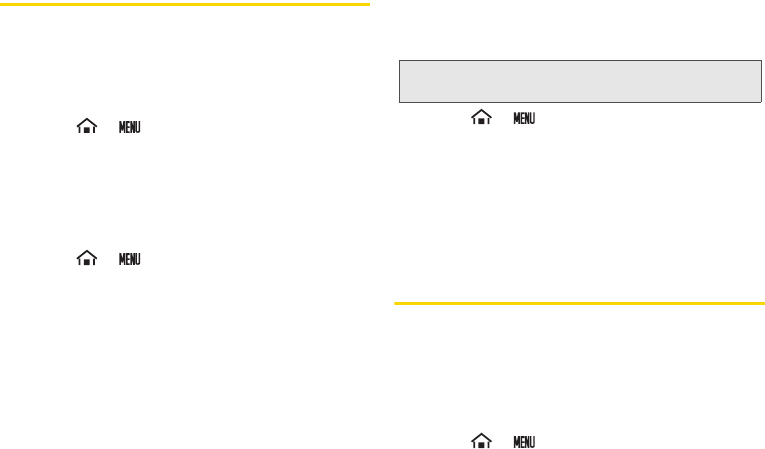
50 2B. Settings
Privacy Settings
Using Your Location
You can give permission to use your location for some
Google services, such as Google Search and Google
Maps.
1. Touch > > Settings > Privacy.
2. Touch Use My Location. (A check mark indicates
this feature is enabled.)
Backing Up Your Settings
You can back up your settings to a Google server.
1. Touch > > Settings > Privacy.
2. Touch Back up my settings. (A check mark
indicates this feature is enabled.)
Resetting Your Device
Resetting the device restores all the factory defaults,
including the ringer types and display settings. All data,
including downloaded applications are deleted.
1. Touch > > Settings > Privacy >
Factory data reset. (You will see a disclaimer.)
2. Read the disclaimer and touch Reset phone.
3. If required, draw your unlock pattern to confirm the
reset process.
4. If you are certain that you would like to restore all
factory settings, touch Erase everything.
Accessibility Settings
When you download an application with an
accessibility feature, it may be listed under Accessibility
settings and its settings might be configured by
touching the application.
To display the list of downloaded applications with
accessibility features:
ᮣTouch > > Settings > Accessibility.
Important: Back up your important data before you perform
a factory reset of the device.
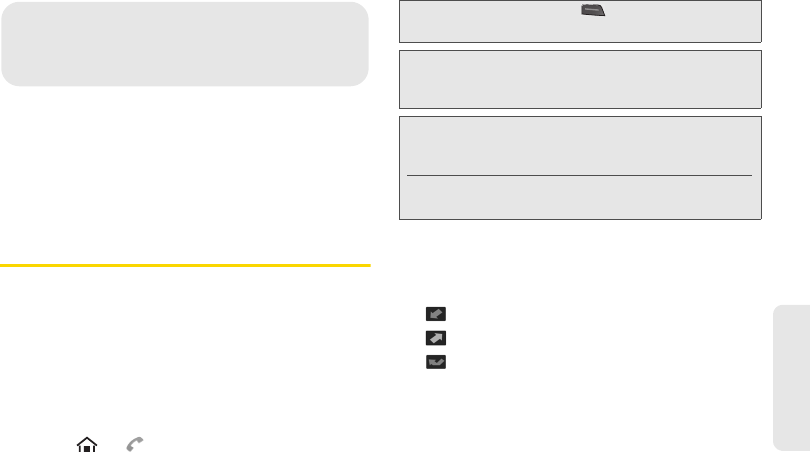
2C. Call Log 51
Call Log
ࡗViewing the Call Log (page 51)
ࡗCall Log Options (page 52)
ࡗMaking a Call From the Call Log (page 52)
ࡗSaving a Number From the Call Log (page 52)
ࡗErasing the Call Log (page 53)
Viewing the Call Log
The call log is a list of the phone numbers (or Contacts
entries) for calls you placed, accepted, or missed. The
call log makes redialing a number fast and easy. It is
continually updated as your device automatically adds
new numbers to the beginning of the list.
Each entry contains the phone number (if it is
available) and Contacts entry name (if the number is in
your Contacts).
ᮣTouch > > Call log.
Call Log Icons
You can determine if an entry was an incoming,
outgoing, or missed call from the icons shown below.
= Incoming Call
= Outgoing Call
= Missed Call
2C. Call Log
Shortcut: You can also press from standby mode to
display your call log.
Tip: Drag the status bar down to reveal the Notifications panel
to see a missed call notification. See “Missed Call
Notification” on page 26.
Note: The call log records only calls that occur while the
device is turned on. If a call is received while your
device is turned off, it will not be included in the call log.
If you return a call from the voicemail menu, it will not be
included in your device’s call log.

52 2C. Call Log
Call Log Options
ᮣTouch a call log entry to open the overview page
where the call details are displayed at the top and
any available options are listed underneath:
ⅢCall [contact] to return the phone call.
ⅢSend text message to send a text message to the
entry.
ⅢView contact/Add to contacts to display the entry's
information or save the number to Contacts.
ᮣTouch and hold an entry to display the options
menu:
ⅢCall [number] to return the phone call.
ⅢView contact/Add to contacts to display the entry’s
information or save the number to Contacts.
ⅢEdit number before call to edit the number and
then call the number.
ⅢSend text message to send a text message to the
entry.
ⅢRemove from call log to delete the call information
from call log.
ᮣTouch > Clear call log to delete all call log
entries.
Making a Call From the Call Log
ᮣPress and touch adjacent to the entry you
would like to call.
Saving a Number From the Call Log
1. Touch an entry.
2. Touch Add to contacts.
3. From the Contacts screen, touch
Create new contact or touch an existing Contact
entry name to save the number to an existing entry.
4. Touch any field to enter the details.
5. Enter all the necessary details and touch Done to
save.
Once you have saved the number, the call log list
reflects the newly saved data.

2C. Call Log 53
Call Log
Erasing the Call Log
You can delete either an individual or all current entries
from your call log list.
To delete a single call log entry:
1. Press and touch and hold an entry you want
to delete.
2. Touch Remove from call log.
To delete all call log entries:
ᮣPress and touch > Clear call log.
Note: You cannot save phone numbers from calls identified
as Unknown, No Caller ID, Restricted or
Private Number.
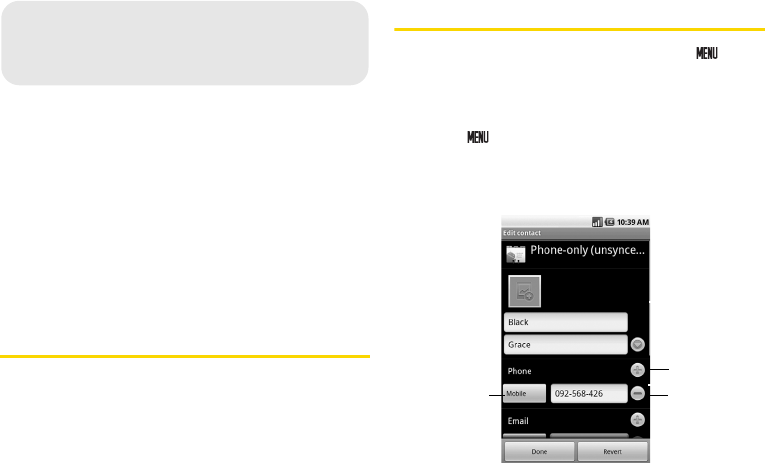
54 2D. Contacts
ࡗDisplaying the Contacts List (page 54)
ࡗAdding a New Contacts Entry (page 54)
ࡗContacts Entry Options (page 55)
ࡗEditing a Contacts Entry (page 56)
ࡗAssigning a Ringer Type for an Entry (page 56)
ࡗAssigning a Picture to an Entry (page 56)
ࡗFinding Contacts Entries (page 57)
ࡗDeleting Entries (page 57)
ࡗAdding Entries to Your Favorites (page 57)
Displaying the Contacts List
ᮣOn the Home screen, touch Contacts.
Your device automatically sorts the Contacts entries
alphabetically.
Adding a New Contacts Entry
1. On the Home screen, touch Contacts > >
New contact.
– or –
Enter a phone number on the Phone screen and
touch > Add to contacts > Create new contact.
2. Touch any field to launch the keyboard, and enter
the name, phone number, email, and other contact
details.
2D. Contacts
Add field
button
Remove
field button
Field label
button

2D. Contacts 55
Contacts
ⅢTouch to assign a picture to the entry. See
“Assigning a Picture to an Entry” on page 56.
ⅢTo add more fields, touch the Add field button. To
remove a field, touch the Remove field button.
ⅢTo change the field label, touch the Field label
button and touch an available option.
ⅢScroll up or down to move through the contact
fields.
3. To save a contact, touch Done.
Contacts Entry Options
ᮣTouch the picture ID ( ) to display icons of
available applications, and then touch an icon to
launch an application.
ᮣTouch, or touch and hold, a Contacts entry for the
following options:
ⅢCall [number/label] or Call contact to call the
contact.
ⅢText [number/label] or Text contact to send a text
message to the contact.
ⅢEmail [label] to send an email to the contact.
ⅢView contact to display the contact's overview
page.
ⅢAdd to favorites/Remove from favorites to add the
contact to, or remove the contact from, the
favorites list.
ⅢEdit contact to edit the contact's details.
ⅢDelete contact to delete the current Contacts entry
from your device.
ᮣTouch a Contacts entry and then touch :
ⅢEdit contact to edit the entry.
ⅢShare to share the data via messaging.
ⅢOptions to assign a ringtone to the entry or to
send calls from the entry directly to voicemail.
ⅢDelete contact to delete the entry.
Tip: ICE - In Case of Emergency
To make it easier for emergency personnel to identify
important contacts, you can list your local emergency
contacts under “ICE” in your device’s Contacts list. For
example, if your mother is your primary emergency
contact, list her as “ICE–Mom” in your Contacts. To list
more than one emergency contact, use “ICE1–___,”
“ICE2–___,” etc.

56 2D. Contacts
Editing a Contacts Entry
1. From the Contacts list, touch and hold the entry
you want to edit, and touch Edit contact.
2. Touch the field you wish to edit, and then add or
edit the information.
3. Touch Done to save your change.
Assigning a Ringer Type for an Entry
Assign a ringer type to a Contacts entry so that you can
identify the caller by the ringer type.
1. From the Contacts list, touch an entry > >
Options.
2. Touch Ringtone, select an option and touch OK.
Assigning a Picture to an Entry
Assign a picture to display each time a certain contact
calls you.
1. From the Contacts list, touch and hold the entry
you want to assign a picture to, and touch
Edit contact.
2. Touch and select an image to assign in one of
the following ways:
ⅢTouch and select an image from your Gallery.
ⅢTouch on the top right of the screen to take a
new picture and assign it to this entry. Touch
to return to your Gallery and touch and select the
new image.
3. Crop the image as required and touch Save to
assign the image.

2D. Contacts 57
Contacts
Finding Contacts Entries
1. From the Contacts list, touch .
2. Enter the contact's name. As you type, contacts
with matching names appear below the search
box.
3. Touch a matching contact in the list to open its
Details screen.
Deleting Entries
1. From the Contacts list, touch and hold the entry
you want to delete, and touch Delete contact.
2. Touch OK to confirm the deletion.
Adding Entries to Your Favorites
The Favorites tab is a listing that can help you quickly
access your most used or preferred Contacts entries.
1. On the Home screen, touch Contacts.
2. Touch the contact you want to add to Favorites.
3. Touch the star to the right of the contact’s name.
The star turns gold.
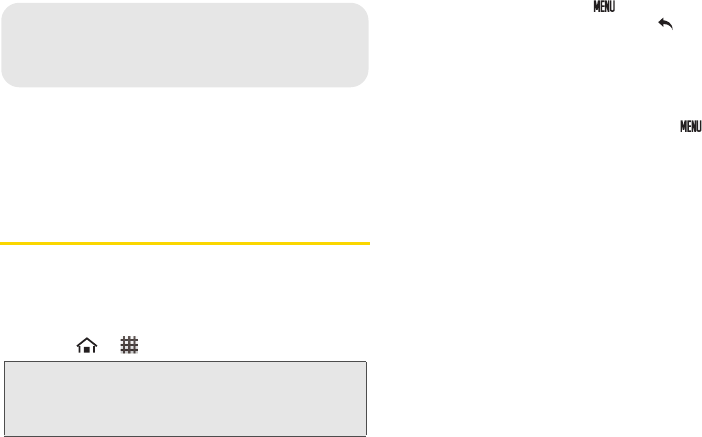
58 2E. Calendar & Tools
ࡗCalendar (page 58)
ࡗAlarm Clock (page 61)
ࡗCalculator (page 63)
ࡗUpdating Your Device (page 63)
Calendar
Your Calendar helps organize your time and reminds
you of important events.
Viewing the Calendar
1. Touch > > Calendar.
2. To change a view, touch and select Agenda,
Day, Week, Month, or Today. Touch to hide the
menu options.
Adding an Event to the Calendar
1. On the Calendar screen, touch a day to which you
would like to add an event and touch >
New event.
2. Touch the What field and enter a title for the event.
3. Select a From/To dates for the event by touching
the corresponding fields, and adjusting the month,
day, and year by tapping + or -.
ⅢTouch Set when finished.
4. Select a time for the event by touching the time
field and then adjusting the hour and minute by
tapping + or -.
ⅢTouch the AM or PM button to change the value
when the 24 hour setting is not on. See “Adjusting
the Date and Time Manually” on page 38.
ⅢTouch Set when finished.
5. Touch the All day field to assign this as an all day
event. If assigned, the time fields are removed.
Note: If you have not already signed into your Google
account via your device, you may be asked to do so
before you can access the Calendar. (See “Creating a
Google Account” on page 110.)
2E. Calendar & Tools

2E. Calendar & Tools 59
Calendar / Tools
6. Enter a location for the event in the Where field.
7. Enter a description for the event in the Description
field.
8. Enter the email addresses of the people you want
to invite to the event in the Guests field. If they use
Google Calendar, they’ll receive an invitation in
their calendar as well as by email.
9. Select a recurrence cycle for the event by touching
the Repetition field.
10. Select a reminder time by touching the Reminders
field.
ⅢTouch - to remove a Reminder.
ⅢTouch + to enter additional Reminder.
11. Touch Done to save the event.
Event Reminders
When you have an upcoming event, the calendar icon
appears on the status bar.
1. Touch the status bar, and then slide your finger
down the screen to open the Notifications panel.
2. Touch an upcoming event name from the
onscreen list to display the event within the
Calendar notifications screen.
3. Choose from the following options:
ⅢTouch an event item on the list to edit the
reminder option.
ⅢTouch Snooze all to postpone all event reminders
for five minutes.
ⅢTouch Dismiss all to dismiss all event reminders.
ⅢTouch to keep these reminders in place and
close the Notifications panel.
To configure event reminder settings:
1. From the Calendar screen, touch > More >
Settings.
2. Configure the following options:
ⅢSet alerts & notifications to specify how you are
reminded of upcoming events, Alert,
Status bar notification, or Off. You must have a
reminder assigned to an event for this to be
active.
ⅢSelect ringtone to select an audio ringtone that will
sound as a reminder. Touch a ringtone to play an
Note: A maximum of five Reminder fields can be added.

60 2E. Calendar & Tools
audio sample. Touch OK to accept the ringtone
assignment.
ⅢVibrate to add a vibration feature to the reminder.
This is useful if your device is muted or you are in
a noisy environment.
ⅢDefault reminder time to assign a default time for
every new event reminder. This becomes the
default reminder time.
3. Touch to return to the calendar.
Viewing Events
1. Touch > > Calendar > > Agenda.
2. Touch an event to display the details.
Going to the Current Day’s Calendar Menu
ᮣFrom the Calendar screen, touch > Today.
Editing an Existing Event
1. Touch > > Calendar > > Agenda.
2. Touch an event to reveal the event details.
3.
Touch >
Edit event
. If the event is a repeating
event, you will be prompted to select
Change only this event
,
Change all events in the series
,
or
Change this and all future events
.
4. Edit the name, location, repetition, reminders, etc.
5. Touch > Show extra options for further options.
ⅢShown me as: Select your status to display as
Busy or Available.
ⅢPrivacy: Select your privacy setting from Default,
Private, or Public.
6. Scroll to the bottom of the page and touch Done to
save the changes.
Erasing a Day’s Events
1. Touch > > Calendar > > Agenda.
2. Touch an event to reveal the event details.
3. Touch > Delete event > OK.
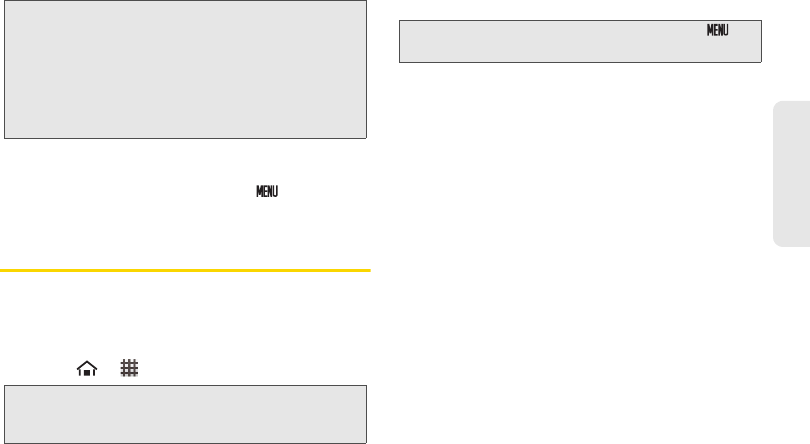
2E. Calendar & Tools 61
Calendar / Tools
Hiding Declined Events
ᮣFrom the Calendar screen, touch > More >
Settings > Hide declined events.
Alarm Clock
Your device comes with a built-in alarm clock that has
multiple alarm capabilities.
Setting an Alarm
1. Touch > > Alarm Clock.
2. Touch an alarm to select it.
3. Touch the Time field to adjust the hour and minute
by tapping + or -.
ⅢTouch the AM or PM button to change the value if
the 24 hour setting is not on.
ⅢTouch Set when finished.
4. Touch Ringtone to select a ringtone that will play as
an alarm.
ⅢTouch a ringtone to hear a sample.
ⅢTouch OK to accept the ringtone assignment.
5. Touch Vibrate to add a vibration feature to the
alarm.
6. Touch the Repeat field to select a repeat status for
the alarm.
ⅢSelect the days you want the alarm to be active
and touch OK.
7. Enter a unique name for this alarm by touching the
Label field, entering a new label, and touching OK.
Note: If the day for which you are erasing events contains a
repeating event, you will be prompted to select
Only this event, This & future events, or All events.
Select Only this event to erase a single occurrence,
This & future events to erase this event going forward,
All events to erase all occurrences of the event (past/
present/future), or Cancel to cancel the deletion of the
repeating event.
Note: When you first open the alarm clock, three alarms are
set up by default and ready for you to customize. These
alarms are turned off by default.
Note: A new alarm can also be created by touching >
Add alarm.
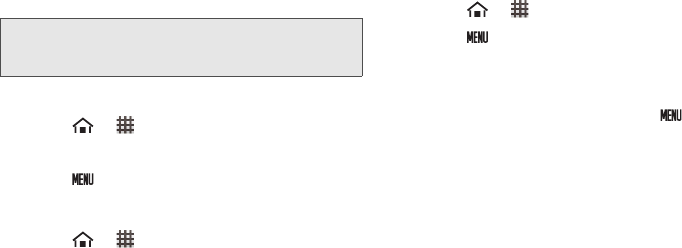
62 2E. Calendar & Tools
8. Touch Done to return to the Alarm clock. A check
mark indicates the alarm is set for the event.
To delete an Alarm:
1. Touch > > Alarm Clock.
2. Select an alarm.
3. Touch > Delete alarm.
To customize the onscreen clock:
1. Touch > > Alarm Clock.
2. Touch the onscreen alarm clock.
3. Scroll your finger across the bottom field to view
available options.
4. Touch the desired image to activate the new clock
face.
To hide the onscreen clock:
1. Touch > > Alarm Clock.
2. Touch > Hide clock.
Alarm Settings
ᮣFrom the Alarm clock screen, touch > Settings.
ⅢAlarm in silent mode to sound the alarm even
while the device is in silent mode.
ⅢAlarm volume to set the alarm volume.
ⅢSnooze duration to set the snooze duration from 5
to 30 minutes in 5 minute intervals.
ⅢSide button behavior to select the behavior of the
side buttons when pressed while the alarm
sounds. Choose from: None, Snooze, or Dismiss.
Note: The number of hours and minutes left before the alarm
goes off is briefly displayed onscreen after you set the
new alarm time.
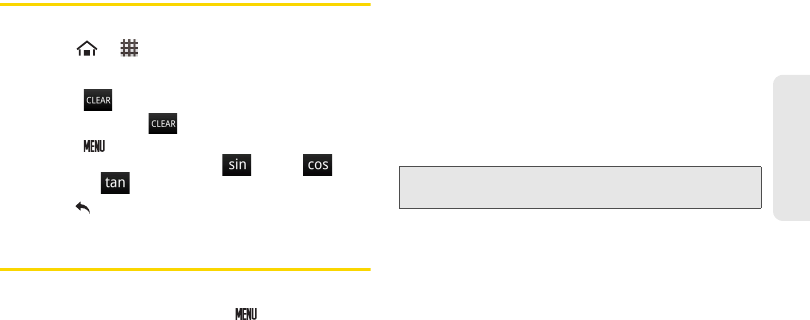
2E. Calendar & Tools 63
Calendar / Tools
Calculator
Your device comes with a built-in calculator.
1. Touch > > Calculator.
2. Enter numbers by touching the onscreen keys.
ⅢTouch to clear a number.
ⅢTouch and hold to clear an entire number.
ⅢTouch > Advanced panel to access more
advanced features such as (Sine),
(Cosine), (Tangent) etc.
3. Touch to close the calculator.
Updating Your Device
You can update your device using the Update options.
ᮣFrom the Home screen, touch > Settings >
About phone.
ⅢUpdate Android to download and install Android
updates. Select Check for Android Updates Now or
Scheduled Check.
ⅢUpdate Firmware to automatically download and
install any available updates. You may be required
to power your device off and back on to complete
the software upgrade.
ⅢUpdate Profile to automatically update your online
user profile information. If you choose to change
your user name and select a new one online, you
must then update the user name on your device.
ⅢUpdate PRL to automatically update the PRL
(preferred roaming list).
Note: You can also update your device from the Sprint Zone.
(See page 111.)
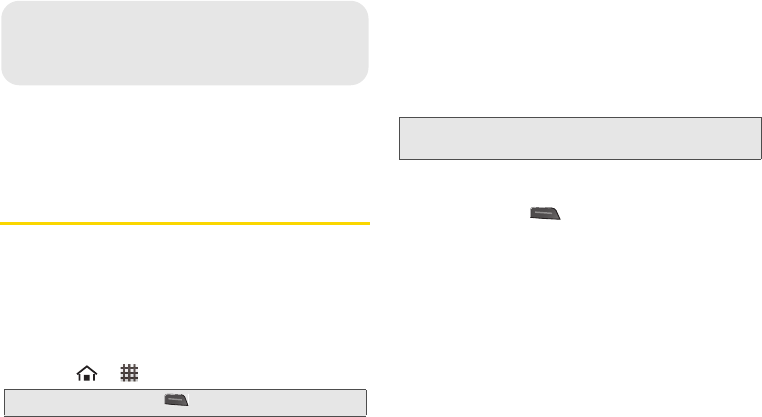
64 2F. Voice Services
ࡗAutomatic Speech Recognition (ASR) (page 64)
ࡗText-to-Speech (page 65)
Automatic Speech Recognition
(ASR)
You can use your device’s built-in automatic speech
recognition (ASR) software (Voice Dialer) to dial a phone
number in your Contacts or to launch device functions. All
you have to do is talk into the device, and ASR will
recognize your voice and complete tasks by itself.
Activating the Voice Dialer
ᮣTouch > > Voice Dialer.
The device prompts you to say a command from the
list displayed onscreen. When the application
recognizes the command, it executes the command
right away.
If the application does not recognize the number,
name, or application name, it will find the most likely
matches and display a list. Touch a selection or touch
Cancel to exit the Voice Dialer.
Making a Voice Call With the Voice Dialer
1. Press and hold .
2. When prompted to speak, say “Call [contact]” or
“Dial [number].”
ⅢFor example, say “Call John Smith on mobile,” to
call John Smith’s mobile phone. Your device dials
the number stored for the contact “John Smith”
with the label “Mobile.”
Shortcut: Press and hold .
2F. Voice Services
Tip: Use ASR in a quiet environment so it can accurately
recognize your commands.

2F. Voice Services 65
Voice Services
Opening an Application With the
Voice Dialer
1. Press and hold .
2. When prompted to speak, say “Open [application
name].”
ⅢFor example, say “Open Calendar,” to open the
Calendar. The application screen is displayed.
Opening a Settings Menu With the
Voice Dialer
1. Press and hold .
2. When prompted to speak, say “Open [settings menu
name].”
ⅢFor example, say “Open sound & display settings.”
The settings menu screen is displayed.
Text-to-Speech
Your device can convert text into speech in some
downloaded applications. You may select the language
you hear or adjust its speed.
1. Touch > > Settings > Text-to-speech.
2.
Touch
Install voice data
and download and install
the voice data from Android Market. (You will be
asked to set up a Google Account if you have not
already done so. See “Creating a Google Account ”
on page 110.) Once the data is installed, you can
access other Text-to-speech menus.
3. Touch Speech rate and select a speed.
4. Touch Language and select a language.
5. Touch Listen to an example to play a short
demonstration of the set speech synthesis.
6. Touch the Always use my settings check box to
keep your settings.
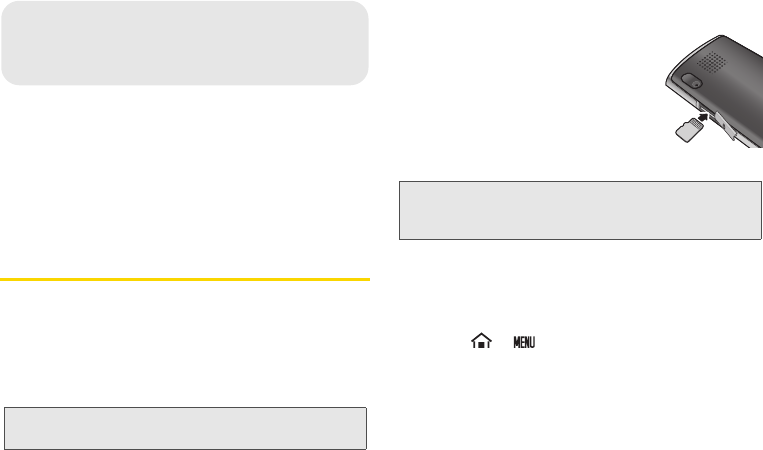
66 2G. microSD Card
ࡗYour Device’s microSD Card and Adapter (page 66)
ࡗmicroSD Card Settings (page 68)
ࡗConnecting Your Device to Your Computer (page 68)
ࡗImportant Connection Information (page 69)
Your Device’s microSD Card and
Adapter
The microSD Card
Your device is equipped with a microSDTM (Secure
Digital) memory card to expand the device’s available
memory space. It allows you to store images, videos,
and music data in your device.
Inserting the microSD Card
1. Open the microSD card slot cover.
2. Insert a microSD card into the slot
with the metal contacts facing the
back of the device.
3. Gently push the microSD card until
it snaps into place.
4. Close the microSD slot cover.
Removing the microSD Card
When you need to remove the
microSD card
while the
device is turned on, you must unmount the
card
first to
avoid damaging it or corrupting stored data.
1. Touch > > Settings >
SD card, USB Mass Storage & phone storage.
2. Touch Unmount SD card.
3. Open the microSD card slot cover.
4. Gently push the microSD card inward to eject it.
Note: You cannot download application files to the microSD
card.
2G. microSD Card
Note: Be sure to use only recommended microSD cards (up
to 32GB). Using non-recommended microSD cards
could cause data loss and damage your device.

2G. microSD Card 67
microSD Card
5. Remove the card from the slot and close the slot
cover.
microSD Adapter
The supplied microSD adapter allows you to use
microSD cards in other SD-compatible devices, like
computers, cameras, and printers. Before using the
microSD card with an SD-compatible device, you will
need to insert the microSD card into the microSD
adapter.
To insert the microSD card into the microSD adapter:
ᮣWith the label side of the microSD card facing up,
insert the card into the supplied microSD adapter,
and gently slide the card until it is fully inserted.
To remove the microSD card from the microSD adapter:
ᮣHold the front edge of the microSD card, and
gently pull it out to remove it from the adapter.
Write Protection
The microSD adapter has a built-in Write Protection
lock to prevent accidental overwriting or removal of
your data when the microSD card and adapter are
inserted in another device.
ᮣSlide the Write Protection lock tab down into the
“Lock” position to prevent overwriting of data. To
allow data to be added or removed from the
microSD card, slide the Write Protection lock tab
up into the normal position.
Note: You can easily damage the microSD card and its
adapter by improper operation. Please be careful when
inserting, removing, or handling it.
DO NOT remove a microSD card while files are being
accessed or transferred. Doing so will result in loss or
damage of data.
Make sure your battery is fully charged before using the
microSD card. Your data may become damaged or
unusable if the battery runs out while using the
microSD card.

68 2G. microSD Card
microSD Card Settings
Viewing Card and Device Memory
Your device allows you to review the memory allocation
of both your device’s internal storage and that of the
microSD card.
1. Touch > > Settings >
SD card, USB Mass Storage & phone storage.
2. Review the available information.
ⅢThe storage capacity page is divided into two
sections: SD card and Internal phone storage.
3. Touch to return to the previous page.
Formatting the microSD Card
Formatting a microSD card permanently removes all
files stored on the card.
1. Touch > > Settings >
SD card, USB Mass Storage & phone storage.
2. Touch Unmount SD card to release the microSD
card from its use by the device. The icon
appears on the status bar to indicate the card is
unmounted.
3. Once released, touch Format SD card >
Format SD card > Erase everything.
ⅢOnce completely formatted, the card is
automatically remounted (reconnected for use by
the device).
Connecting Your Device to Your
Computer
Before using your device’s mass storage capabilities,
you need to prepare your device’s data services to
synchronize with your desktop or laptop computer.
Once you have connected the device to the computer,
you can transfer your data to or from the microSD card.
Important: The formatting procedure erases all the data on
the microSD card, after which the files CANNOT
be retrieved. To prevent the loss of important data,
please check the contents before you format the
card.

2G. microSD Card 69
microSD Card
1. Connect your device to your computer using a
compatible USB cable. (Wait for the connection to
be completed. When connected, the host
computer will automatically detect your device.)
2. The USB icon ( ) now appears on the left side of
the status bar on your device.
3. Drag the status bar down, or from the Home
screen, touch > Notifications to open the
Notifications panel.
4. Touch USB connected > Mount to copy files
between your computer and your device's
microSD card.
5. Locate the newly created drive letter on your
computer. You can now begin to use the microSD
card as a storage device.
To remove the connection:
ᮣWhen you have finished transferring data, click the
USB device icon on you computer's taskbar, and
follow the onscreen instructions to safely unplug
the USB cable.
Important Connection Information
ⅷNo driver installation is required for Windows 2000/
ME/XP/Vista/7 users. If you use Windows 98/98SE,
you have to download and install the USB Mass
Storage Driver from the Sprint website at
www.sprint.com.
ⅷTo avoid loss of data, DO NOT remove the USB
cable, the microSD card, or the battery while files are
being accessed or transferred.
ⅷDO NOT use your computer to change or edit folder
or file names on the microSD card, and do not
attempt to transfer large amounts of data from the
computer to the microSD card. Doing so may cause
the microSD card to fail.
ⅷDO NOT turn off or restart your computer, or put it
into standby mode, while using a mass storage
device. Doing so will result in loss or damage of data.
ⅷThe internal microSD card can only be mounted for
use by either the device or a connected computer.
Prior to accessing the card via a different method, it
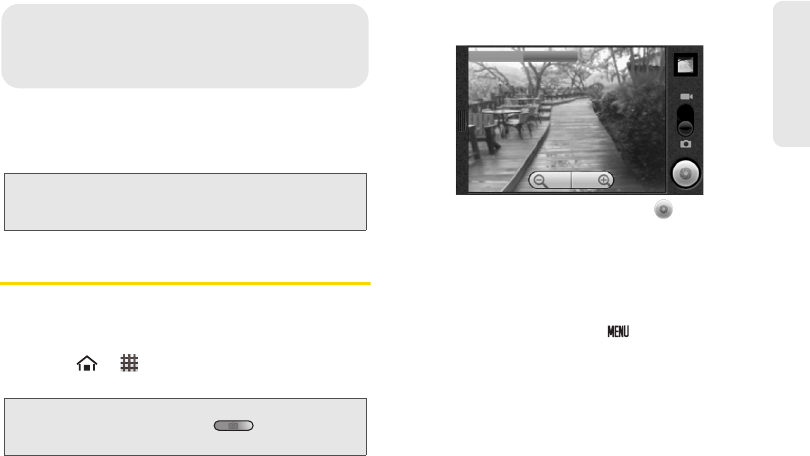
2H. Camera 71
Camera
ࡗTaking Pictures (page 71)
ࡗRecording Videos (page 74)
ࡗOpening Gallery (page 76)
Taking Pictures
Taking pictures with your device’s built-in camera is as
simple as choosing a subject, pointing the lens, and
pressing a button.
1. Touch > > Camera to activate camera
mode.
2. Using the device’s display screen as a viewfinder,
aim the camera lens at your subject.
3. Press the camera button or touch until the
shutter sounds. (Your device automatically saves
the picture to the DCIM folder on the microSD
card.)
Camera Settings
1. From camera mode, touch > Settings to open
the camera settings.
2. Touch one of the following options:
ⅢWhite balance to compensate for color differences
found within different lighting conditions. Choose
from: Auto, Incandescent, Daylight, Fluorescent, or
Cloudy.
Note: You need to insert a microSD card into your device to
use the camera and camcorder features. All pictures
and videos will be stored on the inserted microSD card.
Shortcut: To activate camera mode, you can also press and
hold the camera button ( ). (See illustration
on page 9.)
2H. Camera

72 2H. Camera
ⅢColor effect to add a color effect to the image.
Choose from: None, Mono, Sepia, Negative, or
Aqua.
ⅢStore location to activate the built-in GPS
application and attach the current location
information to the pictures you will take. Choose
from: On or Off.
ⅢLens shading to adjust the light volume around the
lens. Choose from: Enable or Disable.
ⅢNight mode to boost the camera’s sensitivity in low
light levels. Choose from: Enable or Disable.
ⅢPicture size to select from: 3.2M Pixels, 2.0M Pixels,
0.8M Pixels, or VGA.
ⅢPicture quality to select from: Super fine, Fine, or
Normal.
ⅢFocus mode to select the range in which the lens
can focus. Choose from: Auto, Macro, or Off.
ⅢAuto exposure to select the exposure metering
range from: Frame average, Center weighted, or
Spot metering.
3. Touch to return to the previous screen.
Picture Options
1. From the camera mode, touch > Gallery >
.
2. Touch one or more images to select, or one of the
following options:
ⅢSelect All to select all images in the folder.
ⅢDeselect All to cancel all selection.
3. Touch one of the following options. Some options
deal only one image at a time:
ⅢShare to share the image via one of the following
options:
●Messaging to insert the image into a new
outgoing MMS message (multimedia text
message).
●Picasa to upload the image to your Picasa
account. Touch Upload to complete the
process.
●Bluetooth to send the image to another device
or computer via Bluetooth.
●Gmail to attach the image to a new Gmail
message.

2H. Camera 73
Camera
●Send Email to attach the image to a new email
message.
ⅢDelete to delete the image.
ⅢMore to access additional image options:
●Details to display image details such as file
name, file type, date taken and folder name.
●Set as to assign the image to either a
Contact’s display image or the wallpaper. See
“Assigning Pictures” below.
●Crop to crop the image. Touch Save to save
the cropped image as a separate data.
●Rotate Left to rotate the image
counterclockwise.
●Rotate Right to rotate the image clockwise.
Assigning Pictures
After taking a picture, assign it as a picture ID for a
Contacts entry or as the Home screen background
image (wallpaper).
1. Take a picture. (See “Taking Pictures” on page 71.)
2. Touch > Gallery.
3. Touch a thumbnail to open the image.
4. Touch > More > Set as, and select an option:
ⅢContact icon to assign the picture to a Contacts
entry as a picture ID. Touch an entry from the
Contacts tab, crop the image and touch Save to
assign the picture.
ⅢWallpaper to assign the picture as a background
image. Crop the image and touch Save to assign
the picture.
Playing a Slideshow
1. From the pictures gallery, touch a thumbnail to
open the image.
2. Touch Slideshow to start a slideshow.
ⅢTo stop the slideshow, touch the screen.
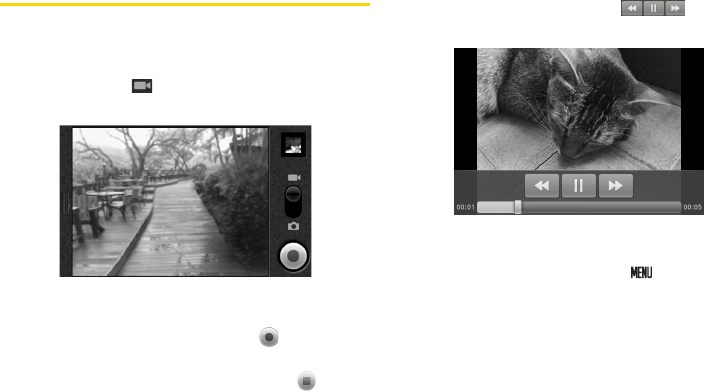
74 2H . Ca mer a
Recording Videos
In addition to taking pictures, you can record, view, and
send videos with your device’s built-in video camera.
1. Activate camera mode, and then move the slider to
the Video icon .
2. Using the device’s display screen as a viewfinder,
aim the camera lens at your subject.
3. Press the camera button or touch to begin
recording.
4. Press the camera button again or touch to stop
recording. (Your device automatically saves the
video within the DCIM folder on the microSD card.)
Previewing Videos
ᮣTouch a video to play. Touch to rewind/
pause/fast forward the video clip.
Camcorder Settings
1. From camcorder mode, touch > Settings.
2. Touch one of the following options:
ⅢVideo quality to select from: WVGA, VGA, CIF,
QVGA, or QCIF.
ⅢVideo duration to select the maximum recording
time per video clip. Choose from:
30 seconds (for MMS), 10 minutes, 30 minutes, or
60 minutes.

2H. Camera 75
Camera
ⅢWhite balance to compensate for color differences
found within different lighting conditions. Choose
from: Auto, Incandescent, Daylight, Fluorescent, or
Cloudy.
ⅢColor effect to add a color effect to the image.
Choose from: None, Mono, Sepia, Negative, or
Aqua.
ⅢLens Shading to adjust the light volume around
the lens. Choose from: Enable or Disable.
ⅢNight mode to boost the camcorder’s sensitivity in
low light levels. Choose from: Enable or Disable.
ⅢFocus mode to select the range the lens focuses.
Choose from: Auto, Macro, or Off.
ⅢAuto exposure to select the exposure metering
range from: Frame average, Center weighted, or
Spot metering.
3. Touch to return to the previous screen.
Video Options
1. From camcorder mode, touch > Gallery >
.
2. Touch one or more images to select or one of the
following options:
ⅢSelect All to select all images in the folder.
ⅢDeselect All to cancel all selection.
3. Touch one of the following options:
ⅢShare to share the video clip via one of the
following options:
●Messaging to insert the video clip into a new
outgoing MMS message (multimedia text
message).
●YouTube to upload the video clip to your
YouTube account. Touch Upload to complete
the process.
●Bluetooth to send the video clip to another
device or computer via Bluetooth.
●Gmail to attach the video clip to a new Gmail
message.
●Send Email to attach the video clip to a new
email message.
ⅢDelete to delete the video clip.
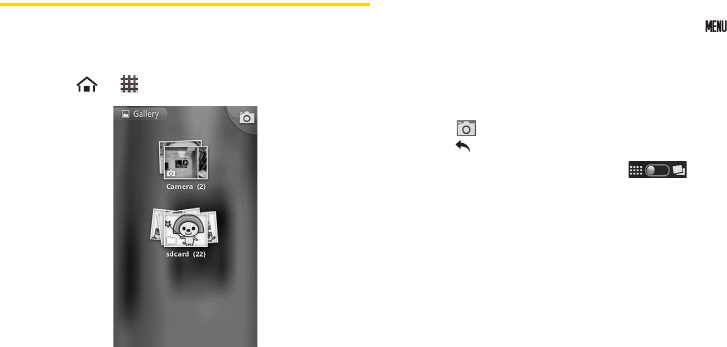
76 2H. Camera
ⅢMore > Details to display video clip details such
as file name, file type, date taken, and folder
name.
Opening Gallery
You can use Gallery to view pictures and play videos
that you’ve taken with your device’s camera,
downloaded, or copied onto your microSD card.
1. Touch > > Gallery.
2. Scroll left or right to view more albums.
3. Touch an album to open it.
4. Touch an image to view a picture or a video.
Gallery Options
The Gallery options are available by touching to
edit, share, and perform other operations to the images
in your Gallery. See “Picture Options” on page 72 and
“Video Options” on page 75 for details.
Additional options may also be available:
ⅷTouch on the top right to activate camera mode.
Touch to return to Gallery.
ⅷTouch an album and then touch on the top
right to change the view between spread and
stacked. The images are sorted according to the
date they were captured in stacked view.
ⅷTouch an image and then touch Slideshow to view
the images in the folder slideshow. (See “Playing a
Slideshow” on page 73.).

2I. Bluetooth 77
Bluetooth
ࡗTurning Bluetooth On and Off (page 77)
ࡗUsing the Bluetooth Settings Menu (page 78)
ࡗPairing Bluetooth Devices (page 78)
About Bluetooth
Bluetooth is a short-range communications technology
that allows you to connect wirelessly to a number of
Bluetooth devices, such as headsets and hands-free
car kits, and Bluetooth-enabled handhelds, computers,
and wireless phones. The Bluetooth communication
range is usually up to approximately 30 feet.
Turning Bluetooth On and Off
By default, your device’s Bluetooth feature is set to Off.
Bluetooth operates in three modes:
ⅷOn: Bluetooth is turned on. Your device can detect
other Bluetooth devices but other devices cannot
detect your device.
ⅷDiscoverable: Bluetooth is turned on. Your device can
detect other Bluetooth devices and other devices
can also detect your device for 120 seconds.
ⅷOff: Bluetooth is turned off. Information cannot be
sent or received when Bluetooth is turned off.
To turn Bluetooth on:
1. Touch > > Settings > Wireless & networks.
2. Touch the Bluetooth field to select the feature. (A
check mark indicates this feature is enabled.)
When active, appears on the status bar.
3. To make your device discoverable, touch
Bluetooth settings, and then select the Discoverable
2I. Bluetooth
Note: Activating Bluetooth can drain your battery faster and
reduce your available usage times. It is recommended
that if you do not need it active, turn it off. It is also
recommended to turn off your Bluetooth within
locations that prohibit its use.
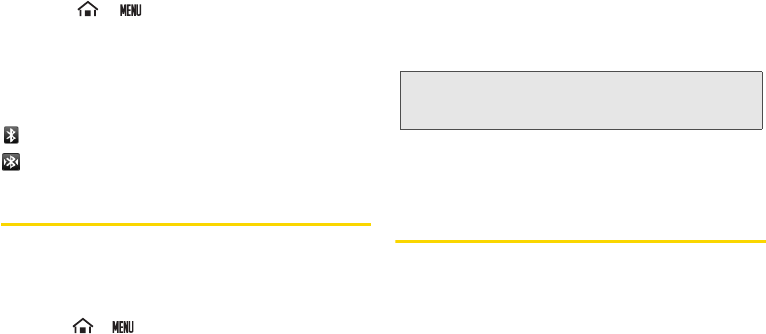
78 2I. Bluetooth
check box to enable other Bluetooth devices to
detect your device for 120 seconds.
To turn Bluetooth off:
1. Touch > > Settings > Wireless & networks.
2. Touch the Bluetooth field to deactivate Bluetooth.
Bluetooth Status Indicators
The following icons show your Bluetooth connection
status at a glance:
– Bluetooth is active
– Bluetooth data connection is active
Using the Bluetooth Settings Menu
The Bluetooth Settings menu allows you to set up your
device’s Bluetooth service.
To access the Bluetooth Settings menu:
1.
Touch > >
Settings
>
Wireless & networks
>
Bluetooth settings
.
ⅢVerify your Bluetooth is active.
2. Set your Bluetooth options: Device name,
Discoverable, and Scan for devices.
ⅢTouch Device name and rename your device for
Bluetooth. Touch OK to save.
ⅢTouch Discoverable to make your device visible,
allowing it to be detected by other devices for
pairing and communication.
ⅢTouch Scan for devices to search for visible
external Bluetooth-compatible devices such as
headsets, devices, printers, and computers.
Pairing Bluetooth Devices
Paired Devices
The Bluetooth pairing process allows you to establish
trusted connections between your device and another
Bluetooth device. When you pair devices, they share a
passkey, allowing for fast, secure connections while
bypassing the discovery and authentication process.
Note: Your device is visible for up to 120 seconds (two
minutes). This value appears as a countdown within
the Discoverable field.
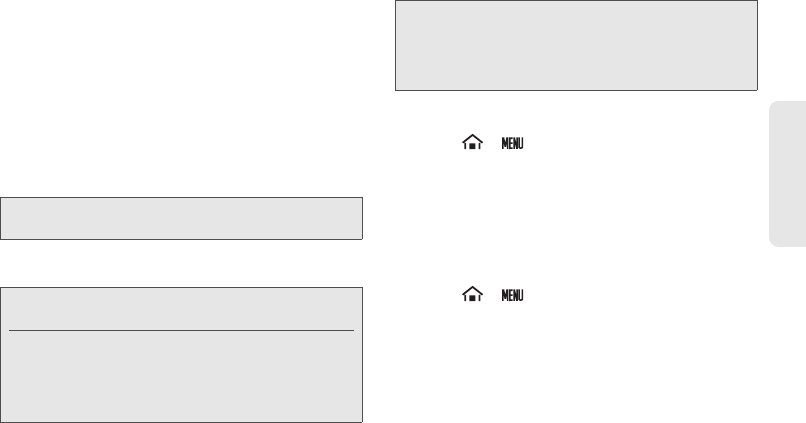
2I. Bluetooth 79
Bluetooth
To pair your device with another Bluetooth device:
1. Verify your Bluetooth is active.
2. From the Bluetooth settings page, touch
Discoverable. Your device must be visible to
successfully pair with an external device.
3. Touch Scan for devices. Your device will display a
list of discovered in-range Bluetooth devices.
4. Touch a device you would like to pair with, enter a
passkey, if necessary, and touch OK.
5. The device will be paired when it enters the same
passkey.
To disconnect Bluetooth devices:
1.
Touch > >
Settings
>
Wireless & networks
>
Bluetooth settings
.
2. Under the Bluetooth devices section, touch and
hold the connected device.
3. On the options menu, touch Disconnect.
To unpair Bluetooth devices:
1.
Touch > >
Settings
>
Wireless & networks
>
Bluetooth settings
.
2. Under the Bluetooth devices section, touch and
hold the paired device.
3. On the options menu, touch Unpair or
Disconnect & unpair (when connected).
Note: Some devices may be paired by touching Pair when
the option is available.
Note: For car kits, enter “0000” or “1234.” If it does not work,
consult the Bluetooth devices documentation.
Due to different specifications and features of other
Bluetooth-compatible devices, display and operations
may be different, and functions such as transfer or
exchange may not be possible with all Bluetooth-
compatible devices.
Note: Pairing between two Bluetooth devices is a one-time
process. Once a pairing has been created, the devices
will continue to recognize their partnership and
exchange information without having to re-enter a
passkey again.
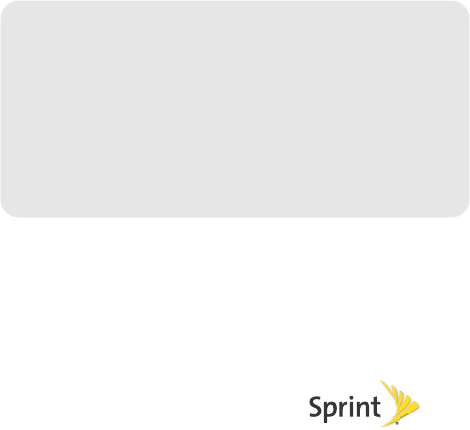
Section 3
Sprint Service

82 3A. Sprint Service: The Basics
ࡗVoicemail (page 82)
ࡗMessaging (page 85)
ࡗCaller ID (page 87)
ࡗCall Waiting (page 88)
ࡗMaking a 3-Way Call (page 88)
ࡗCall Forwarding (page 88)
ࡗRoaming (page 89)
Voicemail
Setting Up Your Voicemail
Your device automatically transfers all unanswered
calls to your voicemail, even if your device is in use or
turned off. You should set up your Sprint Voicemail and
personal greeting as soon as your device is activated.
Always use a password to protect against unauthorized
access.
1. Touch > > Voicemail.
2. In the Personalize your voicemail dialog box, touch
Personalize now.
3. Follow the voice prompts to:
ⅢCreate your password.
ⅢRecord your name announcement.
ⅢRecord your greeting.
Visual Voicemail
Visual voicemail gives you a quick and easy way to
access your voicemail. Now you can find exactly the
message you are looking for without having to listen to
every voicemail message first. This new feature
periodically goes out to your voicemail and gathers the
3A. Sprint Service:
The Basics
Note: Voicemail Password
Sprint strongly recommends that you create a
password when setting up your voicemail to protect
against unauthorized access. Without a password,
anyone who has access to your device is able to
access your voicemail messages.

3A. Sprint Service: The Basics 83
Sprint Service
caller information from all of the current voicemail
messages. It then compiles a list of all the caller names
and numbers along with the length of time and priority
level of each voicemail message.
Voicemail Notification
There are several ways your device alerts you to a new
message:
ⅷBy sounding the assigned ringer type.
ⅷBy the LED blinking green (slow).
ⅷBy displaying at the top of your screen.
New Voicemail Message Alerts
When you receive a new voice message, your device
alerts you and prompts you to check your voicemail.
To check your voicemail:
1. Touch > > Voicemail.
2. Touch the voicemail you want to listen to.
Visual Voicemail Settings
ᮣTouch > > Voicemail > > Settings to
display the following options:
ⅢNotifications: to select how you want to be notified
for new voicemail messages.
ⅢPictures: to select whether to show or hide
pictures associated with Contacts entries.
ⅢSpeakerphone: to select whether to enable
speakerphone.
ⅢChange greeting: to change your voicemail
greeting message.
ⅢFrom name: to specify the name to be attached to
your voice messages.
ⅢCheck for upgrade: to see if an update is available
for the application software.

84 3A. Sprint Service: The Basics
Retrieving Your Voicemail Messages
You can manually retrieve your messages directly from
your wireless device or from any other touch-tone
phone. To dial from your wireless device, either speed
dial your voicemail or use the menu keys.
Using One-Touch Message Access
ᮣTouch and hold on the Phone screen. (Your
device will dial your voicemail box.)
Using Another Phone to Access Messages
1. Dial your wireless phone number.
2. When your voicemail answers, press .
3. Enter your password.
Note: When you are roaming off the Nationwide Sprint
Network, you may not receive notification of new
voicemail messages. Sprint recommends that you
periodically check your voicemail by dialing 1 + area
code + your wireless phone number. When your
voicemail answers, touch and enter your
password. Roaming rates apply when you access
voicemail while roaming off the Nationwide Sprint
Network.
Your device accepts messages even when it is turned
off. However, your device notifies you of new messages
only when it is turned on and you are in a Sprint service
area.
Note: You are charged for airtime minutes when you are
accessing your voicemail from your wireless device.

3A. Sprint Service: The Basics 85
Sprint Service
Voicemail Key Guide
Here’s a quick guide to your keypad functions while
listening to voicemail messages.
Messaging
With messaging, you can send and receive instant
messages between your device and another
messaging-ready device. When you receive a new
message, a new message icon will appear on the
status bar.
There are two types of messaging, Text Messaging
(SMS) and Multimedia Messaging (MMS).
Multimedia messages consist of both text and
multimedia files, such as pictures, videos, or voice
recordings.
Composing Messages
1. Touch > > Messaging > New message.
2. Touch the To field and enter your phone number or
email information using the QWERTY keyboard. As
you enter either a phone number or email address,
if the information matches a current contact’s entry
information, you will see a match. When you see a
match, touch the associated name to complete the
addressing.
3. Touch Next when you have finished entering
recipients.
4. Touch the Type to compose field and enter your
message.
Date/Time Send Reply Advance
Replay Rewind Forward
Erase Return Call Save
Cancel Help Skip

86 3A. Sprint Service: The Basics
5. To access more features, touch for the
following options:
ⅢAdd subject to add a subject to the message.
ⅢAttach to add a file attachment. See “Attaching
Files to a Message” below.
ⅢInsert smiley to add smiley icons to the message.
ⅢDiscard to discard the message.
ⅢAll threads to save the message as draft and close
the compose message screen.
6. Review your message and touch Send.
Attaching Files to a Message
1. On the message composition screen, touch >
Attach.
2. Select a multimedia attachment type:
ⅢPictures: Opens the Gallery application. Select the
picture you wish to send with the outgoing
message.
ⅢCapture picture: Opens the camera application.
Take a picture, and then touch OK to use this
image in your message.
ⅢVideos: Opens the Gallery application. Use the
onscreen navigation to select a video and attach
it to your outgoing message.
ⅢCapture video: Opens the camcorder application.
Shoot a video, and touch OK to use this video in
your message.
ⅢAudio: Opens the Select audio window. Select an
audio file and touch OK.
ⅢRecord audio: Opens the message recording
application. Record an audio clip and touch either
Use this recording, or Discard.
ⅢSlideshow: Opens the Edit slideshow screen.
●Touch Add slide to create a new slide. (This is
a placeholder for new images to be added,
similar to a playlist.)
●Touch the created slide (example, Slide 1),
touch Add picture, and then select the picture
you want to add to the slide.
●Touch the text field below the image to enter a
caption for the picture.
●Touch > Preview (to preview the slide),
Remove picture (to delete the currently
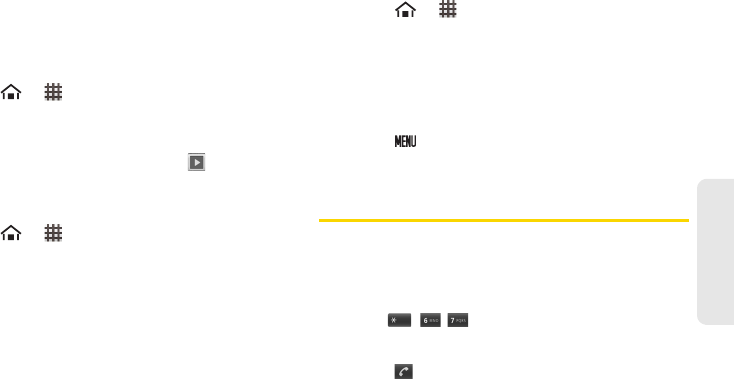
3A. Sprint Service: The Basics 87
Sprint Service
selected picture), Add music, Add slide, or
change the slide Duration or Layout.
●When finished, touch Done to attach the
slideshow to your message.
To view and play a multimedia message:
1. Touch > > Messaging.
2. From the Messaging screen, touch a multimedia
message to open its contents.
3. While the message is open, touch to play the
file.
To reply to a multimedia message:
1. Touch > > Messaging.
2. From the Messaging screen, touch a multimedia
message to open its contents.
3. While the message is open, touch the Type to
compose field and then type your reply message.
4. Once complete, touch Send.
Deleting a Message or Message Thread
1. Touch > > Messaging.
2. Touch and hold a message or a thread you would
like to delete, and touch Delete thread or
Delete message > Delete to delete a single thread
or message.
– or –
3. Touch > Delete threads > Delete to delete all
threads.
Caller ID
Caller ID allows people to identify a caller before
answering the device by displaying the number of the
incoming call. If you do not want your number
displayed when you make a call, follow these steps.
1. Enter on the Phone screen.
2. Enter the number you want to call.
3. Touch .
To permanently block your number, call Sprint
Customer Service.
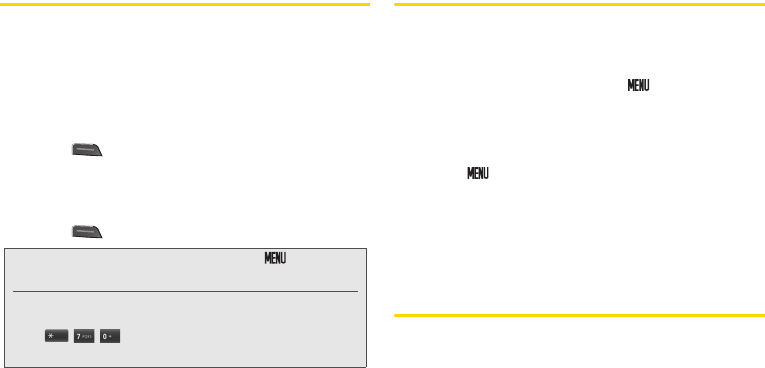
88 3A. Sprint Service: The Basics
Call Waiting
When you’re on a call, Call Waiting alerts you to
incoming calls by beeping. Your device’s screen
informs you that another call is coming in and displays
the caller’s phone number (if it is available and you are
in digital mode).
To respond to an incoming call while you’re on a call:
ᮣPress . (This puts the first caller on hold and
answers the second call.)
To switch back to the first caller:
ᮣPress again.
Making a 3-Way Call
With 3-Way Calling, you can talk to two people at the
same time. When using this feature, the normal airtime
rates will be charged for each of the two calls.
1. Make a phone call and touch > Add call.
2. Make another phone call. (Your first call is
automatically put on hold.)
3. When you are connected to the second party,
touch >
Merge calls.
If one of the people you called hangs up during your
call, you and the remaining caller stay connected. If you
initiated the call and are the first to hang up, all callers
are disconnected.
Call Forwarding
Call Forwarding lets you forward all your incoming calls
to another phone number – even when your device is
turned off. You can continue to make calls from your
device when you have activated Call Forwarding.
Tip: You can also switch callers by touching >
Swap Calls.
For those calls where you don’t want to be interrupted,
you can temporarily disable Call Waiting by entering
before placing your call. Call Waiting is
automatically reactivated once you end the call.
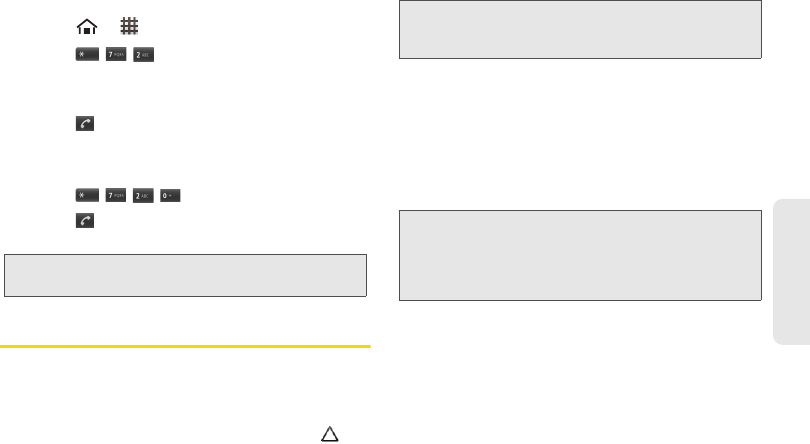
3A. Sprint Service: The Basics 89
Sprint Service
To activate Call Forwarding:
1. Touch > > Phone.
2. Touch .
3. Enter the area code and phone number to which
you want your calls forwarded.
4. Touch . (You will hear a tone to confirm the
activation of Call Forwarding.)
To deactivate Call Forwarding:
1. Touch .
2. Touch . (You will hear a tone to confirm the
deactivation.)
Roaming
Roaming Icon
Your display screen always lets you know when you’re
off the Nationwide Sprint Network. Anytime you are
roaming, the device displays the roaming icon ( ).
Roaming on Other Networks
When you’re roaming on other networks, your call
quality and security will be similar to the quality you
receive when making calls on the Nationwide Sprint
Network. However, you may not be able to access
certain features, such as data services, depending on
the available network.
Checking for Voicemail Messages While
Roaming
When you are roaming off the Nationwide Sprint
Network, you may not receive on-phone notification of
new voicemail messages. Callers can still leave
messages, but you will need to periodically check your
Note: You are charged a higher rate for calls you have
forwarded.
Tip: Remember, when you are using your device off the
Nationwide Sprint Network, always dial numbers using 11
digits (1 + area code + number).
Note: If you’re on a call when you leave the Nationwide Sprint
Network, your call is dropped. If your call is dropped in
an area where you think Sprint service is available, turn
your device off and on again to reconnect to the
network.

90 3A. Sprint Service: The Basics
voicemail for new messages if you are in a roaming
service area for an extended period of time.
1. Dial 1 + area code + your phone number.
2. When you hear your voicemail greeting, touch .
3. Enter your password at the prompt and follow the
voice prompts.
When you return to the Nationwide Sprint Network,
voicemail notification will resume as normal.
Setting Roam Mode
Your device allows you to control your roaming
capabilities. By using the Roaming menu option, you
can determine which signals your device accepts.
Choose from two different settings on your device to
control your roaming experience.
1. From the Home screen, touch > Settings >
Call settings > System select.
2. Select an option:
ⅢSprint only to access only the Nationwide Sprint
network and prevent roaming on other networks.
ⅢAutomatic to seek service on the Nationwide
Sprint Network. When Sprint service is
unavailable, the device searches for an alternate
service.
Call Guard
Your device has two ways of alerting you when you are
roaming off the Nationwide Sprint Network: the
onscreen roaming icon and Call Guard. Call Guard
makes it easy to manage your roaming by requiring an
extra step before you can place or answer a roaming
call. (This additional step is not required when you
make or receive calls while on the Nationwide Sprint
Network.)
To turn Call Guard on or off:
1. From the Home screen, touch > Settings >
Call settings > Call guard.
2. Touch the check box to enable Call Guard.
Note: Call Guard is turned on by default on your device.

3A. Sprint Service: The Basics 91
Sprint Service
To place roaming calls with Call Guard on:
1. From standby mode, touch 1 + area code + the
seven-digit number and touch .
2. Read the message and touch Agree.
To answer incoming roaming calls with Call Guard on:
ᮣRead the message and touch Agree.
Enabling Data Roaming
Depending on service availability and roaming
agreements, your device may be able to access data
services while roaming on certain systems.
1. From the Home screen, touch > Settings >
Wireless & networks > Mobile networks.
2. Touch the Data roaming check box to connect to
data services while roaming.
3. Read the message and touch OK.
Data Roam Guard
You can set your device to alert you when you are
roaming off the Nationwide Sprint Network and try to
use data services such as messaging.
To set your Data Roam Guard notification:
1.
Touch > >
Settings
>
Wireless & networks
>
Mobile networks
>
Data roaming guard
.
2. Touch On or Off.
ⅢOn (default mode) turns your device's data roam
guard feature on. You will see a prompt that will
require you to respond anytime you access data
services while roaming.
ⅢOff turns your device's data roam guard feature
off. Your device will not notify you of your roaming
status when you access data services.
To use data services when Data Roam Guard is active:
ᮣWhen a notification appears informing you that
data roam charges may apply, touch Roam to
connect.
Note: If the Call Guard feature is set to On, you need to take
extra steps to make and receive roaming calls.

92 3B. Web and Data Services
ࡗGetting Started With Data Services (page 92)
ࡗWi-Fi (page 98)
ࡗEmail (page 100)
ࡗGmail (page 101)
ࡗUsing Google Talk (page 104)
ࡗUsing the Android Market (page 107)
ࡗCreating a Google Account (page 110)
ࡗSprint Zone (page 111)
Getting Started With Data Services
With your Sprint service, you are ready to start enjoying
the advantages of data services. This section will help
you learn the basics of using your data services,
including managing your user name, launching a data
connection, and navigating the Web with your device.
Your User Name
When you buy your device and sign up for service,
you’re automatically assigned a user name, which is
typically based on your name and a number, followed
by “@sprintpcs.com.” (For example, the third John
Smith to sign up for Sprint data services might have
jsmith003@sprintpcs.com as his user name.)
When you use data services, your user name is
submitted to identify you to the Nationwide Sprint
Network. Your user name will be automatically
programmed into your device. You don’t have to enter it.
Launching a Web Connection
ᮣTouch > > Browser. (Your data connection
starts and you see the SprintWebTM home page.)
3B. Web and Data Services
Note: You can connect to the Internet via either the Sprint
network or Wi-Fi (configured from the Settings >
Wireless & networks page).
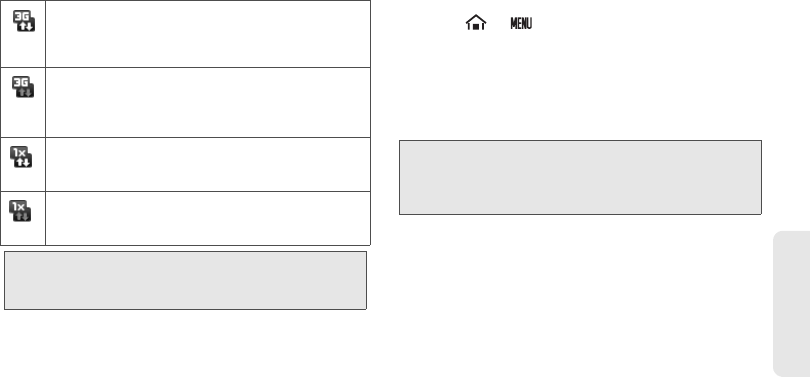
3B. Web and Data Services 93
Web and Data
Data Connection Status and Indicators
Your device displays the current status of your data
connection through indicators at the top of the screen.
If you do not see an indicator, your device does not
have a current data connection. To launch a
connection, see “Launching a Web Connection” on
page 92.
Updating Your User Name
If you choose to change your user name and select a
new one online, you must then update the user name
on your device.
ᮣ
Touch
>
> Settings
>
About phone
>
Update Profile.
Navigating the Web
Navigating through menus and websites during a data
session is easy once you have learned a few basics.
Scrolling
As with other parts of your device’s menu, you’ll have to
drag up and down to see everything on some
websites.
Your device is connected to the high-speed Sprint 3G
Network (EVDO). When animated, your device is
transferring data (for example, when you are opening a
Web page).
Your device is connected to the high-speed Sprint 3G
Network (EVDO) but is currently dormant (for example,
when you are viewing a Web page that is completely
open).
Your device is connected to the Sprint 1xRTT data
network. When animated, your device is transferring data
(for example, when you are opening a Web page).
Your device is connected to the Sprint 1xRTT data
network but is currently dormant (for example, when
you are viewing a Web page that is completely open).
Note: The data connection is cut off when an incoming call is
received. Enable DDTM mode in Call settings to send
incoming calls to voicemail.
Note: Before you can access Sprint’s Powerdeck Web page,
you may be asked to enter your 10-digit wireless phone
number. Entering your phone number is not required
for access to other Web pages.

94 3B. Web and Data Services
To scroll line by line through websites:
ᮣUse the trackball to scroll over each available line
within a Web page or to move the onscreen cursor
around the page.
To scroll through a website’s page:
ᮣIn a single motion, touch and drag across the
page.
Selecting
Once you have learned how to use the trackball to
scroll and drag around a page, you can start navigating
the Web.
To select onscreen items or links:
ᮣEither touch an onscreen link or use your trackball
to select the link and then press the trackball.
Links, which are displayed as underlined text, allow you
to jump to Web pages, select special functions, or even
place phone calls.
Going Back
To go back one page:
ᮣTouch . Repeat this process to keep going back
through your Web page history of recently visited
pages.
Going to a Web Page
1. Touch the Address field and enter a new Web
address.
2. Touch Go to launch the new page.
Browser Menu
The browser menu offers additional options to expand
your use of the Web on your device.
Opening the Browser Menu
The browser menu may be opened anytime you have
an active data session, from any page you are viewing.
ᮣFrom any open Web page, touch . (You will see
the browser menu.)

3B. Web and Data Services 95
Web and Data
Options available within the browser menu include:
ⅷNew window: Launches a new Internet window while
maintaining the current Web page active.
ⅷBookmarks: Allows you to access and manage your
bookmarks.
ⅷWindows: Displays a list of the current active Web
pages.
ⅷRefresh: Reloads the current Web page.
ⅷStop: Stops the loading of the Web page. Available
while the page is loading.
ⅷForward: Returns you to a previously viewed page.
ⅷMore: Provides additional browser options:
ⅢAdd bookmark: Allows you to save favorite Web
pages.
ⅢFind on page: Searches the current Web page for
a word.
ⅢSelect text: Selects text from the current Web
page.
ⅢPage info: Displays the Name and URL (website
address) of the site you’re currently viewing.
ⅢShare page: Allows you to send a URL via Email,
Gmail, or Messaging.
ⅢDownloads: Keeps a list of previously
downloaded content.
ⅢSettings: Lets you configure and manage your
browser settings.
Adjusting Browser Page Settings
1. Touch to open the browser menu.
2. Touch More > Settings.
3. Navigate to the Page content settings area and
select from one of the following page settings:
ⅢText size: Adjusts the current onscreen text size.
Options include: Tiny, Small, Normal, Large, and
Huge.
ⅢDefault zoom: Adjusts the default zoom setting.
Options include: Far, Medium, and Close.
ⅢOpen pages in overview: Displays overview of
newly opened pages.
ⅢText encoding: Selects the text encoding settings.
ⅢBlock pop-up windows: Prevents pop-up
advertisement or windows from appearing
onscreen. Clear the check box to disable this
function.

96 3B. Web and Data Services
ⅢLoad images: Allows Web page images to be
loaded along with the other text components of a
loaded website.
ⅢAuto-fit pages: Allows Web pages to be resized to
fit as much of the screen as possible.
ⅢLandscape-only display: Displays pages only in
the wider, landscape screen orientation.
ⅢEnable JavaScript: Enables JavaScript for the
current Web page. Without this feature, some
pages may not display properly. Clear the check
box to disable this function.
ⅢEnable plug-ins: Enables plug-ins for the current
Web page.
ⅢOpen in background: New pages are launched in
a separate page and displayed behind the
current one.
ⅢSet home page: Sets the default page for the Web
browser. Delete the current address, enter the
new Web address for the home page, and touch
OK to complete the process.
4. Touch to return to the browser.
Adjusting Browser Privacy Settings
1. Touch to open the browser menu.
2. Touch More > Settings.
3. Navigate to the Privacy settings area and select
from one of the following page settings:
ⅢClear cache: Deletes all currently cached data.
Touch OK to complete the process.
ⅢClear history: Clears the browser navigation
history. Touch OK to complete the process.
ⅢAccept cookies: Allows sites that require cookies,
to save and read cookies from your device.
ⅢClear all cookie data: Clears all current browser
cookie files. Touch OK to complete the process.
ⅢRemember form data: Allows the device to store
data from any previously filled out forms. Clear the
check box to disable this function.
ⅢClear form data: Deletes any stored data from
previously filled out forms. Touch OK to complete
the process.
ⅢEnable location: Allows sites to request access to
your location.

3B. Web and Data Services 97
Web and Data
ⅢClear location access: Clears location access for
all websites. Touch OK to complete the process.
4. Touch to return to the browser.
Adjusting Browser Security Settings
1. Touch to open the browser menu.
2. Touch More > Settings.
3. Navigate to the Security settings area and select
from one of the following page settings:
ⅢRemember passwords: Stores user names and
passwords for visited sites. Clear the check box to
disable this function.
ⅢClear passwords: Deletes any previously stored
user names or passwords. Touch OK to complete
the process.
ⅢShow security warnings: Notifies you if there is a
security issue with the current website. Clear the
check box to disable this function.
4. Touch to return to the browser.
Adjusting Browser Advanced Settings
1. Touch to open the browser menu.
2. Touch More > Settings.
3. Navigate to the Advanced settings area and select
from one of the following page settings:
ⅢWebsite settings: Sets advanced settings for
individual websites.
ⅢReset to default: Resets the browser to the default
settings. Touch OK to complete the process.
Creating Bookmarks
1. From any open Web page, touch to open the
browser menu.
2. Touch Bookmarks.
3. Three tabs are revealed:
ⅢBookmarks: Displays a list of your current Web
bookmarks.
ⅢMost visited: Displays a list of your most
frequently visited websites. Touch an entry to
launch the selected page.
ⅢHistory: Displays a record of your browsing
history.
4. Touch Add (in thumbnail view) or Add bookmark...
(in list view).

98 3B. Web and Data Services
5. Enter a descriptive name for the new bookmark
and touch OK to store the new entry to your
Bookmarks list.
Creating Bookmarks From Other Tabs
1. From any open Web page, touch to open the
browser menu.
2. Touch Bookmarks.
3. Touch either Most visited or History tab.
4. Touch and hold an entry from the list to display an
onscreen pop-up menu.
5. Touch Add bookmark, edit the Name field, if
necessary, and then touch OK to add the selected
entry to your current list of bookmarks.
Wi-Fi
About Wi-Fi
Wi-Fi is a term used for certain types of wireless local
area networks (WLAN). These device types use an
802.11 wireless specification to transmit and receive
wireless data.
Wi-Fi communication requires access to an existing
and accessible Wireless Access Point (WAP). These
WAPs can either be open (unsecured) as within most
hot spots, or secured (requiring knowledge of the
router name and password).
Turning Wi-Fi On and Off
By default, your device’s Wi-Fi feature is turned off.
Turning Wi-Fi on makes your device able to discover
and connect to compatible in-range Wi-Fi networks.
To turn Wi-Fi on:
1. Touch > > Settings > Wireless & networks.
2. Touch the Wi-Fi field to activate the feature. (A
check mark indicates this feature is enabled.) The
device will scan for available in-range wireless
networks.
To turn Wi-Fi off:
1. Touch > > Settings > Wireless & networks.
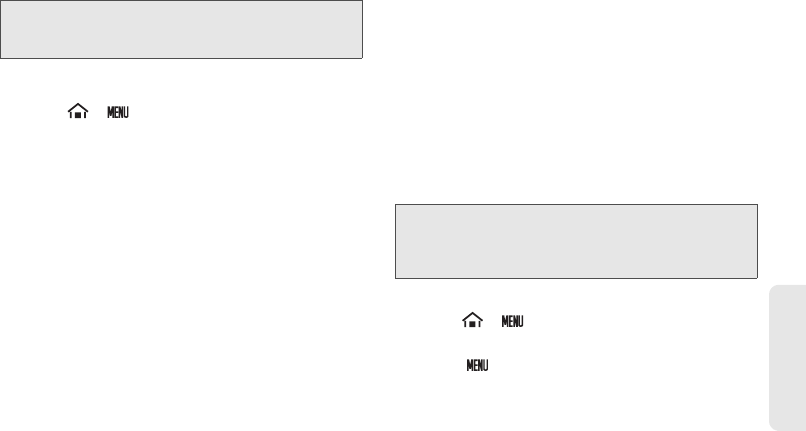
3B. Web and Data Services 99
Web and Data
2. Touch Wi-Fi to deactivate Wi-Fi.
To connect to a Wi-Fi network:
1.
Touch > >
Settings
>
Wireless & networks
>
Wi-Fi settings
.
ⅢThe network names and security settings (open
network or secured with WEP/WAP, etc.) of
detected Wi-Fi networks are displayed in the Wi-Fi
networks section.
2. Touch a Wi-Fi network to connect to.
ⅢIf you select an open network, your device will
automatically be connected.
ⅢIf you select a network that is secured with WPA,
WEP, etc., enter the security key (password), and
then touch Connect.
To manually add your new network connection:
1. Touch Add Wi-Fi network.
2. Enter the Network SSID. This is the name of your
Wireless Access Point.
3. Touch the Security field and select a security
option. This must match the current security setting
on your target.
4. If secured, you will also need to enter the network
password. The show password option reveals the
password as you type it instead of showing only
dots ( ).
5. Touch Save to store the new information and
connect to your target.
To manually scan for a Wi-Fi network:
1.
Touch > >
Settings
>
Wireless & networks
>
Wi-Fi settings.
2. Touch > Scan.
Note: The use of wireless data connections such as Wi-Fi
and Bluetooth can cause an added drain to your
battery and reduce your use times.
Note: The next time your device connects to a previously
accessed or secured wireless network, you are not
prompted to enter the network key again, unless you
reset your device back to its factory default settings.
....

100 3B. Web and Data Services
Wi-Fi Status Indicators
The following icons show your Wi-Fi connection status
at a glance:
– Wi-Fi is connected and active.
– An open Wi-Fi network is available.
Using the Wi-Fi Settings Menu
The Wi-Fi settings - Advanced menu allows you to set
up many of your device’s Wi-Fi service, including:
ⅷSetting your Wi-Fi sleep policy
ⅷViewing your device’s MAC Address
ⅷConfiguring use of either a DHCP or Static IP
To access the Wi-Fi Settings menu:
1.
Touch > >
Settings
>
Wireless & networks
>
Wi-Fi settings.
2. Touch > Advanced.
Email
Your device’s Email applications let you access and
manage multiple email accounts simultaneously in one
convenient location.
Creating an Email Account
1. Touch > > Email.
2. Touch the Email address field and type your email
address.
3. Touch the Password field and type your password.
4. Touch Next to continue. The device automatically
retrieves the email settings.
5. Enter your name and touch Done.
Adding Another Email Account
1. On the Accounts list screen, touch >
Add account.
2. Follow steps 2-7 in “Creating an Email Account.”

3B. Web and Data Services 101
Web and Data
Gmail
Gmail is Google’s Web-based email service. Gmail
comes preconfigured on your device. You can
synchronize your Gmail account on your device with
your Gmail account on the Web.
Setting Up a Gmail Account via the Device
1. Touch > > Gmail.
2. Follow the instructions on the screen to set up
Gmail.
To refresh your Gmail messages:
ᮣTouch > Refresh to send or receive new email
and synchronize your email with your Gmail Web
account.
Creating and Sending Gmail
1. Touch > > Gmail.
2. Touch > Compose.
3. On the To field, enter the recipient’s email address.
To send to multiple recipients, separate the email
addresses with a comma and add as many
recipients as you want.
ⅢTo add a carbon copy (Cc) or blind carbon copy
(Bcc), touch > Add Cc/Bcc.
4. Touch the Subject field and enter the email subject.
5. Touch the Compose Mail field and compose your
email.
ⅢTo add a picture attachment, touch > Attach.
ⅢSelect the picture you want to attach.
ⅢTouch X to delete a selected attachment from
your current email.
6. Once complete, touch Send.
Accessing Gmail Messages
When new email messages are received, a new email
message icon appears on the status bar if the Email
notifications option is enabled.
Email messages you send to and receive from the
same recipient are grouped as message threads or
conversation.

102 3B. Web and Data Services
Opening and Reading Received Email
To view email, do one of the following:
ⅷDrag the status bar down to open the Notifications
panel. Touch an email message to open and read it.
ⅷFrom the Inbox, touch the email message to open
and read it.
Replying to the Sender
1. From the Inbox, touch to open and view the email
message.
2. Scroll down to the end of the message thread, and
then touch Reply.
3. Type your reply message.
4. Scroll down to the end of the message, and then
touch Send.
Replying to All Recipients
1. From the Inbox, touch to open and view the email
message.
2. Scroll down to the end of the message thread, and
then touch Reply to all.
3. Type your reply message.
4. Scroll down to the end of the message, and then
touch Send.
Deleting Email
1. From the Inbox, touch to open and view the email
message.
2. With the email message displayed, touch Delete.
Configuring Gmail Settings
1. From the Inbox, touch > Settings.
2. Choose from the following options:
ⅢSignature: Select to enter a signature that is
added at the end of the email messages.
ⅢConfirm delete: Select to show a confirmation box
when you delete a message thread.
ⅢBatch operations: Select to show the batch
operations features, such as: archive, delete, or
apply a label to multiple emails at once.
Note: Unread messages are in bold.

3B. Web and Data Services 103
Web and Data
ⅢClear search history: Select to delete all the search
history.
ⅢLabels: Select to set which Gmail labels to
synchronize.
ⅢEmail notifications: Select to show a new
message icon on the status bar when you receive
new email.
ⅢSelect ringtone: Select if you want the device to
ring when a new email is received. On the
ringtone menu, touch a ringtone to play the tone
briefly, and then touch OK to confirm your
selection. Select Silent if you do not want the
device to ring when a new email is received.
ⅢVibrate: Select if you want the device to vibrate
when a new email is received.
3. Touch to save your changes.
Corporate Email (Outlook)
The Exchange Email (corporate email) application ( )
also provides access to your Outlook Exchange server
via your device. If your company uses Microsoft
Exchange Server 2003 and 2007 as the corporate
email system, you can use this email application to
wirelessly synchronize your email, Contacts, and Task
information directly with your company’s Exchange
server.
Setting Up a Corporate Email Account
1. Touch > > Exchange Email.
2. Touch Configure your Account.
3. Enter your Email address and Password
information, and then touch Next. Consult your
network administrator for further details.
Ⅲ Email address: your Outlook corporate email
address.
ⅢPassword: typically your network access
password (case-sensitive).
4. Enter User ID, Domain, Password, and Server and
touc
h
Next.
ⅢUser ID: enter your network login ID.
Important: This Outlook application does not utilize
Microsoft® ActiveSync to synchronize the device
to your remote Exchange Server. This
synchronization is done wirelessly over the air
(OTA) and not via a direct connection.
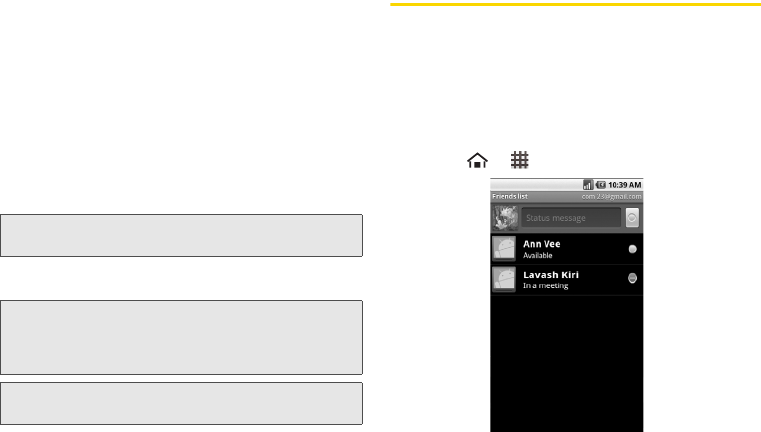
104 3B. Web and Data Ser vices
ⅢDomain: enter your network domain.
ⅢPassword: typically your network access
password (case-sensitive).
ⅢServer: your exchange server remote email
address. Typically is in the form mail.XXX.com.
Obtain this information from your company
network administrator.
5. Touch Yes, No, or Don’t Know to select the SSL
encryption status, and touch Next.
6.
Touch to enable protocols for
ActiveSync (Preferred)
,
Exchange 2003, or Exchange 2007, and touch
Next.
7. Read the onscreen activation disclaimer and touch
Next to start configuration.
Using Google Talk
Google Talk is the instant messaging program provided
by Google. Google Talk lets you chat with other people
that also have a Google account. Your Google Talk
account is based on the Google account set on your
device.
Signing In and Chatting
ᮣTouch > > Talk to open Google Talk.
Note: Signal interruptions or incorrect user name or
password information can cause completion issues.
Important: You can synchronize over the air (not directly) with
an Exchange Server running Microsoft Exchange
Server 2003 Service Pack 2 (SP2) or Microsoft
Exchange Server 2007.
Note: You can have multiple corporate email (Microsoft
Exchange ActiveSync) accounts active on your device.

3B. Web and Data Services 105
Web and Data
Adding New Friends
You can add only people who have a Google account.
1. On the Friends list screen, touch > Add friend.
2. Enter the Google Talk ID or the Gmail address of
the person you want to add.
3. Touch Send invitation.
Viewing Your Invitations
On the Friends list screen, touch > Invites. The
pending invitations screen lists all chat invitations that
you have sent.
Accepting and Cancelling Invitations
On the Friends list screen, touch Chat invitation. When
an invitation pop-up window appears, touch Accept or
Cancel.
Changing Your Online Status Message
1. On the Friends list screen, touch the online status
icon that appears beside your email address.
2. Touch the status that you want from the menu.
3. Touch the text box on the left of your online status
icon, and then type your desired status message.
4. Touch Done on the onscreen keyboard.
Starting a Chat
1. Touch a friend on the Friends list.
2. Touch the text box, and then type your message.
3. Touch Send.
Switching Between Active Chats
You can conduct multiple chats at the same time and
switch between active chats.
1. On a chat screen, touch > Switch chats.
2. On the panel, touch the friend you want to chat
with.
Closing a Chat
ᮣOn the Friends list screen, touch and hold the
name of a friend. On the options menu, touch End
chat.
– or –
Note: When a person accepts your invitation, that invitation
disappears from the list.

106 3B. Web and Data Services
On a chat screen, touch > End chat.
Managing Your Friends
Friends on the friends list screen are sorted according
to their online status and are listed alphabetically.
Viewing the Friends List
By default, only the friends that you frequently chat with
are displayed on the friends list screen.
ᮣTo list all your friends, touch > All friends.
ᮣTo display only the friends that you frequently chat
with, touch > Most popular.
Blocking Friends
You can block friends from sending you messages.
1. On the Friends list screen, touch and hold the
name of the friend you want to block.
2. Touch Block friend. That friend is removed from
your friends list and is added to the blocked
friends list.
Unblocking Friends
1. On the Friends list screen, touch > Blocked.
2. On the Blocked Friends list, touch the name of the
friend you want to unblock.
3. Touch OK to confirm.
Mobile Indicators
Checking Friends’ Devices
You can see which devices your friends are using to
chat in Google Talk.
ⅷIf an Android icon appears to the right of your friend’s
name, it indicates that your friend is using an Android
phone.
ⅷIf no icon is displayed, it indicates that your friend is
using a computer.
Displaying a Mobile Indicator
You can choose to show a mobile indicator along with
your name to let your friends know the type of wireless
device you are using.

3B. Web and Data Services 107
Web and Data
1. On the Friends list screen, touch > More >
Settings.
2. Touch Mobile indicator.
3. Touch .
Signing Out
ᮣOn the Friends list screen, touch > More >
Sign out to sign out from Google Talk.
Google Talk Settings
1. On the Friends list screen, touch > More >
Settings.
2. Touch one of the following to change the settings:
ⅢAutomatically sign in: Select to automatically sign
in to Google Talk every time you turn on your
device.
ⅢMobile Indicator: Select to allow your friends to
see the type of wireless device you are using. See
“Mobile Indicators” on page 106.
ⅢAutomatic away-status: Select to show your status
as away when the screen is turned off.
ⅢClear search history: Select to delete the Google
Talk search history.
ⅢIM notifications: Select to show a new IM
message icon on the status bar when a new
instant message is received.
ⅢSelect ringtone: Select if you want the device to
ring when a new instant message is received. On
the ringtone menu, touch a ringtone to play the
tone briefly, and then touch OK to confirm
selection. Select Silent if you do not want the
device to ring when a new instant message is
received.
ⅢVibrate: Select if you want the device to vibrate
when a new instant message is received.
Using the Android Market
The Android MarketTM provides direct access to a large
selection of applications which you can download and
install on your device.
Accessing the Market
1. Touch > > Market.

108 3B. Web and Data Services
2. If you don’t already have a Google account, you
will need to set one up. See “Creating a Google
Account” on page 110.
3. Touch Accept to agree to the Android Market terms
of service when you access the service for the first
time.
4. Explore the Android Market.
Getting Help About Android Market
ᮣOn the Android Market screen, touch > Help to
go to the Android Market website.
Finding Applications
You can select an application through one of the
following means:
ⅢBrowse through featured apps. Scroll through the
list of featured apps when you open Android
Market.
ⅢBrowse apps by categories. First, touch Apps or
Games, and then touch a category. Under a
category, you can filter the apps by Top paid, Top
free, or Just in.
ⅢSearch for an app. Press the Search key ( )
while on the Android Market home screen, enter
the name or type of app you’re looking for, and
then touch to the right of the search box.

3B. Web and Data Services 109
Web and Data
Installing Applications
1. Select the item that you want to download.
2. On the item details screen, view ratings of the
application, comments by users and developer
information.
3. Touch Install (for free applications) or Buy (for paid
applications). A list of items the application will
access is displayed.
4. Touch OK to start installation, or Cancel to stop
installation.
5. When installation is complete, will appear on
the status bar.
6. On the Android Market screen, touch >
Downloads.
7. Touch the application, and touch Open.
Uninstalling Applications
1. On the Android Market screen, touch Downloads to
view downloaded applications.
2. Touch the application that you want to remove.
3. Touch Uninstall.
4. Touch OK to confirm.
5. Select the reason for removing the application, and
then touch OK.
Reinstalling a Google Application
If the Android operating system is ever updated, any
applications you’ve installed on the device will be
erased. However, you can easily reinstall any Android
Market applications (free or paid).
1. Log into your Google account via the device.
2. Touch > > Market > Downloads.
Note: To check the status of download, open the Notifications
panel. To stop the download, touch the item and then
touch Cancel download.
Note: Pictures and music are stored on the microSD card.
Contacts and calendars are stored remotely on with
your remote Google or Outlook servers.

110 3 B . W e b an d D at a S er v ic e s
3. Scroll through the list of previously downloaded
Google applications and choose the one you wish
to reinstall.
4. Follow the onscreen instructions.
Data Services FAQs
How do I sign in for the first time?
You are automatically signed in to access data services
when you turn on your device.
How do I know when my device is connected to data
services?
Your device automatically connects when you use data
service or an incoming message arrives. You will also
see or .
Can I make calls and use data services at the same
time?
No, you cannot use voice and data services
simultaneously.
Creating a Google Account
You will need a Google account to access several
device features such as Gmail, Google Maps, Google
Calendar, and Google Talk. Before you are able to
access Google applications, you must enter your
account information. These applications sync between
your device and your online Google account.
1. You will be prompted to create and log into a
Google account when you switch on the device for
the first time, or when you launch an application
which requires a Google account.
2. Follow the onscreen instructions to set up an
account and log into it to proceed.
Note: If you have installed an application from outside the
Android Market, you will not be able to reinstall it using
the above steps. If you have saved the installation file
(.apk) to your computer, you can copy it back to your
device and reinstall using Manage Applications.

3B. Web and Data Services 111
Web and Data
Sprint Zone
Sprint Zone is a free application which helps you
manage your account, get tips and tricks for your
device, find recommended apps, and more.
1. Touch > > Sprint Zone.
2. From the Sprint Zone Web page, scroll up or down
and touch an item to check your account, read the
latest news about your device, load an application,
and more.
Currently, various applications, such as NASCAR,
Sprint Football Live, Sprint Navigation, and Sprint TV
are available through Sprint Zone. Access Sprint Zone
for the latest information.
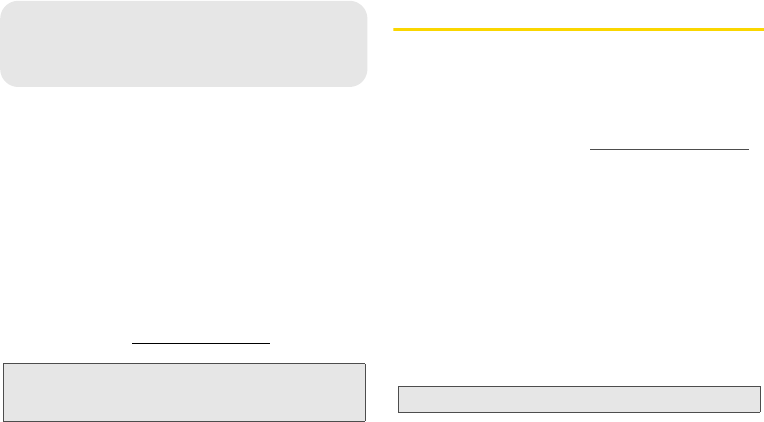
112 3C. Entertainment: TV and Music
ࡗTV (page 112)
ࡗMusic (page 114)
ࡗStreaming Music (page 117)
ࡗYouTube (page 117)
Sprint TV gives you the ability to listen to audio clips
and to view video clips right from your device’s display.
Watch live TV and catch up on episodes of your
favorite shows – anywhere on the Nationwide Sprint
Network.*
* Sprint TV coverage not available everywhere. Content and
lineup subject to change. Select channels also available for
casual usage. Visit www.sprint.com/tvguide for more
information.
TV
Your Sprint TV Channel Options
The Sprint TV application offers a wide variety of
accessible channels. Subscription options include
comprehensive basic packages as well as a full menu
of “a la carte” channels. Visit www.sprint.com/tvguide
for more information on channels and pricing.
Some of the available categories may include:
Note: If Sprint TV isn’t already installed on your device, you
can download it from Sprint Zone. See “Sprint Zone” on
page 111.
3C. Entertainment:
TV and Music
ⅷSprint Radio ⅷSprint Power View
ⅷPrimetime TV ⅷMusic Videos
ⅷSprint TV Live ⅷMusic & Radio
ⅷSports ⅷEntertainment
ⅷCartoons ⅷNews & Weather
ⅷMovies & Shorts ⅷMobile Previews
Note: Available categories and content are subject to change.
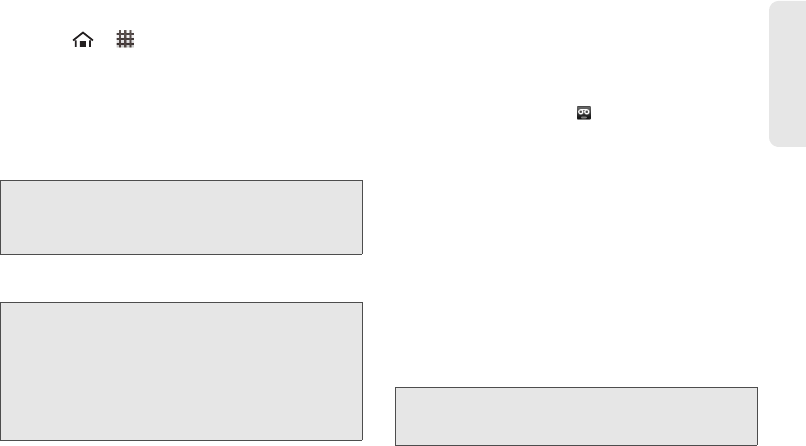
3C. Entertainment: TV and Music 113
TV and Music
Watching TV
1. Touch > > Sprint TV. Depending on your
settings, your device may prompt you to accept a
data connection.
2. Select TV, Radio, Favs, or More to display channel
options.
3. Touch a channel from the Sprint TV listings or
touch an available category.
4. If applicable, touch a clip to view the program. The
clip will automatically load and begin playing.
TV FAQs
1. Will I know if I’m receiving an incoming call while
I’m viewing or listening to a media clip?
No. All incoming calls will roll into voicemail while
you are playing a clip. If the caller leaves a
voicemail, you will see on the screen.
2. How long are the clips? Will I know the estimated
time it will take to play the clip prior to accessing
it?
Once you have selected a channel, you will see a
listing of the available clips, with each clip’s length
displayed after the clip’s title. In general, a clip’s
duration will depend on the story or content being
provided, and can be fairly short or as long as a
few minutes.
3. Can I access a clip wherever I am, as long as I have
my device?
As long as you are on the Nationwide Sprint
Network, you will have access to the audio and
video clips.
Note: The first time you access a channel, the system will
prompt you to purchase access (unless the channel
doesn't have a monthly fee). Select Subscribe to
purchase access.
Tip: While you are playing a clip, you can scroll through the
channels to view more selections. You will see a small
pop-up screen that tells you which channel you are
watching as well as other channels that you have access
to. Once you find a channel that you want to watch or
listen to, scroll to it and touch (or simply wait
approximately three seconds), and the channel will begin
loading.
Note: Sprint TV service does not work while roaming off of
the Nationwide Sprint Network or where service is
unavailable.

114 3C. Entertainment: TV and Music
4. Are the videos that I’m viewing “live” videos?
It depends on the content provider. Some of the
channels available through Sprint TV stream live
content. Others provide media on demand with
video and audio clips that are refreshed throughout
the day, but that are not “live.”
5. After purchasing access to an Available Channel
for a monthly fee, do I receive any confirmation?
That is, how do I know it has been purchased?
The next time you access the channel, you bypass
the Preview/Purchase page and go directly to the
available content.
6. If I don’t subscribe to a data plan, will I still be able
to view the multimedia clips?
Yes. For service access charges, please consult
your Sprint service plan or visit www.sprint.com.
7. What does it mean when the video pauses and I
see the word “loading” at the bottom of the
screen?
This happens when the device is loading the data
necessary to play the clip. It typically occurs when
there is heavy traffic on the network.
8. How can I cancel service if I decide I don’t want it?
To cancel your Sprint TV service, visit
www.sprint.com and sign on to My Sprint with
your account number and password. From this
page, you have the ability to cancel the service or
any channels to which you subscribe.
9. Can I surf to a different channel while I am playing
a clip?
Yes. While you are playing a clip, you can surf to a
different channel. You will see a small pop-up
screen that tells you which channel you are
watching as well as other channels that you have
access to. Once you find a channel that you want
to watch, scroll to it and touch (or simply wait
approximately three seconds), and the channel will
begin loading.
Music
Music plays digital audio files saved on the storage
card.
To play audio files which are not saved in the storage
card, copy the files to the storage card first. See
“Connecting Your Device to Your Computer” on page
68 for more details on copying files.

3C. Entertainment: TV and Music 115
TV and Music
Opening the Music Library
Touch > > Music. The Music library screen
appears.
Playing Music
1. On the Music library screen, touch a category to
view the contents under that category. Options are:
Artists, Albums, Songs, and Playlists.
2. Drag your finger through folders until you reach the
music you want to play.
3. Touch the music file to play. The playback screen
opens.
4. The following options are available for the control:
ⅢTouch the playback controls to rewind, pause/
play, and forward playback.
ⅢTouch the rewind button twice to play the previous
music.
ⅢTouch the Playlist button to view the current
playlist.
ⅢTouch the Shuffle button to toggle shuffle on or
off.
ⅢTouch the Repeat button to cycle through the
repeat modes: Repeating all songs,
Repeating current song, or Repeat is off.
Using Playlists
Create a playlist to organize your music.
Creating Playlists
1. Open the Music library and browse for the music
that you want to add to the playlist.
2. Touch and hold a selection to open the options
menu.
3. Touch Add to playlist.
Playlist button
Shuffle button
Repeat button
Playback controls
Slider
Elapsed
time
Tot a l t i m e
116 3C. Entertainment: TV and Music
4. On the Add to playlist window, touch New.
5. Type the name of your new playlist.
6. Touch Save.
Adding Music to Existing Playlists
1. Open the Music library and browse for the music
that you want to add to the playlist.
2. Touch and hold a selection to open the options
menu.
3. Touch Add to playlist.
4. On the Add to playlist window, touch the name of
the playlist that you want to add the music to.
Removing Music From Playlists
1. Open the Music library and touch Playlists.
2. Touch the playlist that contains the music you want
to remove.
3. Touch and hold a selection and touch
Remove from playlist.
Renaming Playlists
1. Open the Music library and browse for the playlist
that you want to rename.
2. Touch and hold the playlist.
3. On the options menu, touch Rename.
4. Type the new name of the playlist.
5. Touch Save.
Playing Music in Playlists
1. Open the Music library and browse for the playlist
that you want to play.
2. Touch and hold the playlist.
3. On the options menu, touch Play.
Deleting Playlists
1. Open the Music library and browse for the playlist
that you want to delete.
2. Touch and hold the playlist.
3. On the options menu, touch Delete.

3C. Entertainment: TV and Music 117
TV and Music
Setting Music As a Ringtone
1. Open the Music library and browse for the music
that you want to set as ringtone.
2. Touch and hold a selection, and then touch
Use as phone ringtone.
Deleting Music
You can delete music files from the microSD card.
1. Open the Music library and browse for the music
that you want to delete.
2. Touch and hold a selection, and then touch Delete.
3. Touch OK to confirm.
Streaming Music
Sprint offers a variety of musical options through the
Music category in the Sprint TV menu, including
SIRIUS Music, Music Choice, VH1, and many others.
Choose from rock, pop, hip-hop, and R&B, and access
exclusive video clips, music industry news,
performances, and interviews with your favorite artists.
1. Touch > > Sprint TV > Radio > [selection].
2. Select Subscribe to purchase a monthly
subscription to your selected channel.
Once you have purchased access to a music or radio
channel, you can select from a variety of stations to
listen to your favorite music or get caught up on what’s
new in music.
YouTube
YouTube™ is a video sharing website on which users
can upload and share videos. The site is used to
display a wide variety of user-generated video content,
including movie clips, TV clips, and music videos, as
well as video content such as video blogging,
informational shorts and other original videos.
Opening YouTube
ᮣTouch > > YouTube. The library screen
appears.
Watching YouTube Videos
1. On the YouTube screen, touch a video.

118 3C. Entertainment: TV and Music
2. Touch the screen to show/hide the playback
controls. Use the playback controls to rewind,
pause/play, or forward the video.
3. Touch to go back to the previous screen.
Searching for Videos
1. On the YouTube screen, touch at the upper
right of the screen to open the search box.
2. Enter the keyword to search, and then touch
again.
3. Search results appear below the status bar.
Scroll through the results and touch a video to
watch it.
Sharing Videos
1. On the video list, touch and hold the video.
– or –
While watching the video, touch > Share.
2. Select the email account that you want to use to
send the video link.
3. The video link is automatically added to your email
message.
4. Enter the recipient, complete your email message,
and then touch Send.
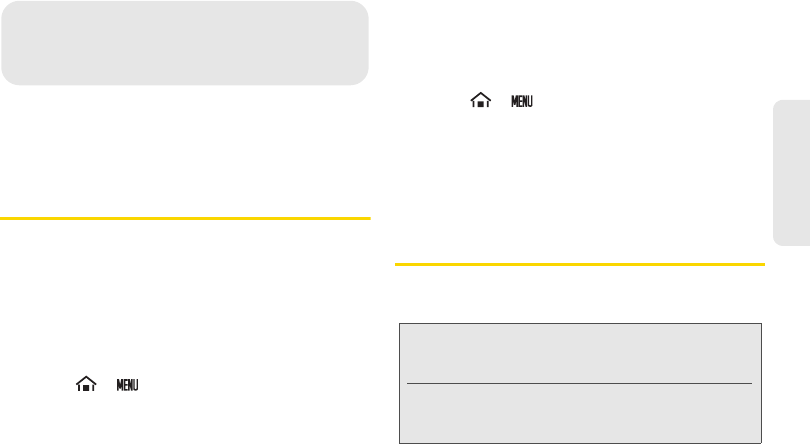
3D. GPS Navigation 119
GPS Navigation
ࡗGPS Services (page 119)
ࡗSprint Navigation (page 119)
ࡗGoogle Maps (page 120)
GPS Services
Your device’s built-in GPS capability gives you access
to a number of location-based services, including
Maps and Sprint Navigation.
Activating Location Mode
Before using any of the location-based services, you
must turn on your device’s location mode.
ᮣTouch > > Settings > Location & security >
Use GPS satellites.
Using Wireless Networks
This additional location feature uses open Wi-Fi and
mobile network connections to assist in providing
additional location accuracy.
1. Touch > > Settings > Location & security >
Use wireless networks.
ⅢSince this feature is based on Google’s location
service, you will need to agree to allow Google to
collect anonymous information.
2. Touch Agree to accept the terms of service.
Sprint Navigation
Sprint Navigation gives you turn-by-turn directions
onscreen and over speakerphone.
3D. GPS Navigation
Note: Depending on your service plan, Sprint Navigation
may require a monthly subscription. Contact Sprint
for information and pricing.
If Sprint Navigation isn’t already installed on your
device, you can download it from Sprint Zone. See
“Sprint Zone” on page 111.
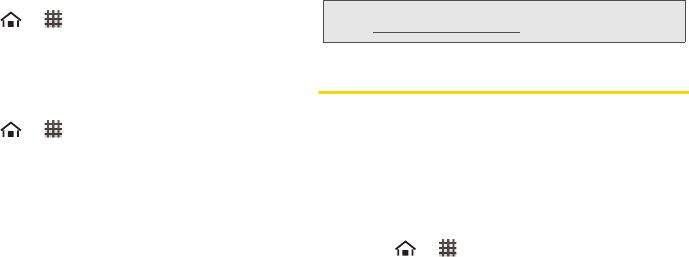
120 3D. GPS Navigation
Registering Sprint Navigation
Before you can use Sprint Navigation, your device and
service must be registered.
1. Touch > > Sprint Navigation.
2. Follow the onscreen instructions to enter and
submit the required information.
Using Sprint Navigation
1. Touch > > Sprint Navigation.
2. Select an option and follow the onscreen
instructions to get directions or view maps.
ⅢDrive To lets you enter an address (by speaking it
or by using the keypad) or select from categories
such as My Favorites, Recent Places, or
Businesses to search for turn-by-turn directions.
ⅢSearch provides a categorized list of locations
such as Gas Stations, Grocery Stores, and
Hospitals to help find local businesses and
services.
ⅢMaps & Traffic lets you view maps and get traffic
information for your current location or for any
other location (same categories as Drive To).
ⅢShare & More provides access to additional
features such as My Stuff, Movies, Product Tour,
Preferences, and more.
Google Maps
Use this application to find directions, location
information, business addresses, etc., all right from your
device. Determine your current location with or without
GPS, get driving and transit directions, get phone
numbers and addresses for local businesses.
Opening Google Maps
ᮣTouch > > Maps.
Note: For more information about Sprint Navigation, visit
www.sprint.com/navigation.

3D. GPS Navigation 121
GPS Navigation
Zooming In or Out on a Map
ᮣTouch the - button to
zoom out on the map or
touch the + button to
zoom in on the map.
Navigating the Map
To navigate on the map,
slide your finger on the
screen towards the direction
of the area you want to view.
Adding Map Layers
Layers allow you to view
locations and additional info
overlaid on the map.
On the Google Maps menu, touch > Layers, and
then touch one or more of the following options:
ⅷTraffic: Add this layer to view real-time traffic
conditions with roads marked in color-coded lines
that indicate the traffic condition. This mode is
available in selected areas only.
ⅷSatellite: Add this layer to use the same satellite data
as Google Earth. The images are not real-time and
are approximately one to three years old.
ⅷBuzz: Add this layer to read the comments posted
from the location shown on the Google Maps.
ⅷLatitude: Add this layer to see your friends’ locations
and share yours with them. You may sign in with your
Google Account to use this feature.
ⅷTouch More layers to add other layers including
My Maps, Wikipedia, Transit Lines, and Favorite Places.
Finding Your Current Location
On the Google Maps screen, touch >
My Location
. A
blinking blue dot indicates your current location on the
map. This feature is available when
Use GPS satellites
or
Use wireless networks
is enabled. See “GPS Services”
on page 119.
Searching Places
1. On the Google Maps screen, touch > Search.
2. On the search box, type the place that you want to
search. You can enter an address, a city, or type of
establishment.

122 3D. GPS Navigation
3. Touch . A callout appears on the map to
indicate the location.
4. Touch the callout to open the location details.
Getting Directions
1. On the Google Maps screen, touch >
Directions.
2. Do one of the following:
ⅢIn the first text box, type your starting point place,
and then type the destination in the second text
box.
ⅢTouch the location source buttons to open the
location source menu and select a starting point
and destination.
3. Touch Go. The directions to your destination
appears in a list.
Viewing Directions on Map
On the Directions list screen, touch Show on map to
view the directions on a map.
Clearing the Map
When you have reached your destination, touch >
More > Clear map to reset the map.
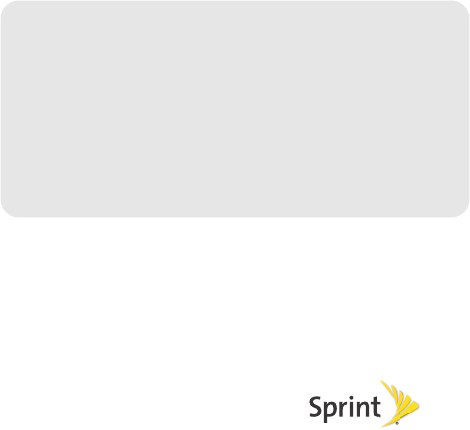
Section 4
Safety and Warranty
Information

124 4A. Important Safety Information
ࡗGeneral Precautions (page 124)
ࡗMaintaining Safe Use of and Access to Your Device
(page 125)
ࡗUsing Your Device With a Hearing Aid Device (page 126)
ࡗCaring for the Battery (page 128)
ࡗRadio Frequency (RF) Energy (page 128)
ࡗOwner’s Record (page 131)
ࡗUser Guide Proprietary Notice (page 131)
This device guide contains important operational and
safety information that will help you safely use your
device. Failure to read and follow the information
provided in this device guide may result in serious
bodily injury, death, or property damage.
General Precautions
There are several simple guidelines to operating your device
properly and maintaining safe, satisfactory service.
ⅷTo maximize performance, do not touch the bottom portion
of your device where the internal antenna is located while
using the phone.
ⅷSpeak directly into the mouthpiece.
ⅷAvoid exposing your device and accessories to rain or liquid
spills. If your device does get wet, immediately turn the
power off and remove the battery.
ⅷDo not expose your device to direct sunlight for extended
periods of time (such as on the dashboard of a car).
ⅷAlthough your device is quite sturdy, it is a complex piece of
equipment and can be broken. Avoid dropping, hitting,
bending, or sitting on it.
ⅷAny changes or modifications to your device not expressly
approved in this document could void your warranty for this
equipment and void your authority to operate this
equipment.
4A. Important Safety
Information
Note: For the best care of your device, only Sprint-authorized
personnel should service your device and accessories. Failure
to do so may be dangerous and void your warranty.
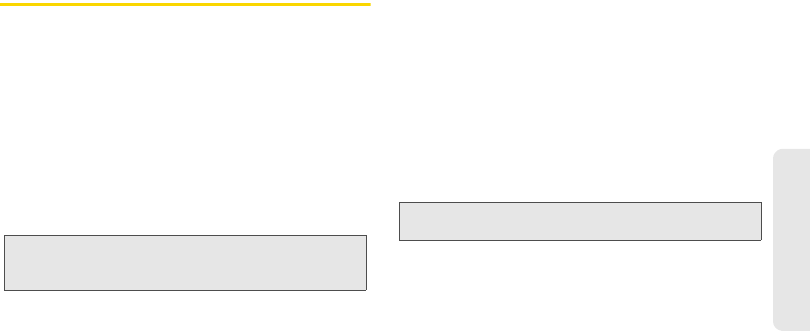
4A. Important Safety Information 125
Important Safety Information
Maintaining Safe Use of and Access
to Your Device
Do Not Rely on Your Device for Emergency Calls
Mobile phones operate using radio signals, which cannot
guarantee connection in all conditions. Therefore you should
never rely solely upon any mobile phone for essential
communication (e.g., medical emergencies). Emergency calls
may not be possible on all cellular networks or when certain
network services or mobile phone features are in use. Check
with your local service provider for details.
Using Your Device While Driving
Talking on your device while driving (or operating the device
without a hands-free device) is prohibited in some jurisdictions.
Laws vary as to specific restrictions. Remember that safety
always comes first.
Following Safety Guidelines
To operate your device safely and efficiently, always follow any
special regulations in a given area. Turn your device off in
areas where use is forbidden or when it may cause
interference or danger.
Using Your Device Near Other Electronic Devices
Most modern electronic equipment is shielded from radio
frequency (RF) signals. However, RF signals from wireless
phones may affect inadequately shielded electronic
equipment.
RF signals may affect improperly installed or inadequately
shielded electronic operating systems or entertainment
systems in motor vehicles. Check with the manufacturer or their
representative to determine if these systems are adequately
shielded from external RF signals. Also check with the
manufacturer regarding any equipment that has been added to
your vehicle.
Consult the manufacturer of any personal medical devices,
such as pacemakers and hearing aids, to determine if they are
adequately shielded from external RF signals.
Turning Off Your Device Before Flying
Turn off your device before boarding any aircraft. To prevent
possible interference with aircraft systems, the U.S. Federal
Aviation Administration (FAA) regulations require you to have
permission from a crew member to use your device while
the plane is on the ground. To prevent any risk of interference,
FCC regulations prohibit using your device while the plane is in
the air.
Tip: Purchase an optional hands-free accessory at your local
Sprint Store, or call Sprint at 1-866-866-7509. You can also
dial # 2 2 2 on your device.
Note: Always turn off the device in healthcare facilities, and request
permission before using the device near medical equipment.

126 4A. Important Safety Information
Turning Off Your Device in Dangerous Areas
To avoid interfering with blasting operations, turn your device
off when in a blasting area or in other areas with signs
indicating two-way radios should be turned off. Construction
crews often use remote-control RF devices to set off explosives.
Turn your device off when you’re in any area that has a
potentially explosive atmosphere. Although it’s rare, your device
and accessories could generate sparks. Sparks can cause an
explosion or fire, resulting in bodily injury or even death. These
areas are often, but not always, clearly marked. They include:
ⅢFueling areas such as gas stations.
ⅢBelow deck on boats.
ⅢFuel or chemical transfer or storage facilities.
ⅢAreas where the air contains chemicals or particles such
as grain, dust, or metal powders.
ⅢAny other area where you would normally be advised to
turn off your vehicle’s engine.
Restricting Children’s Access to Your Device
Your device is not a toy. Do not allow children to play with it as
they could hurt themselves and others, damage the device or
make calls that increase your Sprint invoice.
Using Your Device With a Hearing
Aid Device
A number of Sprint phones have been tested for hearing aid
device compatibility. When some wireless phones are used
with certain hearing devices (including hearing aids and
cochlear implants), users may detect a noise which can
interfere with the effectiveness of the hearing device.
Some hearing devices are more immune than others to this
interference noise, and phones also vary in the amount of
interference noise they may generate. ANSI standard C63.19
was developed to provide a standardized means of measuring
both wireless phone and hearing devices to determine usability
rating categories for both.
Ratings have been developed for mobile phones to assist
hearing device users find phones that may be compatible with
their hearing device. Not all phones have been rated for
compatibility with hearing devices. Phones that have been
rated have a label located on the box. Your ZioTM has an M4
and T4 rating.
These ratings are not guarantees. Results will vary depending
on the user’s hearing device and individual type and degree of
hearing loss. If a hearing device is particularly vulnerable to
interference noise; even a phone with a higher rating may still
cause unacceptable noise levels in the hearing device. Trying
Note: Never transport or store flammable gas, flammable liquids, or
explosives in the compartment of your vehicle that contains
your device or accessories.

4A. Important Safety Information 127
Important Safety Information
out the phone with your hearing device is the best way to
evaluate it for your personal needs.
M-Ratings: Phones rated M3 or M4 meet FCC requirements for
hearing aid compatibility and are likely to generate less
interference to hearing devices than unrated phones. (M4 is the
better/higher of the two ratings.)
T-Ratings: Phones rated T3 or T4 meet FCC requirements and
are likely to be more usable with a hearing device’s telecoil
(“T Switch” or “Telephone Switch”) than unrated phones. (T4 is
the better/higher of the two ratings. Note that not all hearing
devices have telecoils in them.)
Hearing aid devices may also be measured for immunity to
interference noise from wireless phones and should have
ratings similar to phones. Ask your hearing healthcare
professional for the rating of your hearing aid. Add the rating of
your hearing aid and your device to determine probable
usability:
ⅷAny combined rating equal to or greater than six offers
excellent use.
ⅷAny combined rating equal to five is considered normal use.
ⅷAny combined rating equal to four is considered usable.
Thus, if you pair an M3 hearing aid with an M3 phone, you will
have a combined rating of six for “excellent use.” This is
synonymous for T ratings.
Sprint further suggests you experiment with multiple phones
(even those not labeled M3/T3 or M4/T4) while in the store to
find the one that works best with your hearing aid device.
Should you experience interference or find the quality of
service unsatisfactory after purchasing your device, promptly
return it to the store within 30 days of purchase. (A restocking
fee may be applied to exchanges. Visit www.sprint.com/returns
for details.) More information about hearing aid compatibility
may be found at: www.fcc.gov, www.fda.gov, and
www.accesswireless.org.
Getting the Best Hearing Device
Experience With Your Device
To further minimize interference:
ⅷSet the device’s display and keypad backlight settings to
ensure the minimum time interval:
1. Touch > > Settings > Sound & display.
2. Scroll down and touch Key Backlight to select it.
3. Touch Screen timeout and then touch the minimum time
interval setting (15 seconds).
ⅷPosition the device so the internal antenna is farthest from
your hearing aid.
Note: New Technologies, Including Wi-Fi
This device has been tested and rated for use with hearing
aids for some of the wireless technologies that it uses. However,
there may be newer wireless technologies (including Wi-Fi)
used in this phone that have not been tested for use with
hearing aids.

128 4A. Important Safety Information
ⅷMove the device around to find the point with least
interference.
Caring for the Battery
Protecting Your Battery
The guidelines listed below help you get the most out of your
battery’s performance.
ⅷRecently there have been some public reports of wireless
phone batteries overheating, catching fire, or exploding. It
appears that many, if not all, of these reports involve
counterfeit or inexpensive, aftermarket-brand batteries with
unknown or questionable manufacturing standards. Sprint is
not aware of similar problems with Sprint phones resulting
from the proper use of batteries and accessories approved
by Sprint or the manufacturer of your device. Use only
Sprint-approved or manufacturer-approved batteries and
accessories found at Sprint Stores or through your device’s
manufacturer, or call 1-866-866-7509 to order. They’re also
available at www.sprint.com — click Accessories. Buying the
right batteries and accessories is the best way to ensure
they’re genuine and safe.
ⅷIn order to avoid damage, charge the battery only in
temperatures that range from 32° F to 113° F (0° C to 45° C).
ⅷDon’t use the battery charger in direct sunlight or in high
humidity areas, such as the bathroom.
ⅷNever dispose of the battery by incineration.
ⅷKeep the metal contacts on top of the battery clean.
ⅷDon’t attempt to disassemble or short-circuit the battery.
ⅷThe battery may need recharging if it has not been used for
a long period of time.
ⅷIt’s best to replace the battery when it no longer provides
acceptable performance. It can be recharged hundreds of
times before it needs replacing.
ⅷDon’t store the battery in high temperature areas for long
periods of time. It’s best to follow these storage rules:
ⅢLess than one month:
-4° F to 140° F (-20° C to 60° C)
ⅢMore than one month:
-4° F to 113° F (-20° C to 45° C)
Disposal of Lithium Ion (Li-Ion) Batteries
Do not handle a damaged or leaking Li-Ion battery as you can
be burned.
For safe disposal options of your Li-Ion batteries, contact your
nearest Sprint authorized service center.
Special Note: Be sure to dispose of your battery properly. In
some areas, the disposal of batteries in household or business
trash may be prohibited.
Radio Frequency (RF) Energy
Understanding How Your Device Operates
Your device is basically a radio transmitter and receiver. When
it’s turned on, it receives and transmits radio frequency (RF)
signals. When you use your device, the system handling your

4A. Important Safety Information 129
Important Safety Information
call controls the power level. This power can range from 0.006
watt to 0.2 watt in digital mode.
Knowing Radio Frequency Safety
The design of your device complies with updated NCRP
standards described below.
In 1991–92, the Institute of Electrical and Electronics Engineers
(IEEE) and the American National Standards Institute (ANSI)
joined in updating ANSI’s 1982 standard for safety levels with
respect to human exposure to RF signals. More than 120
scientists, engineers and physicians from universities,
government health agencies and industries developed this
updated standard after reviewing the available body of
research. In 1993, the Federal Communications Commission
(FCC) adopted this updated standard in a regulation. In August
1996, the FCC adopted hybrid standard consisting of the
existing ANSI/IEEE standard and the guidelines published by
the National Council of Radiation Protection and
Measurements (NCRP).
Body-Worn Operation
To maintain compliance with FCC RF exposure guidelines, if
you wear a handset on your body, use a Sprint-supplied or
Sprint-approved carrying case, holster or other body-worn
accessory. If you do not use a body-worn accessory, ensure
the antenna is at least 0.866 inch (2.2 centimeters) from your
body when transmitting. Use of non-Sprint-approved
accessories may violate FCC RF exposure guidelines. Other
accessories used with this device for body-worn operations
must not contain any metallic components and must provide at
least 0.866 inch (2.2 centimeters) of separation between the
antenna and the user’s body.
For more information about RF exposure, visit the FCC website
at www.fcc.gov.
Specific Absorption Rates (SAR) for Wireless
Phones
The SAR value corresponds to the relative amount of RF
energy absorbed into the head of a user of a wireless handset.
The SAR value of a phone is the result of an extensive testing,
measuring and calculation process. It does not represent how
much RF the phone emits. All phone models are tested at their
highest value in strict laboratory settings. But when in
operation, the SAR of a phone can be substantially less than
the level reported to the FCC. This is because of a variety of
factors including its proximity to a base station antenna, phone
design and other factors. What is important to remember is that
each phone meets strict federal guidelines. Variations in SARs
do not represent a variation in safety.
All phones must meet the federal standard, which incorporates
a substantial margin of safety. As stated above, variations in
SAR values between different model phones do not mean
variations in safety. SAR values at or below the federal standard
of 1.6 W/kg are considered safe for use by the public.

130 4A. Important Safety Information
The highest reported SAR values of the ZioTM are:
Cellular CDMA mode (Part 22):
Head: 1.09 W/kg; Body-worn: 0.52 W/kg
PCS mode (Part 24):
Head: 1.41 W/kg; Body-worn: 0.47 W/kg
FCC Radio Frequency Emission
This device meets the FCC Radio Frequency Emission
Guidelines.
FCC ID number: V65SCP-8600.
More information on the device’s SAR can be found from the
following FCC website: http://www.fcc.gov/oet/ea/.
FCC Notice
This device complies with Part 15 of the FCC Rules. Operation
is subject to the following two conditions: (1) this device may
not cause harmful interference, and (2) this device must accept
any interference received, including interference that may
cause undesired operation.
Changes or modifications not expressly approved by the party
responsible for compliance could void the user’s authority to
operate the equipment.
These limits are designed to provide reasonable protection
against harmful interference in a residential installation. This
equipment generates, uses and can radiate radio frequency
energy and, if not installed and used in accordance with the
instructions, may cause harmful interference to radio
communications.
However, there is no guarantee that interference will not occur
in a particular installation.
If this equipment does cause harmful interference to radio or
television reception, which can be determined by turning the
equipment off and on, the user is encouraged to try to correct
the interference by one or more of the following measures:
ⅷReorient the direction of the internal antenna.
ⅷIncrease the separation between the equipment and
receiver.
ⅷConnect the equipment into an outlet on a circuit different
from that to which the receiver is connected.
ⅷConsult the dealer or an experienced radio/TV technician for
help.
Note: This equipment has been tested and found to comply with the
limits for a Class B digital device, pursuant to Part 15 of the
FCC Rules.

4A. Important Safety Information 131
Important Safety Information
Owner’s Record
The model number, regulatory number, and serial number are
located on a nameplate inside the battery compartment.
Record the serial number in the space provided below. This will
be helpful if you need to contact us about your device in the
future.
Model: SANYO ZioTM
Serial No.:
User Guide Proprietary Notice
User Guide template version 10a (January 2010)

132 4B. Manufacturer’s Warranty
ࡗManufacturer’s Warranty (page 132)
Your device has been designed to provide you with
reliable, worry-free service. If for any reason you have a
problem with your equipment, please refer to the
manufacturer’s warranty in this section.
For information regarding the terms and conditions of
service for your device, please visit www.sprint.com or
call Sprint Customer Service at 1-888-211-4727.
Manufacturer’s Warranty
Manufacturer’s Warranty
Kyocera Communications, Inc. (“KCI”) offers you, the original
purchaser who has purchased the enclosed subscriber unit
(“Product”) only from an authorized dealer in the United States,
a limited warranty that the Product, including accessories in the
Product’s package, will be free from defects in material or
workmanship as follows:
A. ONE (1) YEAR LIMITED WARRANTY: For a period of one (1)
year from the date of original purchase, KCI will, at its option,
either repair or replace a defective Product (with new or rebuilt
parts/replacements).
B. LIMITED WARRANTY ON REPAIRED/REPLACED
PRODUCTS: For a period equal to the remainder of the limited
warranty period on the original Product or, on warranty repairs
which have been effected on Products for 90 days after the
date of its repair or replacement, whichever is longer, KCI will
repair or replace (with new or rebuilt parts/replacements)
defective parts or Products used in the repair or replacement of
the original Product under the Limited Warranty on it.
Proof that the Product is within the warranty period in the form
of a bill of sale or warranty repair document that includes the
date of purchase, Product serial number and the authorized
dealer’s name and address, must be presented to obtain
warranty service. This limited warranty is not transferable to any
Note: In addition to the warranty provided by your device’s
manufacturer, which is detailed on the following pages, Sprint
offers a number of optional plans to cover your equipment for
non-warranty claims. Sprint Total Equipment Protection
provides the combined coverage of the Sprint Equipment
Replacement Program and the Sprint Equipment Service
and Repair Program, both of which are available separately.
Each of these programs may be signed up for within 30 days
of activating your device. For more details, please visit your
nearest Sprint Store or call Sprint at 1-800-584-3666.
4B. Manufacturer’s Warranty

4B. Manufacturer’s Warranty 133
Warranty
third party, including but not limited to any subsequent
purchaser or owner of the Product. Transfer or resale of a
Product will automatically terminate warranty coverage with
respect to it.
This limited warranty covers batteries only if battery capacity
falls below 80% of rated capacity or the battery leaks. Also this
limited warranty does not cover any battery if (i) the battery has
been charged by a battery charger not specified or approved
by KCI for charging the battery, (ii) any of the seals on the
battery are broken or show evidence of tampering, or (iii) the
battery has been used in equipment other than the SANYO
brand mobile phone for which it is specified.
This limited warranty covers the Product only as originally
supplied and does not cover and is void with respect to the
following: (i) Products which have been improperly installed,
repaired, maintained or modified (including the antenna); (ii)
Products which have been subjected to misuse (including
Products used in conjunction with hardware electrically or
mechanically incompatible or Products used with software,
accessories, goods or ancillary or peripheral equipment not
supplied or expressly authorized by KCI for use), abuse,
accident, physical damage, abnormal use or operation,
improper handling or storage, neglect, exposure to fire, water or
excessive moisture or dampness or extreme changes in
climate or temperature; (iii) Products operated outside
published maximum ratings; (iv) cosmetic damage; (v)
Products on which warranty stickers or Product serial numbers
have been removed, altered, or rendered illegible; (vi) customer
instruction; (vii) cost of installation, set up, removal or
reinstallation; (viii) signal reception problems (unless caused by
defect in material or workmanship); (ix) damage the result of
fire, flood, acts of God or other acts which are not the fault of
KCI and which the Product is not specified to tolerate, including
damage caused by mishandling and blown fuses; (x)
consumables (such as memory cards, fuses, etc.); (xi) third
party software or applications, data and equipment not
originally supplied with the Product; (xii) any Product in which
the software has not been updated to the current version; (xiii)
any Product in which the operating system has been unlocked
(allowing installation of a third party operating system); or (xiv)
any Products which have been opened, repaired, modified or
altered by anyone other than KCI or a KCI authorized service
center. Before returning any Product for service, be sure to
back up data and remove any confidential, proprietary, or
personal information from the Product. KCI is not responsible
for damage to or loss of any software, applications, data or
removable storage media.
This warranty is valid only in the United States.
REPAIR OR REPLACEMENT, AS HERE IN ABOVE PROVIDED,
IS YOUR SOLE AND EXCLUSIVE REMEDY FOR BREACH OF
THE LIMITED WARRANTY. KCI SHALL HAVE NO LIABILITY
FOR ANY INCIDENTAL OR CONSEQUENTIAL DAMAGES,
INCLUDING, BUT NOT LIMITED TO LOSS OF PROFITS, LOST
SALES, LOSS OF DATA, LOSS OF USE OF THE PRODUCT, OR
ANTICIPATED PROFITS ARISING OUT OF USE OR INABILITY
TO USE ANY PRODUCT (FOR EXAMPLE, WASTED AIRTIME

134 4B. Manufacturer’s Warranty
CHARGES DUE TO THE MALFUNCTION OF A PRODUCT OR
LOST APPLICATIONS). THIS WARRANTY DOES NOT COVER
PRODUCTS SOLD “AS IS” OR “WITH ALL FAULTS”. KCI
MAKES NO OTHER EXPRESS WARRANTY WITH RESPECT TO
THE PRODUCTS. THE DURATION OF IMPLIED WARRANTIES,
INCLUDING IMPLIED WARRANTIES OF MERCHANTABILITY
AND FITNESS FOR A PARTICULAR PURPOSE IS LIMITED TO
THE DURATION OF THIS EXPRESS WARRANTY.
Some States do not allow the exclusion or limitation of
incidental or consequential damages, or allow limitations on
how long an implied warranty lasts, so the above limitations or
exclusions may not apply to you.
This limited warranty gives you specific legal rights, and you
may have other rights which vary from State to State.
To obtain warranty service, contact
Kyocera Communications, Inc.
Attention : Customer Services for Wireless Products
Phone : 1-800-349-4478
Web : http://www.sanyowireless.com

4C. End User License Agreement 135
End User License
Agreement
ࡗEnd User License Agreement (page 135)
End User License Agreement
Kyocera Communications, Inc. (“Kyocera”) End User License
Agreement
CAREFULLY READ THE FOLLOWING TERMS AND
CONDITIONS (“AGREEMENT”) BEFORE USING OR
OTHERWISE ACCESSING THE SOFTWARE OR SERVICES
PROVIDED WITH YOUR KYOCERA DEVICE. THE SOFTWARE
AND SERVICES PROVIDED WITH YOUR KYOCERA DEVICE
ARE SOLELY FOR PERSONAL USE BY YOU, THE ORIGINAL
END USER, AS SET FORTH BELOW.
BY ACTIVATING, USING, DOWNLOADING OR INSTALLING
THIS KYOCERA DEVICE AND/OR THE SOFTWARE
PROVIDED WITH IT, YOU ARE AGREEING TO BE BOUND BY
THE TERMS OF THIS LICENSE AGREEMENT. IF YOU DO
NOT AGREE TO THE TERMS AND CONDITIONS OF THIS
AGREEMENT, DO NOT USE, DOWNLOAD OR OTHERWISE
ACCESS THE SOFTWARE OR SERVICES AND (I) PROMPTLY
RETURN THE SOFTWARE OR SERVICE TO KYOCERA OR
DELETE IT; OR (II) IF YOU HAVE PURCHASED THE KYOCERA
DEVICE ON WHICH THE SOFTWARE OR SERVICE IS PRE-
INSTALLED, PROMPTLY RETURN THE DEVICE AND THE
ACCOMPANYING SOFTWARE (INCLUDING
DOCUMENTATION AND PACKAGING) TO KYOCERA OR THE
KYOCERA AUTHORIZED DISTRIBUTOR FROM WHICH YOU
PURCHASED THE KYOCERA DEVICE.
License: Subject to the terms and conditions of this
Agreement and any other terms that may be incorporated by
reference or otherwise presented to you prior to your use of the
Software, Kyocera grants you a limited, non-exclusive, license to
use Kyocera and third party proprietary software and services
found on your Kyocera device and/or packaged with your
Kyocera device, including any updates to such material by
whatever means provided, and any related documentation
(“Software”). You may use the Software only as expressly
authorized by this Agreement.
Limitations: This Software is licensed for use only on the single
Kyocera device you originally purchased. You acknowledge
and agree that ownership of the Software and all other rights
associated with the Software not expressly granted in this
Agreement are retained by Kyocera or its suppliers or licensors.
You are not permitted to, in any way, distribute the Software or
make it available over a network for use on more than the
single Kyocera device for which it was originally supplied. The
Software may be copied only as permitted by applicable law
and as necessary for backup purposes. You may not remove
any proprietary notices or labels on the Software or any copies
thereof. You may not in any way, modify, reverse engineer,
decompile, disassemble or create derivative works based on
the Software (except to the extent that this restriction is
expressly prohibited by law). You agree that you will not
attempt to circumvent, disable or modify any security
technology associated with the Software. You may use the
4C. End User License
Agreement

136 4C. End User License Agreement
Software only in a manner that complies with all applicable
laws in the jurisdictions in which you use it, including, but not
limited to, applicable restrictions concerning copyright and
other intellectual property rights and/or the export control
regulations.
Some of the Software packaged with your Kyocera device may
be provided by third parties (“Third Party Software”). Third Party
Software may also be available from third party content
distributors such as application stores. Third Party content may
be subject to different or additional terms and conditions as
determined by the Third Party Software provider. THIRD PARTY
SOFTWARE IS NOT A KYOCERA PRODUCT. KYOCERA IS
NOT RESPONSIBLE FOR AND HAS NO LIABILITY WITH
REGARD TO THIRD PARTY SOFTWARE.
Open Source Software: The Software contains certain open
source software which may be subject to the GNU General
Public License ("GPL"), GNU Library/Lesser General Public
License ("LGPL") and/or other copyright licenses, disclaimers
and notices (Open Source License Terms"). The applicable
Open Source License Terms for the corresponding Open
Source Software are reproduced and available at http://
www.opensource.org/licenses. Please refer to the Open
Source License Terms regarding your rights under such
licenses to the Open Source Software. To the extent any such
agreement requires that Kyocera provide you the rights to copy,
modify, distribute or otherwise use any Open Source Software
that are inconsistent with the limited rights granted to you in this
Agreement, then such rights in the applicable Open Source
License shall take precedence over the rights and restrictions
granted in this Agreement, but solely with respect to such Open
Source Software.
Disclaimer of Warranty and Liability: THE SOFTWARE IS
PROVIDED “AS IS” WITHOUT WARRANTY OF ANY KIND.
KYOCERA FURTHER DISCLAIMS ALL WARRANTIES,
INCLUDING WITHOUT LIMITATION ANY IMPLIED
WARRANTIES OF MERCHANTABILITY, FITNESS FOR A
PARTICULAR PURPOSE, NONINFRINGEMENT, TITLE,
ACCURACY, CORRESPONDENCE WITH DESCRIPTION AND
SATISFACTORY QUALITY. TO THE MAXIMUM EXTENT
PERMISSIBLE BY LAW, THE ENTIRE RISK ARISING OUT OF
THE USE OR PERFORMANCE OF THE SOFTWARE REMAINS
WITH YOU. IN NO EVENT WILL KYOCERA, ITS EMPLOYEES,
OFFICERS, SHAREHOLDERS, LICENSORS, SUPPLIERS,
CARRIER OR DISTRIBUTOR CUSTOMERS OR AFFILIATES BE
HELD LIABLE FOR ANY CONSEQUENTIAL, INCIDENTAL,
INDIRECT, SPECIAL, PUNITIVE, OR OTHER DAMAGES
WHATSOEVER (INCLUDING, WITHOUT LIMITATION,
DAMAGES FOR LOSS OF BUSINESS PROFITS, BUSINESS
INTERRUPTION, LOSS OF BUSINESS INFORMATION, OR
OTHER PECUNIARY LOSS) ARISING OUT OF THIS
AGREEMENT OR THE USE OF OR INABILITY TO USE THE
SOFTWARE, WHETHER BASED IN CONTRACT, TORT
(INCLUDING NEGLIGENCE), STRICT PRODUCT LIABILITY OR
ANY OTHER THEORY, EVEN IF KYOCERA HAS BEEN
ADVISED OF THE POSSIBILITY OF SUCH DAMAGES AND
EVEN IF ANY LIMITED REMEDY IS DEEMED TO HAVE FAILED
ITS ESSENTIAL PURPOSE. KYOCERA’S TOTAL LIABILITY
FOR ANY DAMAGES UNDER THIS AGREEMENT SHALL
NEVER EXCEED THE PURCHASE PRICE YOU PAID FOR THE
KYOCERA DEVICE.
No software is fault free. The Software is designed for use in
systems that do not require fail-safe performance. You may not
use the software in any device or system in which a

4C. End User License Agreement 137
End User License
Agreement
malfunction of the software would result in foreseeable risk of
loss, injury or death to any person. This includes operation of
nuclear or infrastructure facilities, medical equipment, aircraft
navigation or communication systems or use in risky or
dangerous situations or environments.
Consent to Use of Data: You agree that Kyocera, its affiliates
and its designated agents may collect and use technical and
related information, gathered in any manner, as part of its
product support services. Kyocera, its affiliates and designated
agents may use this information solely to improve its products
or to provide customized services or technologies to you.
Kyocera will collect and use this information in accordance with
its privacy policy and accordance with applicable data
protection laws. Kyocera, its affiliates and designated agents
may disclose this information to others, but not in a form that
personally identifies you.
Modification of Software and Terms of Use: Kyocera reserves
the right to from time to time modify any portion of the Software.
Kyocera may be required to take these actions due to
restrictions from third party licensors or due to safety or security
concerns or government restrictions or court orders.
Kyocera reserves the right to modify the terms of this
Agreement at its sole discretion. Any such modification will be
effective upon Kyocera or a Kyocera affiliate or agent sending
notice to you by email, text message, other electronic
communication or postal mail. Your continued use of the
Software after such notice will constitute your binding
acceptance of the Agreement as revised. Additionally, some
Software may be subject to different or additional terms
presented to you through a separate click-through or other type
of agreement or notice prior to your use of such Software.
Termination: This License Agreement will automatically
terminate without notice from or action by Kyocera if you fail to
comply with any term hereof.
Governing Law: This Agreement is governed by the laws of
State of California except any conflict of law provisions. The
U.N. Convention on Contracts for the International Sales of
Goods is hereby excluded in its entirety from this Agreement.
Severability: If any provision of this Agreement is found to be
invalid, illegal or unenforceable, the validity, legality or
enforceability of the remaining provisions will not in any way be
impacted or impaired.
Entire Agreement: By using or otherwise accessing the
Software, you agree that this Agreement sets forth the entire
agreement between you and Kyocera with regard to the
Software and supersedes all prior agreements, notwithstanding
the terms of any such agreements.

138
©2010 Sprint. SPRINT and the logo are trademarks of Sprint. Other
marks are the property of their respective owners. “SANYO” is a
registered trademark of SANYO Electric Co., Ltd. and is used under
license. KYOCERA is a registered trademark of Kyocera Corporation.
Kyocera manufactures and markets the SANYO line of wireless products.
Android, Android Market, Google Maps, GMail, Google Talk are
trademarks of Google, Inc.
The Bluetooth word mark and logos are owned by the Bluetooth SIG, Inc.
and any use of such marks by Kyocera Corporation is under license.
Other trademarks and trade names are those of their respective owners.
Kyocera Communications, Inc. is a wholly-owned subsidiary of Kyocera
International Inc.
microSDHC Logo is a trademark.

Index 139
Index
Index
Numerics
3-Way Call 88
A
Activation 3
Adapter
microSD Card 67
Airplane Mode 44
Alarm
Customizing the Onscreen
Clock 62
Deleting an Existing Alarm
62
Hiding the Onscreen Clock
62
Android Market 107
Accessing 107
Finding an Application 108
Installing an Application 109
Animation 37
Answering Calls 25
Application Settings 48
Applications Launcher 19
ASR 64
Activation 64
Audible Touch Notifications 36
Audible Selection 36
Audible Touch Tones 36
Haptic Feedback 36
SD Card Notifications 36
Automatic Speech Recognition
(ASR) 64
B
Backlight 38
Battery 14–16
Capacity 14
Charging 15
Disposal 128
Installing 2
Removing 14
Bluetooth 77–79
Changing Your Bluetooth
Name 78
Pairing 78
Scan for Bluetooth Devices
78
Settings 78
Browser
Adding Bookmarks 95
Clear Cache 96
Clear History 96
Cookies 96
Creating Bookmarks 97
Creating Bookmarks from
other Tabs 98
Page Settings 95
Pop-up Windows 95
Privacy Settings 96
Security Settings 97
Text Size 95
Browser Menu 94–98
C
Calculator 63
Calendar 58–61
140 Index
Adding Events 58
Event Reminders 59
Call
Add Call 88
Merge Calls 88
Three-way Call 88
Call Guard 90
Call Log 51–53
Altering a Number 52
Erasing 53
Saving a Number 52
Call Waiting 88
Caller ID 87
Camcorder
Gallery 76
Previewing Videos 74
Quality 74
Recording Videos 74
Settings 74
Share 75
Camera 71–73
Gallery 76
Quality 72
Settings 71
Share 72
Store Location 72
Taking Pictures 71
Contacts 54–57
Adding an Entry 54
Adding Entries to Your
Favorites 57
Contact Entry Options 55
Deleting Entries 57
Dialing From 30
Editing an Entry 56
Corporate Email 103
D
Data Roam Guard 91
Data Services 92–111
see also Web
Launching the Web 92
Password 5
User Name 92
Deleting Thread 87
Device Settings 35–50
Airplane Mode 44
Display Settings 37–39
Messaging Settings 43–44
Sound Settings 35–37
TTY Use 44
Dialing Options 25
Display Screen 10
E
Email 100
Corporate 103
Emergency Call 26
Emergency Numbers 26
Entering Text 31–32
Alphabet Keyboard 31
Number & Symbol Keyboard
31
QWERTY Keyboard 31
Event Reminders 59
Exchange Server 103
F
Factory Data Reset 50
Favorites 30, 57
FCC Notice 130
Folders

Index 141
Index
Creating and Managing 22
Forgot My Unlock Pattern 47
G
Gallery
Slideshow 73
Gmail 101
Account Settings 101
Create and Send 101
Deleting 102
Opening 102
Replying 102
Google Account
Setting Up 110
Google Maps
Searching 121
Zooming 121
Google Search 20
Google Talk 104
Accepting Invitations 105
Adding Friends 105
Closing Chat 105
Managing Friends 106
Online Status 105
Settings 107
Starting Chat 105
Switching Chats 105
Viewing Invitations 105
H
History 51–53
Home Screen
Customizing 21
Extended Screens 20
Overview 18
I
In-Call Options 27
Instant Messaging 104
Internet
see Web
K
Key Functions 9
Keyboard
Landscape 32
QWERTY 31
M
Making Calls 24
Media volume 36
Memory
Clearing Application Cache
49
Internal Phone Storage 68
microSD Card 66
Uninstalling Third-Party
Applications 49
Menu i
Navigation 16
Message Threads
Deleting 87
Messaging
Email 100
Gmail 101
Multimedia Messaging 86
Settings 43–44
Text Messaging 85
Voicemail 82
microSD Card
142 Index
Adapter 67
Formatting 68
Write Protection 67
Microsoft Exchange Server
103
Missed Calls 26
Multimedia Messaging 86
Composing 86
Opening 87
Replying to 87
Music 114–117
Creating Playlists 115
Player 115
Playlist 115
Streaming Music 117
Using a Song as a Ringtone
117
N
Navigating the Menus 16
Navigating the Web 93
Notifications Panel 24
O
Orientation 23
Outlook Exchange Server 103
Owner’s Record 131
P
Pairing Bluetooth Devices 78
Phone (illus.) 8
Phone Number
Finding 29
Saving 28
Plus (+) Code Dialing 30
R
Recently Used Applications
Accessing 23
Resetting Your Device 50
Ringers
Setting for Notifications 36
Setting for Voice Calls 35
Silence All 37
Types 35
Vibrate 37
Volume 36
Roaming 89–91
Call Guard 90
Data Roam Guard 91
S
Safety Information 124–131
Saving a Phone Number 28
Screen Orientation 23
Screen Timeout 38
Security 46–48
Silence All 37
Slideshow 73
Sound Settings 35–37
Sprint ID 3
Sprint Service
Account Passwords 5
Activation 3
Operator Services 6
Sprint 411 6
Sprint TV 112
Sprint Zone 111
Storage Card 66
Streaming Music 117
T
Taking Pictures 71
Text Entry

Index 143
Index
see Entering Text
Text Messaging 85
Third-Party Applications
Uninstalling 49
Three-Way Calling 88
TTY Use 44
Turning Your Device On and
Off 13
TV 112
U
Unlock Pattern 46
Changing the Pattern 47
Configuring Settings 47
Forgot Your Pattern 47
Unlocking the Screen 27
Updating Your Device 63
Updating Your PRL 63
Updating Your Profile 63
User Name 92
V
Vibrate 37
Videos
Recording 74
Settings 74
Voice Dialing 64
Voicemail
Notification 83
Setting Up 4, 82
Volume
Media 36
Ringer 36
W
Wallpaper 21
Warranty 132
Web 92–98
see also Data Services
Browser Menu 94
Going to a Web page 94
Navigating 93
Web Bookmarks 97
Wi-Fi
Connecting to a Network 99
Manually Adding a Network
99
Status Indicators 100
Write Protection 67
Y
YouTube 117
